Proud to support Scottish farming, and agriculture throughout the five nations
magazine
Seeds & Seeding
Grain Dryers
Combines
Ploughs
Muck Spreaders
In Focus
Farmtrac’s green tractor for Forest Green F.C.
Case Study
ATV safety is paramount for hill farm contractor
£3.75
Articles
Redesign to regenerate Bees are waking up earlier
Profitable biodiversity
Travel Scotland

Forays to Fort Willliam
Scottish Country Life
Iconic deer in the crosshairs
Farmhouse Kitchen
Wendy Barrie’s gooseberry ice cream
Artworks
Furry Portraits by Hayley Russell plus
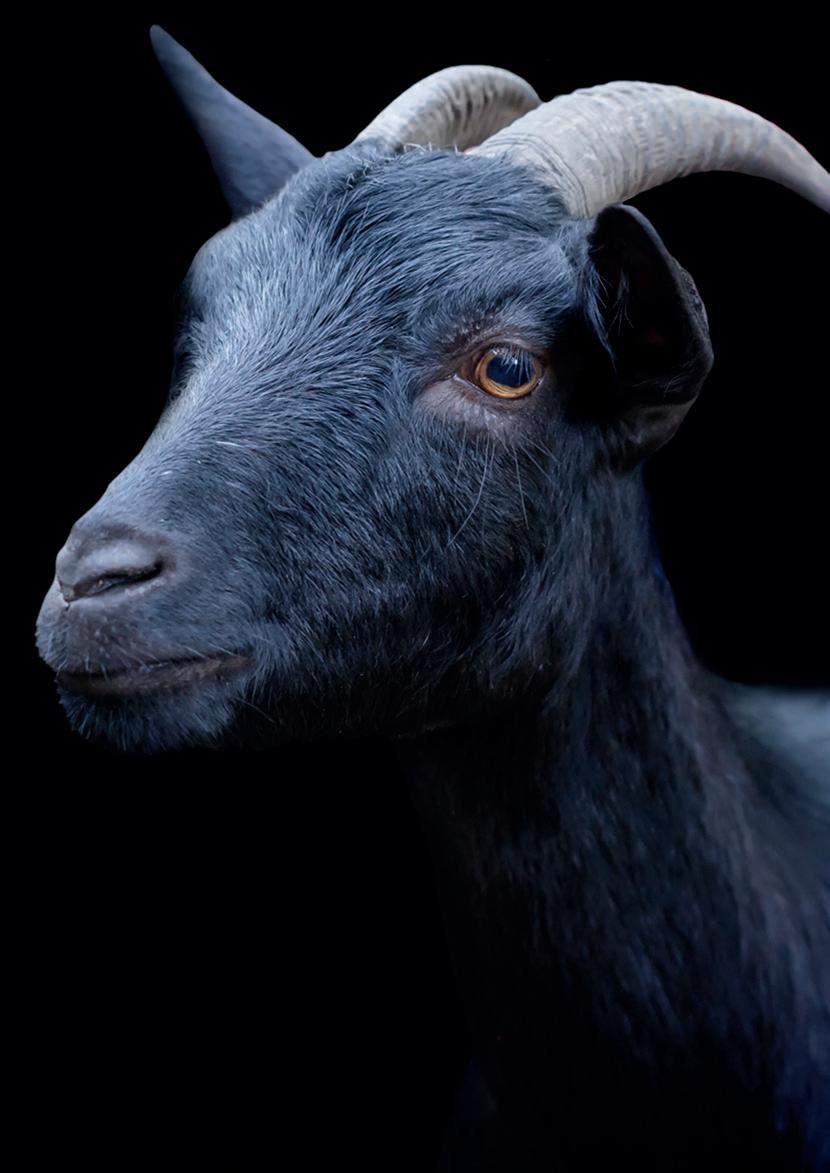
Ffermio Cymru • The Northern Isles




Beatha an Eilean
• Women in Agriculture
Book Serialisation • World Farming
Flavour of Scotland
including our regular news areas and columns

2023
October
Tuathanachas Alba

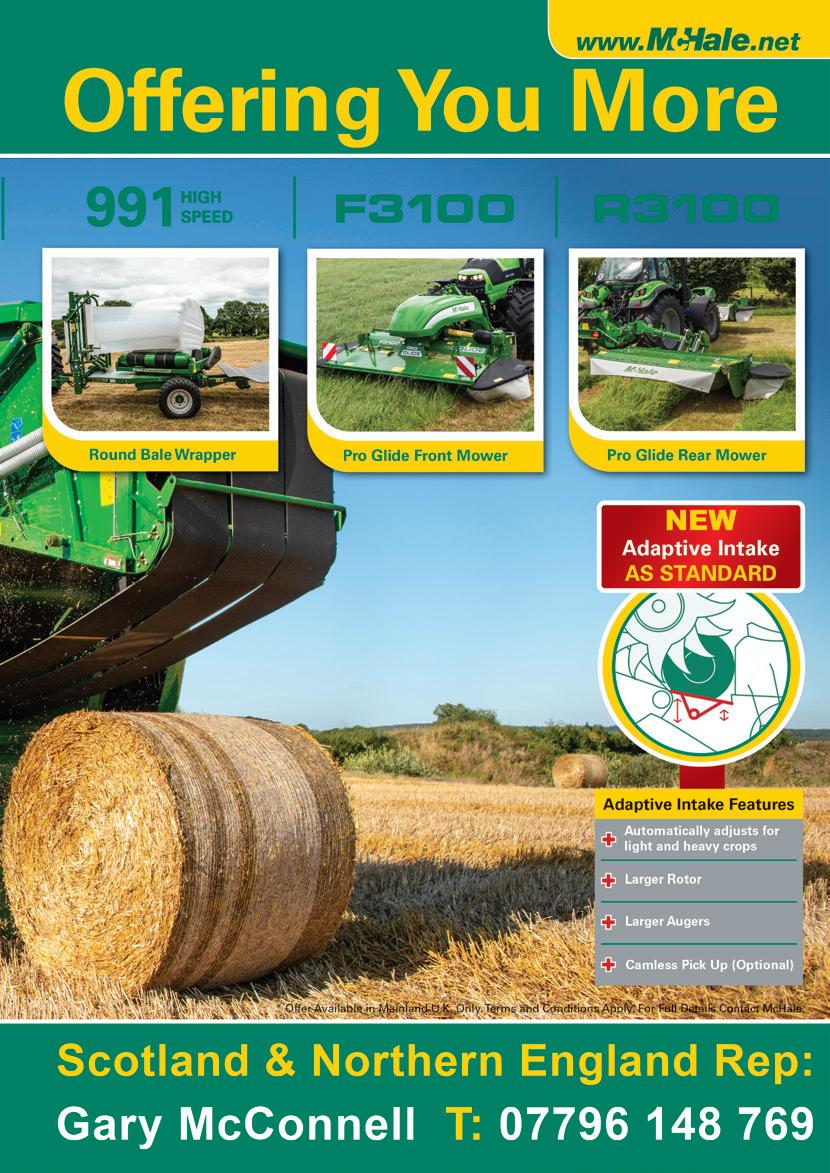








contents October 2023 All Editorial & PR enquiries EDITOR Athole Murray Fleming Tel. 01738 639747 E-mail: mail@farmingscotlandmagazine.com 13 COPYRIGHT This publication has been produced and published by ATHOLE DESIGN & PUBLISHING LTD who are the copyright owners. No reproduction, copying, image scanning, storing or recording of any part of this publication without the permission of ATHOLE DESIGN & PUBLISHING LTD. Contents disclaimer: FARMING SCOTLAND MAGAZINE is not responsible for any factual inaccuracies within press information supplied to us. Any concerns regarding such matters should be directed to the supplier of the materials. FARMING SCOTLAND MAGAZINE is designed, produced and published by Athole Design & Publishing Ltd., Tolastadh, 18 Corsie Drive, Kinnoull, Perth, Scotland PH2 7BU. Tel. 01738 639747 ISSN: 2041–918X ©ATHOLE DESIGN 2023 est 1994 COVER IMAGE: A goat! Features 14 Seeds & Seeding 17 Grain Dryers 25 Precision Farming 28 Combines 38 Ploughs 50 Muck Spreaders In Focus 34 Farmtrac’s green tractor for Forest Green F.C. Case study 36 ATV safety is paramount for hill farm contractor Advertorial 37 Advice from Wroot Water Articles 24 Redesign to regenerate 45 Bees waking up earlier 73 Profitability biodiversity Flavour of Scotland 13 Winning butcher World Farming 16 UN agricultural development Ffermio Cymru 32 Welsh Farming News Northern Isles 46 Stories from Orkney and Shetland Travel Scotland 48 Forays to Fort William Women in Agriculture 76 Inclusive farm giving disabled young people new opportunities Scottish Country Life 78 Iconic deer in the crosshairs Beatha an Eilean 80 Life on the Islands Book Serialisation 88 Part 5: “Regeneration”, The rescue of a wild land Farmhouse Kitchen 90 Wendy Barrie’s Gooseberry Ice Cream Artworks 92 ‘Furry Portraits’ by Hayley Russell News Areas 6 Arable & Root Crops 22 Renewable Energy 23 Science & Technology 56 Livestock 64 Dairy 67 Sheep 70 Environment 74 People 81 Estate 86 Forestry 93 Machinery 110 Finance 112 Events Columns 6 Editor’s Bit 10 James Hutton Institute 12 R.S.A.B.I 13 Scotland the Brand 32 Aberystwyth University 33 Welsh Government 57 Crofting 63 The Vet 65 Farm Advisory Service 69 NSA Scotland 72 Farming for the Climate 75 NFU Scotland 77 Southern Belle 79 Scottish Government 83 Conservation Matters 84 Scottish Land & Estates 87 Scottish Forestry 114 People on the Move 114 Book Review Subscriptions 109 Order your copy here. Next Issue Out in November. Featuring: AgriScot Preview, ATV’s, Diet Feeders, Farm Security, Milking & Dairy Equipment, Tagging & Recording, Look ahead to LAMMA 2024 and so much more. See our website for details. www.farmingscotlandmagazine. com Advertising & Editorial Enquiries Call 01738 639747 or email mail@farmingscotlandmagazine.com 22 45 74 92 facebook.com/FarmingScotlandMagazine All Advertising & Editorial enquiries ADVERTISING DIRECTOR Athole Murray Fleming Tel. 01738 639747 E-mail: mail@farmingscotlandmagazine.com ADVERTISING MANAGER Barry Tweed Tel. 01475 910153 Email: barry@farmingscotlandmagazine.com PRODUCTION DIRECTOR Christina Fleming Email: christina@atholedesign.com

editor's bit

C’mon the Bees!
I was recently reading an article written by a scientist who stated that if we lost all of our Bees overnight, human society would crash within 3 years.
The article was obviously pointing out one simple fact of life on earth, without pollination, crops will not grow and we will all die very quickly.
Nothing like a good-news story eh?
In other words, nature is the boss not us, and we need to respect it and nurture it, not pump it full of chemicals, pesticides, human and nuclear waste.
We human apes have been on this planet for only a few minutes of its’ history, and already we have turned the entire globe into one giant teenage boys’ bedroom of waste and smelly socks!
The time to stop messing about has gone and we have to clean up our act if we want to live on the only planet we have.
Agriculture has a huge roll to play in protecting our soil, wildlife and little buzzy things that help grow our food.
Lab steaks anyone? – no thanks!
So measures like forestation and hedgerows are to be welcomed, as long as the forests are spaced out naturally and not packed into tight rows as I have recently seen – good for carbon capture but total useless for native wildlife and our pollinating friends.
So, c’mon the Bees, aye, and even the wasps!
Slàinte, Athole
Back to basics: crop rotations key to soil group success
Crop rotations have proved critical to improving soil structure and reducing weed burden for five northeast farmers, who have come to the end of a five-year knowledge exchange programme, looking at enhancing farm soils.

The Soil Regenerative Agriculture Group (SRAG) was launched in 2019 by the Farming For a Better Climate (FFBC) team, part of SAC Consulting, and brought together five farmers to explore a range of management techniques, treatments, crops, and rotations, to help build soil resilience.
The group, which consisted of Ross Mitchell, Douglas Ruxton, Ben Barron, James Hopkinson, and Hugh Black, focused their work around five core themes: minimising soil disturbance; providing constant soil cover; keeping a living root in the soil; integrating livestock and maximising crop diversity.
Although all five are at different stages in their regenerative farming journey, they all agreed that getting ‘back to the basics’ and focusing on good crop rotations was key to improving soil health and managing grass weeds.
Soft fruit grower Ross Mitchell, of Castleton Farm, in Aberdeenshire, joined SRAG at the beginning of his venture into regenerative farming.
“We decided five years ago to transition into the regenerative space and joining the group really aided our progression on that journey,” Ross explained. “A lot of people think it is about a machinery change policy or deciding not to plough, but really it is a mindset change.
“We have explored the five principles of regenerative farming as part of this process, we introduced a wider rotation mainly to help control grass weeds, introducing legumes as
a break crop, mainly beans and some peas, which has added much needed diversity into the rotation. We also have embraced no-till and cover crops, which is helping with the structure of the soil, has reduced compaction and by not disturbing the soil, we are continually reducing our weed burden.
“We wouldn’t be doing this system if it wasn’t financially viable, it must stand on its own two feet and with the cost of fuel and machinery going up, we have found this is a far more resilient way of farming that reduces our inputs and costs.”
Cereal grower James Hopkinson, of Lindertis and Walker-Munro Farms in Angus, was already three years into his regenerative farming journey when he joined the group and his focus has been on improving soil health and reducing costs and tillage.
“It has been a really great process to go through as a group, as we are all trying to achieve similar goals but there is no blueprint which works for everyone,” said James.
“We are using every tool possible and pick drills and level of tillage appropriate to different parts of the farm, but the holy grail for us is direct drilling with a disc and we have had good results with certain crops in the autumn.
“We have been trying to find a balance in our rotation and we now split 50:50 between winter and spring crops, which allows us to better manage our weeds. Introducing new break crops such as beans have a big role to play in this along with growing and grazing over wintered cover crops. This aids soil restructuring, which helps us progress towards our ambition to use more root and less tillage in our system. We have also introduced legumes crops such as combinable beans and clovers and vetch in our covers to help increase fertility and nitrogen cycling and provide that all important feed for grazing livestock from November to March along with grazing early drilled winter crops such as wheat, oats and barley.”
www.farmingscotlandmagazine.com arable & root crops
6
Sugar beet crops are coming under intense disease pressure, with conditions for rust infection now proving the greatest concern for growers and agronomists.
Protecting green leaf area in the coming weeks will be crucial to enable plants to build yieldparticularly after the challenge of late establishment, followed by effects of heat stress in June. Now the weather has turned unseasonably cool and wet for many areas.

Syngenta Technical Manager, Andy Cunningham, reported that recent weeks of cool and wet weather conditions have been especially favourable to the development of rust in sugar beet.
Outstanding rust results
In a similar high rust pressure last year, trials in Lincolnshire
Beet the rust threat
proved PRIORI Gold delivered 33% better control of the disease, compared to mefentrifluconazole + fluxapyroxad. The two spray PRIORI Gold programme in August reduced the leaf area infected from over 85% of the crop in untreated plots, to less than 20%.
As a result, yields from PRIORI Gold treated beet achieved an average 87 t/ha, compared to less than 75 t/ha in untreated and only 83 t/ha with either mefentrifluconazole + fluxapyroxad or fluopyram + prothioconazole applications.
Furthermore, with a higher sugar content in PRIORI Gold treated roots, the two-spray programme returned more than £680 per hectare additional margin over untreated, compared to just £312/ha or £260/ha return with the other fungicide options
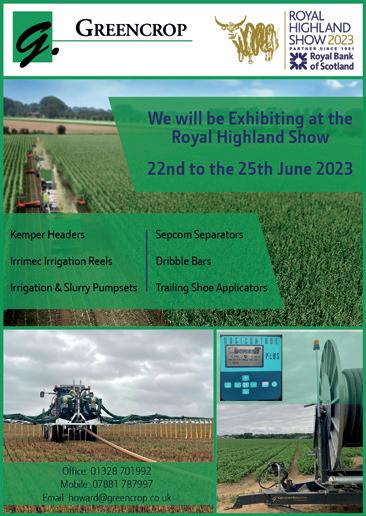
respectively that were more expensive and lower performing.
“PRORI Gold was clearly the best product for controlling rust in the trial,” reported Andy. “But other trials have repeatedly demonstrated its outstanding broad-spectrum effects on other beet diseases, including Ramularia, powdery mildew and Cercospora too.”
Cercospora risks low
“This summer’s relatively cool conditions have been far less conducive to Cercospora, which is favoured by hot and humid conditions - in excess of 24ºC and 10 to 15 hours a day at 90% plus humidity,” highlighted Andy. The BBRO Cercospora disease model currently predicts low risk to crops across most of the beet area.

arable & root crops www.farmingscotlandmagazine.com 7
GIG to celebrate two impressive milestones at British Potato 23
One of the UK’s leading manufacturers of packaging machinery will celebrate two significant milestones at this year’s British Potato Show.
GIC, which supplies Vertical Form Fill and Seal packaging machines, will mark 30 years of producing intermittent VFFS machines and 20 years of manufacturing continuous motion machines when it attends the November event.

“This year’s British Potato Show coincides with two very special milestones for us, and we’re looking forward to celebrating them in Harrogate in November,” says Andy Beal, GIC’s managing director. “GIC made its first-ever vertical form fill and seal machine in the summer of 1993. It was branded the VFB. Ten years later, we

introduced our first continuous motion machine - a VFB8000. The design of both machines has changed considerably over the years, but our focus on manufacturing high-quality machines that offer efficiency, longevity and reliability has not wavered.”
Today GIC offers a range of three intermittent machines - the GIC2100, GIC4100 and GIC5000 - and four continuous motion machines - the GIC3000, GIC3100, GIC8000 and GIC8100. GIC also offers two versions of its compact packer –the GIC CUB and CUB HC for high-care environments.
The company’s latest GIC8000 will be taking centre stage on Stand 230 in Hall 2 at the Yorkshire Event Centre from 23 November.
Support tuber bulking with foliar nutrition applications
Following a delayed start to the planting season, growers are encouraged to apply foliar nutrients to give potatoes a valuable boost during the critical tuber bulking phase.
Chris Bond, product manager at FMC, explains that the tuber bulking period, is an important stage in a potato crop’s growth cycle and has the potential to influence yield, so potatoes will
benefit from having an enhanced dose of nutrients.
“During tuber bulking, potatoes have a high energy requirement as they bulk up and expand,” he says.
“However, the early part of the year was characterised by wet and cold conditions which meant many growers had to delay planting.
“Leaching of nutrients from soils is more common following
www.farmingscotlandmagazine.com 8 arable & root crops
poor weather, so crops could be struggling to source enough nutrients from the soil.”
Mr Bond therefore recommends growers apply potassium, magnesium, and phosphorus to potato crops, through a foliar application, to support crop development during tuber bulking.
“Potassium is an important nutrient for potatoes throughout the growing season. It’s essential for starch production and promoting transport of sugars from the leaves to the tuber.
“Magnesium impacts a whole host of processes, but crucially it supports the leaf canopy and plays a vital role in photosynthesis.
“Phosphate is important for root development and high energy-based processes which are essential for bulking,” he says.
Mr Bond explains that there are lots of options when it comes to foliar applications of these important nutrients.
“To give crops an instantly accessible boost of potassium, growers can apply KuruS®, which is easily tank mixed and can be applied earlier in the season at tuber initiation, but most importantly during tuber bulking.
“Growers can also apply Hi-Phos®, a liquid formulation containing phosphorus, potassium and magnesium, during tuber bulking. This product can be tank mixed and provides rapid delivery of nutrients to potatoes.
“Tuber bulking is an incredibly important growth stage for potatoes so providing crops with an accurate and tailored supply of foliar nutrients will be beneficial,” he says.


Honesty® is the best policy when it comes to pre-planting potato treatment
Honesty®, the new liquid tuber treatment from BASF is approved for use on all potato crops and provides strong broad spectrum disease control.
Luke Pollard (BASF Campaign Manager Speciality Crops) said, “Honesty contains Xemium (fluxapyroxad) an SDHI fungicide which has the potential to be a real game
changer for the potato industry as it delivers the best reduction of Rhizoctonia, silver scurf and black dot, and has incidental activity against dry rot, gangrene and more.”
Even at low levels of infection Rhizoctonia can have a significant impact on yield, with direct losses, by weight, of up to 30% reported and not

www.farmingscotlandmagazine.com 9 arable & root crops
Low-tech sludge solution for reducing antimicrobial resistance
arable & root crops
only that, Rhizoctonia also affects the marketability of the crop. Silver scurf and black dot, blemish diseases, are together estimated to cause annual losses in the region of £5 million to the industry according to Fera Science Ltd.
Mr Pollard said, “We’re really excited about Honesty because not only does it give comprehensive disease control it also brings additional physiological benefits to the crop giving more even stolon initiation which results in even, good looking potatoes and so more marketable grade out.”
Ease of application
those applying the product and growers can readily see the fungicide coverage which is hugely beneficial. An application of Honesty also assists in the drying of tubers.”
Honesty®’s label flexibility
Paul Overton, Independent Agronomist said, “I really like Honesty’s label because it does give me flexibility. I am able to treat seed for seed, for ware and for processing and that, together with the fact that tuber application is not tied to planting date makes it very adaptable.”
A low-tech solution to help farmers make more money from their muck could also help reduce the spread of antibiotic resistance from sewage and manure, according to scientists at The James Hutton Institute in Aberdeen and Centre for Environmental Health and Engineering (CEHE) in Surrey.
Adding conductive materials, such as biochar, to anaerobic digestors when processing sewage sludge and manure on farms has been proven to help boost biomethane production, which can then be sold.

But a review has now found that adding relatively low-cost additive materials like biochar to the process could also help reduce the prevalence of antimicrobial resistance genes (ARGs) by more than 90%.
Mac-Anthony Nnorom, an environmental health researcher at CEHE and PhD student at the Hutton, who led the review, says, “It’s a winwin, especially as there isn’t any other financial incentive for farmers to reduce ARGs in their muck. However, this approach should not be
seen as a panacea and more research is required.”
Review co-author and Hutton senior environmental microbiologist Dr Lisa Avery adds, “While it’s generally accepted that ARGs have been around since before antibiotics were discovered and arise naturally, their evolution has been exacerbated by the extent to which antibiotics are now used. As antibiotics are not fully digested by humans or animals, 30-90% of any one dose enters the environment through sewage and slurry.”
Antimicrobial resistance develops when germs like bacteria and fungi develop the ability to defeat the drugs designed to kill them. ARGs can pass between microorganisms, spreading resistance. It’s known that sewage sludge and animal manure contain significant levels of them and that these can then get into the wider environment, but treatment of sewage sludge and slurry to remove ARGs is not mandated.
The researchers’ review has been published in the Journal of Hazardous Materials
The James Hutton Institute is a world-leading scientific research organisation working to resolve global challenges in food, climate, energy and water security. The Institute works in partnership with people, organisations and governments to enhance sustainable environmental, social and economic development to deliver practical solutions for our shared future. www.hutton.ac.uk

Paul Goddard (BASF Business Development Manager for Speciality Crops) said, “Honesty is applied using a roller table at a rate of 0.2 l/t, with 0.05 l/t of application enhancer, available as an Honesty Potato Pack. Honesty gives excellent coverage, and the integral blue colouring solution ensures
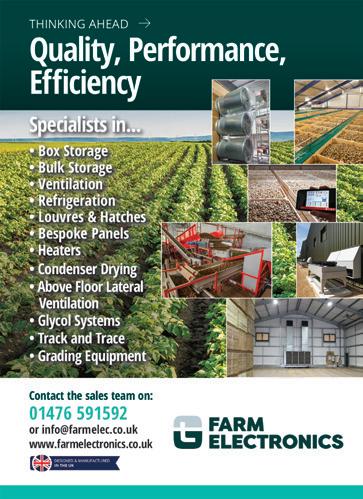
FARMING SCOTLAND
MAGAZINE
Next issue out November 2023
Subscription page 109
www.farmingscotlandmagazine.com
Haith to unveil drying and box tippling innovations at BP23
Haith has announced it is launching several new products at this year’s British Potato show.
Event sponsors Haith Group will unveil its new potato dryer and the latest version of its Queen’s Award-winning RotaTip at the November event.
Visitors to the Yorkshire Event Centre in Harrogate will be the first to find out about the Haith ProDry, which uses an innovative fan and belt system to speed up the drying time of potatoes. As well as being quicker than conventional sponge dryers, Haith’s new system eliminates any potential bacteria build-up which can occur in other drying systems.
Haith’s 2024 version of its market-leading Rota-Tip box tippler has been enhanced by introducing an in-feed and out-feed box stacking and destacking functionality, which speeds up the box emptying process and dramatically reduces forklift movements.
“We are really looking forward to British Potato Event,” says Rob Highfield, Haith Sales Manager. “We always have a great time in Harrogate meeting people from across the potato industry and giving them a warm

Yorkshire welcome to our stand.
“I think we will be busier than ever at this year’s show. Our new potato dryer and the 2024 version of the Rota-tip have been developed in response to customer feedback and so should attract a great deal of interest from people looking for the latest innovations in potato handling.”

Haith’s ProDry will complement the range of sponge roller dryers. The innovative solution conveys washed wet potatoes through a drying tunnel where a combination of fans dry the whole surface area of each tuber.
Haith’s Rota-Tip PRO gently empties potato boxes quickly and reliably, even in harsh conditions. As the tippler is rotated around a centre pivot, the weight of the box is never lifted, and the machine is not put under pressure, which eliminates fatigue or prevents damage to both the machine and the box.
The absence of hydraulics also removes the chance of oil contamination, and as Haith only uses high-efficiency motors, which only run during the tipping sequence, the Rota-Tip offers exceptional power consumption.
arable & root crops www.farmingscotlandmagazine.com
The additional box handling functionality allows the operator to place multiple stacks of full boxes into the machine which are then automatically de-stacked and transported to the tipping module. After being emptied, the boxes are then re-stacked for the operator to remove from the line. The advanced system significantly improves efficiency and a reduction in damaged boxes.
Yara ramps up investment in digital and tech solutions
Yara is expanding its Crop Nutrition Services offering by further investment in digital and technical solutions to support growers. The company’s recent investment in their Customer Portal allows liquid fertiliser customers 24/7 access to their Yara account. Via the portal customers can view and print invoices, see their deliveries, orders and order histories. In addition, and most importantly for liquid customers, they will be able to create their own call-offs from open orders.
Why does this matter?
Darren Glegg, Business Manager at Yara explains, “When growers are ordering what they need for spring applications, they might order 200m³ of liquid but only have the storage capacity for 6080m³. With the new Customer Portal, growers can look at what balance they have left, hit the ‘call off’ button and request a delivery of a specific quantity on a specific date.” This feature has benefits for larger farms with multiple sites and tanks in different locations too as they will now be able to call off deliveries by location.
RSABI Survey Provides Insights to Young Farmers’ Mental Health
A survey of young farmers undertaken by Scottish agricultural charity RSABI at this year’s Royal Highland Show has highlighted many of the factors affecting the mental health of young people in agriculture.
114 young people in agriculture aged 16 to 30 took part in the survey which revealed that the biggest challenges to their mental health were; long work hours (30%), reluctance to talk about their feelings (18%), isolated location (16%), the cost of going out (15%) and shyness (11%).
The importance of socialising events and shows shone through, with 98% of respondents rating attending the Royal Highland Show as important for their mental health.

RSABI provides free counselling to people in Scottish agriculture struggling with their mental health, which is simple to arrange and can be accessed very quickly. However only 36% of young farmers surveyed were aware of this service.

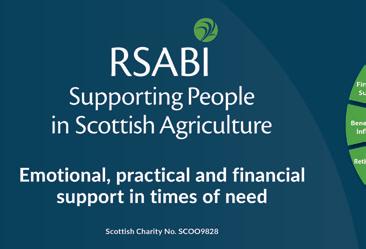
“Having the RSABI stand located at the SAYFC centre at this year’s Royal Highland Show created the ideal opportunity to survey young farmers. The fact we were sharing our location with Andy and Lynda Eadon, who lost their son Len to suicide last year, also highlighted the need to focus on better understanding young farmers’ mental health,” said Carol McLaren, Chief Executive of RSABI.
Ms McLaren added: “We are encouraging people not to hesitate to reach out to RSABI but everyone in the agricultural community can play an important part in encouraging positive mental health by actively looking out for people who might be at risk of feeling lonely or low. Just contacting
someone could be all it takes to save a life.”
RSABI’s confidential freephone Helpline - 0808 1234 555 - is available 24/7 and calls won’t show up on phone bills. You can also reach RSABI via the webchat function on its website www. rsabi.org.uk 24 hours a day.
For more information or to sign up to RSABI’s supporters’ scheme, please visit the RSABI website www.rsabi.org.uk.
RSABI’s Freephone Helpline – 0808 1234 555 – is open 24 hours a day, every day of the year and a 24-hour confidential webchat service is available at www.rsabi.org.uk.
12
Scotch butcher reflects on the ‘recipe for success’ after being named the UK Butcher’s Shop of the Year 2023
Scotland The Brand


From Carne Fraca to Free For All?
By Ruth Watson
When McCaskie’s Butchers and Café in Wemyss Bay was recently crowned the UK’s Best Butcher Shop, Nigel Ovens, Managing Director of the business and proud Scotch Butchers Club member, was overwhelmed with pride at being judged as the best in the business.

Now, having had time to reflect on the butcher’s latest award win, Nigel discusses McCaskie’s recipe for success.
He said: “It is just that – a recipe. As a business, we’re constantly striving to bring all of the key ingredients for success together, and to get them to work in perfect harmony, so we’re able to deliver the very best standards for our customers day-in-dayout.”
Nigel goes on to say: “There are a number of factors that have contributed to winning the award, like our attention to detail, innovation and uncompromising standards when it comes to the appearance of our shop, as well as our highly trained and customer-focused staff.
“However, the one we’re most proud of, and that is core to our success, is the quality of our product itself.”
McCaskie’s Butchers uses exclusively Scotch products, including quality assured Scotch Beef, Scotch Lamb and Specially Selected Pork.
Nigel said: “This is the most important thing to us, as it’s the high quality that our customers continue to pay and return for.
“The Scotch assured labelling on our products clearly demonstrate to our customers that they are receiving the highest quality available. They know that they can expect their purchase has been reared here in Scotland in a sustainable way and to some of the strictest welfare standards.”
An additional contributing factor to McCaskie’s success has also been its membership within the Scotch Butchers Club, a group for like-minded butchers committed to sourcing quality assured Scotch meat, which is audited by Quality Meat Scotland.
Nigel continued: “The Scotch Butchers Club has really helped us to establish the idea and high standards of Scotch quality assured meat that our customers recognise and have confidence in.
The UK Government has announced that beef and poultry meats from Brazil no longer need the enhanced testing or certification put in place after the Carne Fraca scandal. In 2017, the federal police investigation, ‘Operation Weak Flesh’ in English, exposed a nationwide fraud with food inspectors certifying rotten meat as fresh, laboratories falsifying test results, and politicians –including the president –accused of taking bribes to overlook criminal dealings. Over 400 notifications of Salmonella were reported from nations around the world, with 80% of the alerts coming from the EU. Tainted meat included produce contaminated with acids and cardboard.
According to Defra, Brazilian authorities have made ‘significant’ progress.
Auditors for Defra inspected a small number of facilities in Brazil and, while highlighting areas of hygiene, slaughterhouse practice, and food labelling which sound alarm bells for many, exports to the UK are resuming without enhanced checks.
I spoke to a Scottish farmer who, until Covid hit, was a frequent visitor to Brazil with an export and advisory service providing beef cattle semen, the ‘Rasa Britannica’ being highly sought after in the southern states. He asked for his name to be withheld but told me “The abattoir system causes me concerns. Animals coming out of deforested areas are retagged to hide their origins. I think the Defra advisers were being shown the facilities on a good day. If they didn’t even go into Amazonia, what were they looking at? It doesn’t sound like they were looking very hard.”
Food Standards Scotland has called for evidence from stakeholders in Scotland to inform a report they are producing for the UK Government’s Department for Business and Trade later this year.
Ruth Watson is the founder of the Keep Scotland the Brand campaign.
FLAVOUR OF SCOTLAND www.farmingscotlandmagazine.com 13
Vaderstad Proceed opens the future of seeding
Väderstad is introducing a new innovative seeding machinery category called Väderstad Proceed, where one single machine increases the yield potential of a full range of crops – such as wheat, barley, oilseed rape, sugar beet, peas, maize, sunflower.
“At Väderstad we build machines that keep our customers at the forefront of modern farming,” says the company’s senior vice president sales and marketing Mattias Hovnert. “We develop new methods and from time to time we set completely new standards. Proceed is one of those leaps that doesn’t happen often in the farm machinery industry, but when it does, it changes things.
“Väderstad Proceed can place the smallest of seed at the perfect depth with millimetre precision, enabling significant improvements in areas like yield levels, need for tillage, chemical treatment and use of fertilisers.”
Field trials show that Proceed can cut the wheat seed rate by half, while keeping the yield compared to modern seed drills. Importantly the crops are stronger and very even in all growth stages of the crop year.
“Proceed takes a huge leap from current seeding technology,” says Väderstad director product management at business development Lars Thylén. “It is outstanding in depth-precision, in-row precision, end-of-row precision, as well as seedbed optimization. The result is a quick, even emergence and vital crop population where each plant is provided conditions needed to reach full potential.”
Results from trials show that a few months after drilling winter wheat at a rate of 150seeds/ m2 gave an increase of 102% in plant biomass, 72% in root biomass and 62% more shoots
per plant, compared to a modern seed drill.
Highest precision for all crops
For drilling cereals Proceed has a row spacing of either 225 or 250mm. By an easy configuration and a quick change of seed discs the machine can switch to 450 or 500mm for crops such as sugar beet or oilseed rape, to then switch again to plant crops such as maize, sunflower or cotton at 750mm row spacing. All crops will be established with an outstanding precision, maximising the yield potential for each seed.
At the heart of Proceed are high-precision row units. Prior to seed placement, individual preseeding wheels consolidate the field to ensure same conditions for each seed. The pre-seeding wheels are individually mounted, using hydraulic down-force to ensure high performance.
“When the seeds reach the row units from the central hopper, an adaption of Väderstad PowerShoot takes full control of each single seed all the way down to the soil,” says Lars Thylén, director product management at business development.
“Leaving the short seed tube, each seed is received by a stop wheel. This ensures optimal seed-to-soil contact at selected depth all over the working width. This provides the driver with full control, each row unit is electrically driven and controlled via the iPadbased control system Väderstad E-Control,” he says.
“Functions include row-by-row shut-off and variable rate, dynamic tramlining, individual calibration, as well as real-time precision monitoring and control. All of which are true technical innovations in the cereal seeding sector.”
New Faunamaster seeders from BOSS ORV
BOSS ORV has been appointed as the sole UK distributor of Faunamaster Seeders. These are multifunctional and timesaving

seed drills designed for use with an ATV, UTV or tractor. The Faunamaster, which comes from the Danish company Faunaseeds
BV, sows seeds of virtually any size to a depth of up to 80mm. It is ideal for sowing into existing grass fields, wildflower meadows, tilled
www.farmingscotlandmagazine.com 14
SEEDS & SEEDING
soil, paddocks or any area where normal planter equipment is too big. It’s of great benefit in parks and gardens to plant flowers or herbs and the compact size when used with an ATV or UTV ensures it leaves minimum marks. The seeder handles seed in many sizes, from small flower seeds to clover, alfalfa, beans, kale and corn, and can apply fertiliser at the same time as seeding. A seed table shows the settings for each type of seed. On the seed meter, there are 2 funnels: the blue is for small seeds, the yellow is for big seeds like corn, and seed blends. The capacity of the seedbox is 45 litres and the fertiliser box is 40 litres.
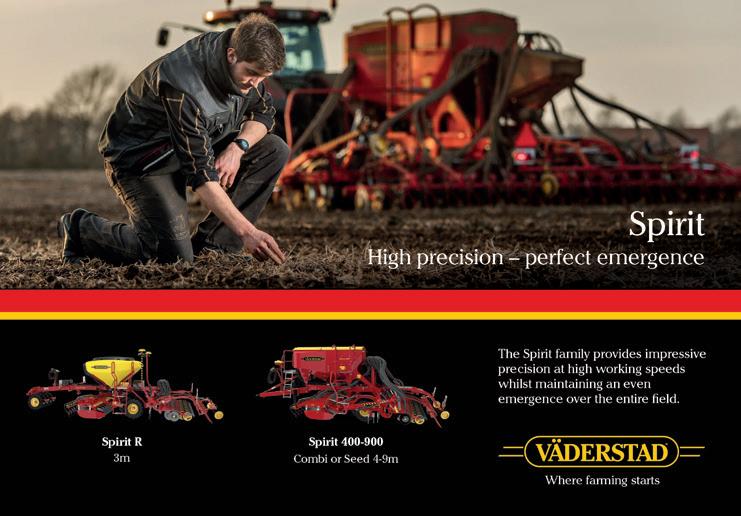
Connecting the Faunamaster to an ATV or UTV ball hitch is made easy and a built-in actuator allows the driver to operate the planter without getting off the ATV. When fully raised, the clearance is 200mm (7.87) inches and when used with an ATV, the seed flow is easily adjusted through the handlebars.
The Faunamaster uses discs to cut into soil and where it is used for no-till planting, the recommended depth is not exceeding 10mm (0.4in). Depth control is via two bolts located on the wheel arm. The working width is 1050mm (41.3in).
There are seven adjustable rows with the distance between them being 150mm in 7 rows, 350mm in 3 rows, 525mm in 2 rows. The Faunamaster weighs in at 260 kg and has a recommended working speed of 4-6 km/h. BOSS ORV, which is also the
UK distributor of Corvus OffRoad Vehicles, will sell the Faunamaster through specially appointed dealers and their own UK dealer network. It will be shown on the BOSS/Corvus stand at the Groundsfest show at Stoneleigh in September.

www.farmingscotlandmagazine.com 15
SEEDS & SEEDING
The UN’s agricultural development fund invests US $7.96 billion in poorest rural communities to grow the world’s food

In 2022, despite conflict, climate change and the continued stresses of the COVID-19 pandemic which threatened the food security and livelihoods of millions of rural people, the UN’s International Fund for Agricultural Development (IFAD) invested US$7.96 billion in rural areas in the world’s poorest countries, according to its annual report released today.
“2022 was a particularly challenging year for rural people the world over. Rural communities have acutely felt the effects of this triple crisis on their food systems, which are a critical source of livelihoods –as well as essential nourishment – for them, and for the millions of people who depend on them,” said IFAD President Alvaro Lario in the report foreword.
“We need to support rural people to cope with present crises. But we also need to invest in building food systems that can support and nourish their families and communities, and help feed the world into the future.”
The annual report captures the organisation’s activities, special initiatives and new funding sources as well as impact data. Analysis of the 2022 total rural development project portfolio reveals that 90% of core resources went to low-income countries (LICs) and lower middle-income countries (LMICS). IFAD has since committed to increase that ratio
to 100% going forward. Data verification also showed that more than 90% of IFAD’s climate finance is invested in initiatives that enable rural people to adapt to climate change. In addition, it showed that more than half of project participants are women.
In 2022, IFAD launched the Crisis Response Initiative to protect livelihoods and strengthen resilience in 22 countries most in need as a consequence of the war in Ukraine. It focuses on tailored interventions to prevent hunger and food insecurity arising, while supporting sustainable food systems.

In 2022, impact data reveals that between 2019-2021, as a result of IFAD’s investments: more than 77 million people increased their incomes; more than 62 million people expanded their productive capacities; more than 64 million people improved their market access and 38 million people strengthened their resilience. IFAD is the only international financial institution that systematically measures the impact of its investments.
Assessments of the Rural Poor Stimulus Facility - IFAD’s COVID-19 response initiative launched in 2020 to help people
survive pandemic-caused financial losses while protecting the global food supply - showed that at least three quarters of participants maintained or increased their levels of production and income, despite the impacts of the pandemic.
“Doing more to get more finance is critical; but we also have to continue to ensure that the people who need it most are the ones who benefit. This is another part of what makes IFAD unique, and we are maintaining our commitment to devote 100% of our core funding to the poorest countries,” wrote Lario.
www.farmingscotlandmagazine.com 16
WORLD FARMING
GRAIN DRYERS
What goes on in the grain drying world
Latest technology from Alvan Blanch to tackle inter-cropping (and wet) harvests


The Alvan Blanch name, and their iconic Double Flow Grain Dryer, has been synonymous for over 70 years for rescuing wet summers from Lothian to Tayside and across the world. But the unique dual-horizontalbed design has fallen into favour more than ever now –with the challenges faced by arable farmers who try to juggle optimising production, in the face of rising energy prices.
“If you can combine it, we can dry it” announces Roger Wilkinson proudly, “Your harvest is no longer held ransom by the weather”. As the Area Sales Manager at Alvan Blanch, and having spent the past 10 years installing AB and SOBY equipment on farms across the region, he knows from experience that farmers cannot rely on the Scottish sunshine. A once-in-alifetime investment in a Blanch drying and grading system is as
www.farmingscotlandmagazine.com 17 GRAIN DRYERS
GRAIN DRYERS
good an insurance policy as any to guarantee their crop for secure storage.
With inter-cropping and more sustainable agricultural techniques growing in momentum, farm accountants are evaluating payback on investments, such as grain drying, cleaning, and handling equipment, over upcoming years which look more changeable than we have seen since our
predecessors, farming for freedom in the 1940s.
Alvan Blanch have continued to innovate, upgrading their bestselling grain dryer to become the world’s most fuel-efficient grain drying system, with heat recovery, insulation, and live moisture analysis. The cropfollow-on feature allows for continuous operation; uniquely ensuring no down time between crops – essential for those
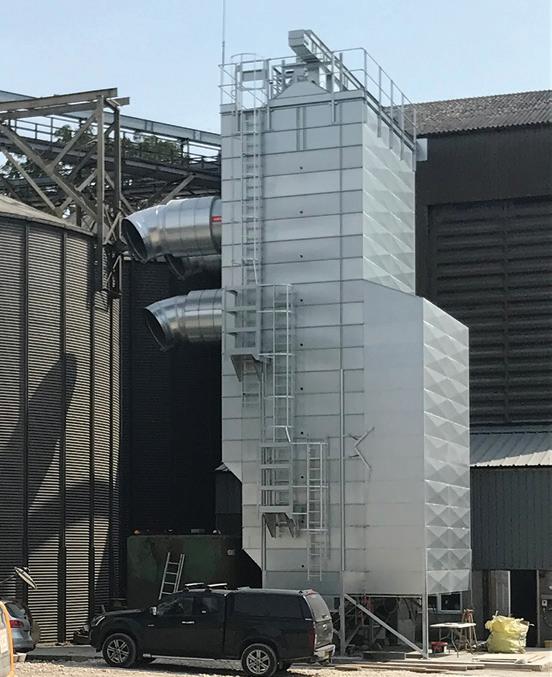
moving to a more varied mix of arable. All of this can be viewed and controlled from the comfort of your hand, with remote monitoring, offering improved control and most importantly, peace of mind.
What allows this 3rd generation family-owned business to lead in grain handling both in UK and worldwide is that they design for the future – with ability to handle mixed crops such as “boats”
(beans and oats mix), which can be dried together, stored, and then graded through their rotary screen cleaner – all handled robustly via SOBY handling (Denmark’s fastest-growing conveyor and elevator manufacturer – more heavy-duty, and more flexible than other brands on the market).
For more details on Drying, Cleaning, Handling & Feed Milling equipment from AB, contact info@alvanblanch.co.uk
Good advice from BDC Systems for 2024 harvest
Prior planning prevents poor (harvest ’24) performance, says John Wilson, BDC Systems Ltd’s regional manager for Scotland and Northern England
Now is the time to look at whether your existing grain drying facilities successfully coped with this harvest’s wet grain.
It is never too early to start planning for harvest ’24‘prior planning prevents poor performance’.
Early in your planning process you should talk to a grain handling, drying and storage specialist with a proven track record of successfully delivering solutions for farm enterprises of all sizes.
A specialist who is able to share their knowledge and expertise to guide you through the range of available options making sure that you have a future proofed solution that meets your individual needs.
“The BDC team is able to work collaboratively with our customers, drawing on its extensive knowledge and experience across the postharvest equipment sector,” said Wilson.
The industry leading Svegma continuous flow drier, with almost 1,000 UK installations, has long since been the drier of choice for BDC customers. Importantly, the team can provide advice on the size of Svgema required based on
www.farmingscotlandmagazine.com 18
throughput capacity and drying temperatures of crops to be dried.
“It is important to remember that, despite advice others may provide, one size does not fit all!” added Wilson.
The Svegma’s improved energy efficiency allows the drying of crops via invertercontrolled fans. Improved fuel usage via automated burners using alternative fuels including HV02 vegetable oils or cleaner fuels such as Kerosene oil, can also be achieved.
“We have continued to develop the Svegma control system technology allowing remote access of the drier’s PLC from BDC Systems’ Moisture Monitoring System (MMS),” added Wilson.
Remote access from any location, including the combine, eliminates the need for on-site monitoring of the drier, saving on costly labour.
“Once dried and in storage, aeration fans controlled by
wireless probes, and extraction fans from BDC Systems help to maintain the correct temperature
so that grain is kept in the best condition to achieve premium prices,” concluded Wilson.
For more info call John Wilson: 07468 698188 or visit: https://bdcsystems.com
The OPICO range of grain dryers

Speed and efficiency are key features of the OPICO range of recirculating batch dryers, with automated features allowing farmers to keep pace with harvest and larger capacity combines, whilst reducing the time needed to manage the dryer.
Available as gas or diesel fuelled models and with 3 phase or PTO drive these selfcontained units constantly recirculate the grain to ensure thorough, consistent and economical drying. Loading time and unloading time are also minimised with high capacity loading augers, recirculating
augers and unloading augers to keep grain flowing.
The diesel fuelled Magna range offer high volume, with the largest having a holding capacity of 48t, drying up to 480 tons of grain per day on automatic versions. Unique to the Magna range is the Duax heat core – heat retaining bricks that ensure a more even and consistent drying temperature with the added benefit of saving up to 10% on diesel costs.
The gas fuelled GT range of dryers provide clean, cost effective, controllable heat. Liquid propane is vaporised
in the dryer and burnt in a ring burner to achieve high temperatures and an even safe heat.
Both gas and diesel fuelled dryers can be specified for fully automated operation. These models load, dry, cool and unload automatically, giving unattended drying hour after hour, seven days a week and require minimal labour allowing more efficient use of farm resources.
Some summers, where the UK has seen extreme heat, controlling the temperature of grain has been a key consideration for some. OPICO
www.farmingscotlandmagazine.com 19 GRAIN DRYERS
GRAIN DRYERS
dryers have been used to blow ambient cooler air through the grain to prevent over-heating.
Furthermore, the action of a recirculating batch dryer cleans and polishes the grain whilst also removing chaff, weed seeds and broken grains. Resulting in higher hectolitre weights and in turn the value of the crop; giving an advantage over on-floor stores or continuous flow systems. A Sky Vac dust extractor can be added for even more impressive results.
The lower capital investment needed already makes an OPICO dryer an attractive purchase. Recent improvements to extend working life include galvanized or stainless steel components in areas that are susceptible to corrosion will help reduce ownership costs and result in a higher residual value.
2023 saw the introduction of the smart control panel, fitted to the latest Magna diesel grain dryers, which allows greater connectivity and remote control of the dryer via
a smartphone, tablet or PC for real time monitoring dryer operation and adjustment of settings as required.
Easy to install and relocate, when necessary, OPICO recirculating mobile batch grain dryers start from £55,970

for the gas fuelled range (GT 395QF) and from £50,815 for the diesel fuelled range (Magna 120 Eco).
East Coast Viners (Drumlithie) Ltd Sets New Standard with Automated Grain Drying
East Coast Viners Grain, a key player in the animal nutrition and grain sector, has achieved a significant milestone by becoming Scotland’s first company to adopt the cutting-edge benefits of a fully automated Tornum grain dryer.
Operating from Stonehaven, this family owned feed milling business has rooted itself in grain cultivation and drying, further strengthened by strategic collaborations with local farms. Their portfolio features a diverse array of compound and blended feeds.
Demonstrating their dedication to innovation, they’ve recently introduced a Tornum TK8-24 grain dryer. This continuous flow dryer is enhanced by the Intelligent Dryer Control system. Going beyond operational optimisation, this intelligent software effectively reduces energy consumption and labour expenses in grain

management. This initiative doesn’t end at drying; Tornum’s partnership with Skandia Elevator has led to the seamless integration of new elevators and conveyors.
Charles White, from Tornum Ltd, the UK arm of the Tornum Group, highlighted the benefits of the Intelligent Dryer Control system: “East Coast Viners came to us looking for a model which could utilise their biomass radiators, reduce over drying and subsequent input costs, all with the aim of lowering their carbon footprint.”
The new dryer also features a distinctive aesthetic aspect: 10 front-mounted Clean Air Control (CAC) fans to maximise the airflow through the drier to increase the drier capacity and reduce back pressures created by the radiators. While dust collection remains atypical in standard dryers, the TK8-24 Tornum dryer, with its CAC fans, effectively eliminates
up to 95% of generated grain dust and chaff. Simultaneously, it optimises airflow to enhance radiator efficiency.
While the dryer’s primary focus is barley, malting barley, wheat, and rapeseed, its versatility extends to oats, peas, and beans.
www.farmingscotlandmagazine.com 20
FARMING SCOTLAND MAGAZINE Next issue out November 2023 Subscription page 109
Flow grain driers from Perry of Oakley
British company Perry of Oakley Ltd design & manufacture two ranges of continuous flow grain driers with capacities from 5tph to 150+tph on wheat, and also supply the AGREX range of mobile driers.

The entry level, Mistral series continuous flow grain driers (5 to 30 tph) come with roller discharge as standard but can be upgraded to pneumatic shutter discharge. It also has a hard-wired control panel which can be upgraded to a Perry touch screen PLC with remote access for diagnostics and adjustments.
The larger Savannah series continuous flow grain driers (5 to 150+tph) are heavy duty commercial specification driers that come with pneumatic shutter discharge and PLC touch screen control panel as standard.
The Mistral & Savannah series can utilise a wide range
of fuel options including diesel, kerosene, gas, steam, coal using heat-exchangers or biomass heat sources.
Both ranges can be fitted with the Perry Grain Sentry Fire Detection and Automatic Moisture Measurement ensuring optimal drying conditions are achieved and any fires are detected as quickly as possible.
Centrikleens are also available on both ranges to reduce dust & chaff problems.
Perry of Oakley now also supply the AGREX mobile batch drier with models from 7T to 42T, which utilise a variety of fuel options including diesel, kerosene or gas-fired. PTO is also available for the smaller sized driers.
All the drier ranges are fully supported from the Perry UK based factory which also houses an array of spares.
All three drier ranges are fully compatible with the comprehensive range of Perry handling and storage options from tote bins through to hopper-bottom and flat-bottom silos.
Contact Perrys for all your handling, storage & drier requirements on (0)1404 890 300 or email sales@perryofoakley. co.uk, and receive a free, no obligation quotation.

www.farmingscotlandmagazine.com 21 GRAIN DRYERS
Calibrate scoops another renewables award for farming client… Renewables business is making net zero a reality for agri-businesses

Calibrate Energy Engineering, part of RSK Group, has scooped a prestigious award for the third time in the ACR & Heat Pump Awards in the category of Non-Domestic Heat Pump Project. This is the fourth year that the company has received an accolade in this industryrenowned awards.
Calibrate design, install and maintain commercial renewable technologies, and are specialists in the agri-sector. On this occasion, they worked with their farming client to re-engineer an old and underperforming system installed by a third party and re-imagined it back to peak performance, saving hundreds of thousands of pounds on energy bills.
Calibrate worked with the client, a poultry stronghold of 300,000 broilers with a significant 10-year contract supplying a major supermarket chain, to
bring the business’s heat pump back to its former glory. With a high reliance on on-demand and consistent heat for the chickens, to safeguard and future-proof the enterprise, the client needed to get the technology back to peak performance. Calibrate stepped in to show how their bespoke software platform, could evaluate how energy costs and carbon could be slashed through an investment in engineering works that were projected to save £117,000 per year.
Calibrate were increasingly seeing cases of older heat pumps and owners who were struggling to get the benefits due to antiquated and often unmaintained systems. The innovation of this re-works project lay in Calibrate’s own intelligent bespoke controller (Calibrate Analyser), which also found a place in the ACR finals. Like a domestic Hive controller
but on a larger scale, this tool allows remote access and energy monitoring ensuring the highest energy efficiencies are obtained reducing costs and carbon emissions and can also simulate savings and benefits of future renewable projects such as solar, wind and hydrogen.
Commenting on the win, Susie McDonald Co-founder of Calibrate said: “We are thrilled to have been recognised yet again at these awards, especially as they are very specific to our industry and recognise the highest level of knowledge and expertise.

“As a pioneering business in the industry, visibility like this helps us to get closer to our vision of making net zero a reality for businesses through innovative technologies.”
Presenting the award on the night were Stephen Bielby from the Ground Source Heat Pump
Association and comedian, Rod Woodward. Accepting the award on behalf of Calibrate was Emma Tandy, Marketing Manager who added: “We were against some strong competition in the industry, so it was a great honour to be a winner again. With energy costs as they are, our aim is to help companies to implement solutions to reduce their energy costs and positively impact on the environment to secure a more sustainable and profitable future for their business. We are so pleased as this accolade recognises that vision.”
Calibrate continues to focus on helping high energy-use businesses, and to date Calibrate have installed 300MW of heat pumps and renewables to high energy-use businesses, whilst preventing the release of tens of thousands of tonnes (and counting) of carbon into the atmosphere.
renewable energy
www.farmingscotlandmagazine.com 22
science & technology
myFIELD digital aid to your in-field agronomy decisions
The new Syngenta myFIELD app now provides growers with instant access to crop specific weather information and agronomy decision support tools in a single easy to use digital platform that can be tailored to each individual field.
myFIELD includes major developments to Syngenta’s highly popular BlightCast for potato growers and the Quantis Heat Stress Alert forecasting tool, designed to better time biostimulant applications in potatoes, sugar beet and maize crops.
Growers and agronomists can download and customise the free myFIELD for android and iOS phone, reported the system’s developer, Ed Flint.
“Simply downloading and registering MyFIELD will open

access to detailed local weather information and warning risks selected to aid agronomy decisions,” he advocated. “By adding in individual fields or cropping blocks, using the integrated Google maps tool, all the information received will be tailored precisely to the specific location and crops.”
Potato growers and agronomists, for example, can receive the latest BlightCast information that gives up to 14 days warning of conditions conducive to disease infection and development. The system helps growers to fine-tune in season blight protection strategies to specific pressures.
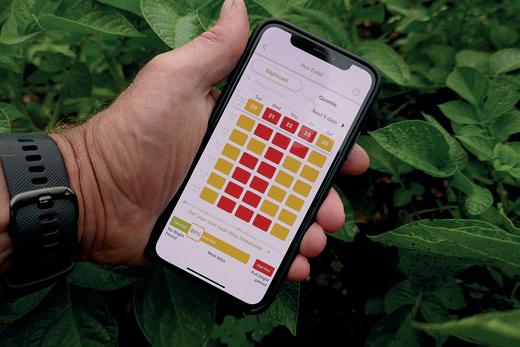
New for the 2023 season, the BlightCast App now enables users to personalise the parameters that trigger a near
miss threshold, to tailor the system’s sensitivity to specific situations and their own risk requirements; the full Hutton period warning remains fixed at nationally recognised humidity and temperature conditions.
“Risks are clearly defined with an easy to interpret green, amber or red alerts, to aid growers’ decision making,” added Ed.
The Quantis Heat Stress Alert tool notifies when heat events are forecast to trigger set parameters when crops suffer – in time to take action with preventative applications. Quantis application prior to heat events in potatoes, sugar beet and maize has consistently proven to protect crops from adverse effects and provide long-lasting resilience to recover faster
In addition to the live onscreen updates, growers and agronomists can elect to receive email alerts of impending blight risk or impending heat event periods.
“Both BlightCast and Quantis Heat Stress Alert should be used in conjunction with Syngenta Spray Assist, to ensure optimum timing and application techniques to the prevailing weather conditions and assure crops are protected,” advised Ed.
Further Syngenta digital agronomy decision support tools for all crops will be added into the myFIELD App later this season and in future years. Growers and agronomists only need complete their registration details and field plans once, to be available for a tailored agronomy plan in future seasons.
www.farmingscotlandmagazine.com 23
Redesign to Regenerate
By Joel Williams, Soil
Health Educator
The principles of redesigning agricultural systems to regenerate soils, biodiversity and the bottom line are the same no matter where you are in the world. It is how we interpret and apply them which changes, and this is what Groundswell is all about – exploring the nuances of regenerative approaches across the diverse landscapes of the UK.
While I’ll be joining an incredible line up of experts and experienced farmers to delve deep into the detail, my sessions‘First principles’ at Groundswell Festival in Hertfordshire and ‘Redesign to Regenerate’ at Groundswell Outreach (GO) Falkland in Scotland - will lay a foundation.
Diversity will be a key theme, and with examples at both the field and landscape levels, we’ll discover how diversity of plant species is key, as seen by the multi-faceted role our ecological infrastructure - the flower strips, trees, shrubs and hedgerowsplay in the ecosystem, and how we can harness their benefits as well as enhance plant diversity within production systems.
We will look at how plant diversity dilutes food sources for pests and diseases, enabling us to reduce our dependence on crop protection products. And how, through the variation in rooting depths and habits, plant diversity can lower the need for fertilisers.
Below ground, plant diversity has been shown to
stimulate soil biology and improve soil structure, further improving nutrient cycling. With intercropping and diverse pastures, as well as buffer strips and ecological infrastructure being viable options, plant diversity becomes a central tool of redesigning our farming systems.
At Groundswell, I’ll be taking the conversation further in two integrated pest and disease management (IPDM) sessions. The first will focus on designing with diversity where we will talk about how an IPDM program makes other in-field strategies more likely to succeed. The second session will move onto the microbiome and highlight how beneficials that live around, on or in plants can either directly antagonise pests and disease or induce the production of defence chemicals within the plant.
In Scotland, I’ll be discussing how we conceptualise ‘helping farming systems’, redesigning them and moving towards something more sustainable. As a result, the session at GO Falkland will also talk about the subtleties of philosophy around transition.
For example, is a ‘leap’ better than a ‘step’ when moving towards a regenerative approach? We’ll compare the advantages and disadvantages of incremental versus transformative change, bringing conscious thought to contributing factors whether that’s financial pressure, capacity
to take risks or desired speed of change.
Whichever is right for you and your farm, remember regenerative agriculture, is still an emerging concept and it takes an open mind, initiative and a certain amount of resilience to reimagine a landscape and its farms.
I hope you’ll join me at either or both Groundswell Festival and GO Falkland this year. Certainly, I’m looking forward
to stimulating and steering rich and meaningful conversations around the specific challenges and opportunities that originate from this beautiful landscape.
Joel Williams is a soil health educator, rethinking soils through a lens of biology. He provides lectures, workshops and consultation on soil management, plant nutrition and integrated approaches of sustainable food production.

www.farmingscotlandmagazine.com 24
ARTICLE Find out more at https://integratedsoils.com.
Intelligent nozzle selection helps in retaining active ingredients

With the pressure on keeping as many agrochemicals in the portfolio, clever spraying is key to that sustainability. To avoid waste, cross-contamination and potential leaching, we must make sure that the product hits the target and thus avoiding drift and run off is a must. Controlling droplet size is the most important factor and AMAZONE’s AmaSelect system offers a solution to manage droplet size automatically as well as giving the additional benefits of individual nozzle shut-off, turn compensation and in-cab nozzle selection for when switching, for example, from spraying to liquid fertiliser. The electrically-

www.farmingscotlandmagazine.com 25 PRECISION FARMING
actuated quad nozzle body can be programmed to select not only any one of the 4 individual nozzles but also a combination of two nozzles together meaning that an 04 and an 02 nozzle can switch on together to spray as an 06. The automatic nozzle changeover works by limiting the maximum and minimum pressures at which each nozzle type can spray at to avoid too small a droplet size causing drift or too coarse a droplet size allowing for more run off.
When those pressure limits are reached, then the system automatically brings in the correct nozzle or nozzles. Spray rate is also compensated for as well as forward speed enabling the sprayer to choose a bigger nozzle at higher speeds and vice versa. The beauty of AmaSelect is that there are no solenoids and there is no air feed involved - so no need for compressors and complicated pipework and valves, it is all done by simple, low-wear electric motors.
Individual nozzle shut-off offers huge savings in time, tank fills and chemical use with 85% less overlap then when spraying with a conventional section valve sprayer. Using the AmaSelect CurveControl system is also of huge benefit as the speed of the boom is known along its length and so, when spraying around corners, the sprayer brings into play bigger nozzles at the end of the boom reducing the size as we get nearer to the tank and so keeping the boom output in line along the
width - reducing the risk of underdosing where resistance build-up can be a problem or where overdosing can lead to yield penalties. Spot spraying to an application map in 25 cm square zones using AmaSelect Spot is also possible along with the ability to spray just the plant in row crops based on either 50 cm or 75 cm wide row, again a principle that offers huge chemical and environmental savings. So for complete sprayer control and flexibility, AmaSelect offers the perfect solution.
3 in 1 with KUHN Espro
The KUHN 3000R, 4000 R and 6000 R Espro models can be specified with two small seed hoppers enabling up to three different products to be drilled at two depths in just one pass.
The smaller 3000 R offers a 2500 litre hopper whilst the larger Espro models are fitted with a 3,500 litre hopper. The time and fuel saving will be significant for operators looking to incorporate fertiliser, seed and potentially a cover crop or pesticide such as slug pellets.
The 3 metre model can be fitted with two hoppers from the KUHN range, the SH1120 sits on the drawbar and SH1540 is fixed on the rear. The 4000 R can be coupled to the SH1120 which mounts to the drawbar, with the larger SH2560 being mounted on the rear of the machine. The smaller SH1120 is well suited to slug pellets, whilst the larger could be used for a second seed type. Similarly, the larger 6 metre model, the 6000 R, can be specified with the same SH1120 hopper, but can also carry a larger SH4080 on the rear.
The additional hoppers also offer a way to reduce soil compaction by minimising the need for heavy machinery to be used for multiple passes. Whether direct drilling or drilling into cultivated land, the Espro can sow seed, fertiliser, and slug pellets in one pass. The additional hopper space could also be used to increase
seed capacity, using the additional hoppers to sow two types of seed and fertiliser, should slug pellets not be needed.
The depth at which the seeds and products are drilled can also be adapted, enabling two different depths to be set. This enables the Espro to drill three products at two depths across a variety of soil types.
By using all three hoppers, operators can make significant fuel savings. The Espro is also well suited to medium to large-scale arable farmers and contractors thanks to the low power requirement and high output capacity.
There are four SH hoppers with capacities ranging from 110 litres to 400 litres. The application
rate for the smallest in the range is 0.6kg/ha up to 65kg/ha whilst the largest offers an application rate of 2.2kg/ha up to 130kg/ha. The mid-range models offer 150 and 250 litres respectively and also provide an application rate of 2.2kg/ha up to 130kg/ha.
All SH hoppers feature a 12 V motorised Helica metering unit that uses fluted cells to provide constant and regular seed flow to the furrow. The seeding rate can be adjusted without removing or changing any parts to speed up machine make ready. The constant distribution and uniform seed positioning prevents competition between plants by providing sufficient surface area for plant development.
The Crossflex coulter bar is the key to the Espro range’s high working speeds. Each coulter is mounted on polyurethane blocks which allow the individual coulters to closely follow terrain contours. This ensures a consistent seeding depth across the machine’s full working width and enables accurate seeding to be carried out at high forward speeds.
The Espro uses two rows of cultivating discs followed by a single row of large diameter (900mm) press wheels which are offset and fitted with specially designed deep tread tyres to create an ideal seedbed. Other options on the front are a levelling board, track eradicators, full width press wheels or press wheels and track eradicators in combination.
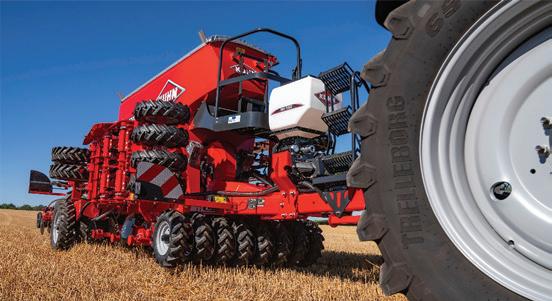
www.farmingscotlandmagazine.com 26 PRECISION FARMING

The big boys!
harvesters available today
Axial-Flow from Case IH
The Case IH Axial-Flow combine range comprises the 150 series, with models from 312 to 459hp and the 250 series, with models from 498 to 634hp. The 150 series offers a grain tank capacity of 8,800 to 10,470l while the 250 series boasts capacities of 11,100 to 14,400l, with a high-capacity unload rate of up to 159 l/s.

Axial-Flow® combines use a single rotor for smoother threshing, fewer parts, and seamless transition from threshing to separation. Grainon-grain action minimizes field losses, maintains clean, highquality crops. Centrifugal forces ensure optimal separation, even in tough conditions, and can include a hillside compensating cleaning system.
For controlled-traffic farming, an 8m Varicut® header (alongside 10m and 12m options) suits tramlines of 16/24/32m width, offering 8.53m (28’) width with same benefits. All grain headers have crop lifters, raising lodged crops to cutter bar with a higher profile, and wave-formed skid for wear resistance.
In addition, Case IH have a partnership with MacDon Industries Ltd, meaning that cobranded MacDon draper headers are now available to order with Axial-Flow models from Case IH dealers.
The 250 series features the X-tra Chopping straw chopper for residue management. It has a pre-chop system taking straw from the internal chopper, processed through a hoodmounted 96-blade chopper, spreading evenly up to 12m.
Operators can switch from swath to chop with a button in the cab.
The 250 series can include AFS Harvest Command™, relieving the operator from continually
refining operator settings in varying conditions, allowing them to focus on unloading and logistics. Rotor cage vanes and rotor speed automatically adjust
for loss control, and cleaning-fan and sieve settings minimize losses. A grain quality camera optimises threshing settings via continuous evaluation.
CLAAS completes combine harvester family with new EVION model series
CLAAS is extending its combine harvester product range below the TRION and LEXION series with two new five-walker machines. Equipped with modern Cummins six-cylinder engines and the CEMIS 700 control concept, these compact machines take performance, convenience,
flexibility and durability to a new level in this class. The EVION CLASSIC is a perfect fit for family farms as well as for contractors and agribusinesses with smaller field sizes.
EVION CLASSIC: The latest threshing technology combined with proven components
The arrival of the EVION completes the restructuring of the entire CLAAS combine harvester range which began with the new LEXION in 2019. As successors to the AVERO and the smaller TUCANO models, these three five-walker combine harvesters round out the lower end of the
COMBINES www.farmingscotlandmagazine.com 28
A look at some of the current combine
range below the TRION. “The EVION is a very important product for CLAAS”, explains CLAAS CEO Jan-Hendrik Mohr who is also responsible for the Grain Business Unit. “With these new combine harvesters we are able to offer modern, yet affordable machines for smallerscale farms which want their own grain harvesting equipment. We’re a family business ourselves and we want to continue to offer the right machines for smaller farms across all our product segments. We chose “family matters” as the theme of the EVION campaign with three messages in mind: first, to mark the completion of the CLAAS combine harvester family with the new EVION, second, to recognise family farms as the principal customer group, and third, to acknowledge our position as the world’s largest familyowned agricultural machinery company.”

The technology of the EVION is based on a modular system which is used to build
almost 40 versions of the LEXION and TRION. “For the EVION, we are drawing on tried
and trusted technology which has proven itself in thousands of machines”.
Innovations for the Fendt IDEAL
For model year 2023, extensive innovations are available for the Fendt IDEAL series of large combine harvesters: starting with the automated VariotronicTI Turn Assistant headland management system for more precise and efficient turns, through new lengths and heights for the unloading auger, to improvements for the cab that increase driver comfort.

Tight harvesting windows and increasing cost pressure mean that areas have to be harvested ever more efficiently. At the same time, increasing working widths place higher demands on the drivers. An optimised and fully-automated headland management system relieves drivers, saves valuable time and contributes to an even higher overall efficiency in harvest. The Fendt VariotronicTI Turn Assistant is now available for the Fendt IDEAL.
The Fendt VariotronicTI Turn Assistant enables the combine to turn independently according to the previously calculated and specified turning procedures. In
bed mode, the combine works the field in small sections, the unloading auger is always on the side that has been cut. This makes it easier to unload whilst continuing to harvest. For applications with narrow working widths or in maize,
the keyhole turn is available. If several combine harvesters are working on one area, U-turns support the work flow, ensuring machines don’t end up on the same wayline.
The Fendt VariotronicTI Turn Assistant avoids imprecise
turns, saving valuable time and reducing driver fatigue. Unnecessary crossings and manoeuvring are eliminated. The area is harvested efficiently and with high precision. This protects the soil and reduces fuel consumption.
www.farmingscotlandmagazine.com 29 COMBINES
Harvest 100 tonnes per hour with John Deere’s flagship X9 combine
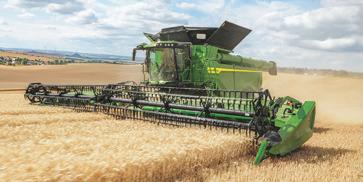
John Deere’s flagship X-Series combine harvesters help largescale farmers harvest more tonnes per hour and cover more hectares per day, specifically in tough, high yielding, wet conditions.
The X9 1000 and X9 1100 combines represent the next level of harvesting performance.
The X9 1100 can harvest wheat at 100 tonnes per hour at less than one per cent grain loss.
The Series features the widest feederhouse on the market, which is the foundation for performance. Coupled with a new dual rotary separator and the industry’s largest cleaning shoe, these work together to improve crop flow and increase harvesting capacity.
The 3.51m XDS rotors have taken the proven modular concept from the S-Series combines, with dedicated sections for threshing and separation. Alongside the traditional threshing elements, the separation area utilises a finger design to tease the last grains from the crop mat, so enhancing performance in conditions that are less than ideal.
The X9 is designed to excel in northern, high moisture, tough separation conditions where this machine has been tested extensively and has been proven to achieve over 100 tonnes/hr at a one per cent loss level.
During harvest, the highly fuel-efficient X-Series combines can run for up to
14 hours without refuelling and are powered by a John Deere PowerTech 13.6-litre six-cylinder diesel engine delivering up to 700hp.
The 1250-litre fuel tank can be fully refuelled in under 2.5 minutes with the new Fast Fuel System, providing filling speeds of up to 550 litres/min.
The X9 also features a brand new cab offering the latest equipment and options including seat heating and ventilation, a seat massage function and an app-enabled radio. With three different cab specification levels, Select, Premium and Ultimate, there is something to suit every budget and taste.
The New Holland Agriculture CH7.70 combine
The New Holland Agriculture CH7.70 combine is the latest addition to the CR twin rotor rotary ‘proven record holding’ range and the proven CX conventional range. Introducing a brand-new, Crossover Harvesting™ concept that brings together outstanding Twin Rotor® separation technology with the brand’s proven and renowned conventional threshing technology.
This Crossover Combine delivers outstanding grain and straw quality, for all crops and conditions. The highly fuelefficient engine with patented HI-eSCR 2 technology for Stage V compliance, delivers high productivity, extremely low operating costs and comes with the superior comfort of the Harvest Suite™ Deluxe cab.
The Crossover technology delivers up to 25% higher throughput than a conventional combine in this segment. The
two-drum threshing system features a 600mm diameter drum delivering outstanding threshing performance. The large drum combined with the user-friendly sectional concave, enables fast adaptation to different crops, in less than 20 minutes.
Drum speed is controlled from the cab by a new heavy-duty hydraulic drum variator, ensuring that the speed is perfectly matched to crop and field conditions. The New Holland Opti-Thresh™ system adapts to crop conditions and maturity by repositioning the rear part of the concave – no tools required. When the hinged top section is moved away from the drum, the rubbing action is gentler, improving straw quality.
The CH7.70 combines this high-capacity two-drum system with New Holland’s proven Twin Rotor concept delivering the Crossover Harvesting experience. The specially designed 21-inch,

3.45-metre-long Twin Rotor system provides the largest separation area in the segment, at some 2.9 m2. Minimal settings changes when switching between crops are required, resulting in outstanding crop-to-crop versatility.
New for Harvest 2023 will be the availability of the New
Holland by MacDon range of draper headers, both rigid and Flex Draper. Incorporating a range of headers from 25’ to a truly massive 50’, the New Holland by MacDon will complement and extend the existing VariFeed range and provide operators with options to cover all terrains and cropping requirements.
COMBINES www.farmingscotlandmagazine.com 30

Historic Wales Agriculture Act comes into force
Deddf Amaeth
Gwyddonwyr yn croesawu Strategaeth Biomas y DG
Mae gwyddonwyr o Brifysgol Aberystwyth wedi croesawu Strategaeth Biomas Llywodraeth y Deyrnas Gyfunol fel carreg filltir bwysig ar y llwybr tuag at economi sero net.

Mae biomas eisoes yn cynhyrchu dros 12% o gyflenwad ynni’r Deyrnas Gyfunol. Mae strategaeth newydd yr Adran Diogelwch
Ynni a Sero Net yn amlinellu’r rôl y gall biomas ei chwarae wrth gyrraedd sero net a chynlluniau ar gyfer gweithredu pellach.
Mae ymchwilwyr yn
Athrofa’r Gwyddorau Biolegol, Amgylcheddol a Gwledig (IBERS) yn ymwneud â sawl prosiect sy’n helpu i ddatblygu cnydau biomas y dyfodol. Mae hyn yn cynnwys gwaith ar wyddoniaeth cnydau Miscanthus a bridio planhigion sydd wedi cynhyrchu’r mathau newydd cyntaf yn y byd sydd wedi’u cofrestru ar gyfer cynhyrchu biomas.
Dywedodd yr Athro Iain Donnison, Pennaeth IBERS ym
Miscanthus, yn y Deyrnas Gyfunol erbyn 2050 ac y gellid cyflawni hyn heb unrhyw effaith ar gynhyrchu bwyd. Mae’r cyfraddau plannu presennol yn llai na 1,000 hectar y flwyddyn, felly mae’n amlwg bod llawer i’w wneud.
“Y rheswm dros gael targedau mor uchelgeisiol ar gyfer cnydau biomas yw bod mynd i’r afael â newid hinsawdd nid yn unig yn gofyn am ostyngiad yn yr allyriadau nwyon tŷ gwydr presennol, ond y rhai hanesyddol hefyd. Er mwyn mynd i’r afael â’r argyfwng hinsawdd, bydd angen sawl ateb arnon ni ac rydyn ni’n croesawu pwyslais y strategaeth ar yr angen am gymysgedd o dechnolegau tynnu nwyon tŷ gwydr hefyd.”
Wrth sôn am y camau nesaf, ychwanegodd yr Athro
Donnison:
The first made-in-Wales Agriculture Act is now law, having received Royal Assent.
The Agriculture (Wales) Act is key in supporting farmers and sustainable food production for generations to come.
The main source of future Government support for farmers in Wales underpinned by the Act will come through the proposed Sustainable Farming Scheme. This Act provides Welsh Ministers with the powers necessary to provide
support in the future whilst also ensuring continued support for farmers during a transition period, reflecting the Cooperation Agreement commitment with Plaid Cymru
It also paves the way for the banning of snares and glue traps, with Wales becoming the first UK nation to introduce a complete ban.
First Minister Mark Drakeford said: “This is a historic Act. The first time ever Wales has been able to design its own policy for

Mhrifysgol Aberystwyth: “Rydym yn croesawu’r Strategaeth Biomas newydd a’i ffocws ar flaenoriaethu defnyddio biomas yn y ffyrdd hynny sydd fwyaf addas i helpu’r Deyrnas Gyfunol i gyrraedd sero net. Hefyd, o ystyried pryder y cyhoedd ynghylch cyrchu biomas yn gynaliadwy, mae’n bwysig bod y strategaeth wedi ymateb i’r angen am feini prawf cadarn ar gyfer monitro, dilysu ac adrodd ar gyflenwadau biomas p’un ai ydynt yn cael eu cynhyrchu’n ddomestig neu’n cael eu mewnforio.

“Mae hon yn strategaeth sydd wedi’i chynllunio i ddeall ac ysgogi galw diwydiannol, ac felly mae’n hollbwysig bellach bod y rheiny sy’n gwneud polisïau a rhanddeiliaid yn sicrhau bod mesurau ar waith i helpu i ateb y galw hwn. Argymhellodd Pwyllgor y Deyrnas Gyfunol ar Newid Hinsawdd y dylid plannu tua 750,000 hectar o gnydau biomas lluosflwydd, megis helyg Cylchdro Byr (SRC) a
“Wrth reswm, mae ffermwyr a rheolwyr tir wedi bod yn amharod i ymrwymo ymlaen llaw i gostau plannu cnydau biomas lluosflwydd, yn enwedig o ystyried yr ansicrwydd ynghylch cymorthdaliadau a grantiau ar gyfer dewisiadau eraill megis plannu coed. Mae‘r cnydau hyn yn cynnig llawer o’r un manteision â choed, ac felly mae gan lywodraethau cenedlaethol gyfle i gefnogi ffermwyr i’w tyfu er mwyn cyrraedd y targedau sero net statudol yn ogystal â chefnogi’r economi wledig.
“Mae gan y Deyrnas Gyfunol yn gyffredinol, a Chymru yn arbennig, ardaloedd cymharol fach o dir amaethyddol o safon uchel ac mae’n bwysig ein bod yn parhau i gynhyrchu bwyd ar y tir hwnnw. Fodd bynnag, mae tir llai proffidiol yn addas iawn ar gyfer cnydau biomas lluosflwydd. Mae gan y cnydau hyn fanteision ehangach, gan gynnwys ar gyfer bioamrywiaeth, dal a storio carbon yn y pridd a gwrthsefyll llifogydd, yn ogystal â darparu porthiant ar gyfer ynni a gweithgynhyrchu gwyrdd. Felly, gall cynyddu biomas helpu i gefnogi economïau gwledig a threfol.”
www.farmingscotlandmagazine.com
hanesyddol Cymru yn dod i rym
Ffermio Cymru
farming. It comes at a crucial time for the industry, as we shape future support and face the challenges of higher costs and the climate emergency.
“The Act allows us to focus on the economic, environmental, and social sustainability of the Welsh agricultural sector. We know the main threat to sustainable food production in the future is climate change, this Act gives us the tools to support the industry to continue to produce food sustainably while taking action to deal with the climate emergency.”
Minister for Rural Affairs Lesley Griffiths said: “I’m very pleased to see the sealing of the Wales’s first Agriculture Act today. This is truly a historic day for Welsh farmers and rural communities.
“We are now moving ahead with delivering a system of support for farmers designed in Wales, and which works for Wales. This includes the Sustainable Farming Scheme which will be the main source of support for farmers from 2025.
“There isn’t a choice between sustainable food production on our farms and tackling climate change. Both must go hand in hand as the climate emergency is a real threat to agriculture and production of food. The Agriculture Act takes this into account, ensuring sustainable land management is at the heart of future support safeguarding the industry.
“I’d like to thank everyone involved in this historic Act.”
The Act provides tenant farmers with a route to dispute resolution to ensure they are not unfairly restricted from accessing financial assistance.
It also alters the Forestry Act 1967 to give Natural Resources Wales the power to add conditions to amend, suspend or revoke felling licenses to prevent felling that would contradict other environmental legislation.
It also replaces time limited powers in the Agriculture Act 2020 which are due to expire in December 2024.
North Wales farms taking action to support environment
Ffermydd Gogledd Cymru yn gweithredu i gefnogi’r amgylchedd



Rural Affairs Minister Lesley Griffiths has been hearing about how farm businesses in North Wales have been taking action to tackle the climate and nature emergencies.
On a visit to the Rhug Estate near Corwen, the Minister met proprietor Lord Newborough and his team and heard about their pioneering low carbon project to measure and monitor the business’ carbon footprint and take action to mitigate it, with the aim of reaching net zero across all business operations within Rhug.
The estate operates a diverse business model which embraces sustainable organic farming as well as renewable energy, retail, wholesale and most recently, skincare.
By the nature of the way the land has been managed over the last twenty years since the farm went organic, a very significant amount of Carbon has been sequestrated into the ground making it a carbon positive estate. The carbon positive result has been greatly assisted by its green energy projects in solar, wind, hydro and geothermal, and the EV chargers on its estate.
The data they are collecting is being used to modify carbon management.
The team spoke about their drive towards further improvements in carbon savings and green energy projects and the challenges and opportunities ahead of them.
In Ysbyty Ifan, the Minister heard about the work of the group of 11 innovative farmers on the Ysbyty Ifan estate and what they have done to improve the area’s ecosystem resilience, especially that of the Migneint SAC.
They explained to the Minister how collaborative working has been vital in helping meet their goals to improve land and water management and deliver multiple ecosystem
services for now and future generations.
Rural Affairs Minister, Lesley Griffiths said: “It has been great to visit and hear about the important work taking place at the Rhug Estate and in Ysbyty Ifan to decarbonise their farms and support our environment.

“As a Government, we will continue to work with and support farmers and land managers to meet the challenges of the climate and nature emergencies.
“It is important everyone works together across geographic and sectoral boundaries. Collaboration is essential if we are going to be successful.”
Ffermio Cymru
Farmtrac’s green tractor for Forest Green Football Club
Forest Green Football Club, the first UN Carbon Neutral Football Club in the world, has welcomed the industry’s first all-electric tractor from Farmtrac to its facilities in Gloucester.
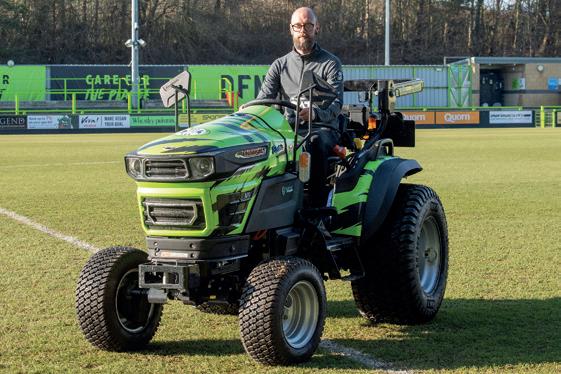
As the leading football club in the UK to drive sustainable practices within its infrastructure including pitch and groundscare environmental maintenance, Farmtrac’s FT25G completes Forest Green Football Club’s range of all-electric machinery choices at the stadium and training grounds.
The club’s continued process of improvement within the football and sporting industry has demonstrated what can be achieved and becomes the benchmark for clubs and sporting locations around the world to follow.
Nick Johnstone, head of pitch development and maintenance, explains how this strive for
sustainability impacts his job: “We have the first professional fully organic pitch. We don’t use pesticides or synthetic fertilisers and all our machinery is electric. This stops us using fossil fuels and cuts our carbon emissions and noise pollution.
“Over the next couple of years, we want to provide the best possible surface for our players in the most sustainable way and using the Farmtrac tractor will help with that. It’s used with various bits of kit to regularly groom, rake and brush the surface. We’ve also used it with a dimple seeder to overseed the pitch.”
And the Farmtrac tractor’s role will only increase when the club moves to its new training ground says Nick: “The tractor will become one of our most used bits of kit when we make the move to our new training ground. As well as all the work
it does at the stadium, we’re planning on getting a tractor mounted sprayer so we can use it for spraying too.”
Apart from the fact that it’s electric, what else appealed to Nick about the Farmtrac FT25G? He says: “We needed a lighter tractor to work on the pitch and keep the weight off it and the lightweight credentials of the Farmtrac means it does this. But also, the FT25G compares to other tractors in every way. It is easy to use and does everything that its diesel equivalent can do with no drop in quality.” This is, says Nick, a view shared by the team.
It was a visit to SALTEX, the sports turf, amenities, and landscaping trade exhibition, that brought Farmtrac and Forest Green Rovers Football Club together: “I first heard of the FT25G at the SALTEX trade show. I was familiar with
Reesink but had never used any of their machinery and I must say the experience of working with Reesink Agriculture has been very positive. I would happily recommend Reesink and Farmtrac to other groundspeople within the industry.”
So what’s next for the club?
With its sustainability features including creating a biodiversity area, using solar panels on the stands to provide 20 percent of its annual electric needs, LED scoreboards powered by the sun and sustainable practices of equipment maintenance cleaning, washdown water reductions and recycling equipment with Bio-Circle also distributed by Reesink, it’s anyone’s guess.
But rest assured, it will be a joy to watch this proactive, pioneering club continue to pave the way when it comes to sustainability in football.
IN
www.farmingscotlandmagazine.com 34

ATV safety and security paramount for hill farm contractor
Allistair Freeland-Cook and his family run 5500 ewes and 140 cattle over 6500 acres across their own land, tenancy and contract farming agreements. The land ranges from heather to herbal leys, with the majority of Black Face ewes lambing outside before coming down to pasture land to be crossed with Leicesters which produce the scotch mule that then provides faster growing fat lambs for sale.
“We have grown RP&A Freeland-Cook to include a variety of contracting services. My brother Daniel and I farm in partnership with our parents. Daniel runs the Saler cattle with my son Thomas and I work with them, my wife Claire and our daughter Emma to manage the sheep. We also have a forestry arm to the business, clearing land and road building,” Allistair explains.
The only way to cover the land and manage such a diverse business is to use ATVs. The family has worked closely with local dealer Frank Gibson ATV, where Euan Gibson has been helping them all to keep moving.

“We have had machines stolen in the past which is real problem for us, especially if we are lambing or calving. We can’t afford to be without wheels, but Euan has always kept us mobile.
The Yamaha Kodiak ATVs we have from him are worked hard and perform superbly. We rotate them every year and change them every four years, by which time they will have done more than 11,000 miles,” he says.
Following the theft of ATVs from the farm he has fitted trackers which also double up as a safety measure.
“Safety and security are paramount in farming, and having these trackers helps us to deter would-be thieves. However, we have been more impressed with the ability to track the movements of the ATVs, because knowing the location and whether the ATV is moving helps us to understand if the rider is safe. The tracker also signals if an ATV is overturned, which means we can act quickly to sort the problem,” he says.
The ATVs help to move sheep in a rotational grazing system using a variety of tandem trailers. The Yamaha Kodiak 700 EPS has more than enough power to carry 140 kilos and tow 600 kilos, but Mr Freeland-Cook suggests that the steering system and automatic gearbox also make these realistic figures when working on steep terrain.

“The Kodiak is powerful and compact which means it has an excellent power to weight
ratio. It also has power steering and excellent suspension which makes it a comfortable ride. It is really important for us that we can manoeuvre through tight spaces whilst towing trailers, and potentially a ewe or lamb on the ATV with us. This is one of the reasons we decided to choose Yamaha; we need stability on the hills,” he says.
Yamaha’s CVT transmission provides constant and smooth engine braking on hills which, when carrying heavy loads, instils confidence in the rider. It is also a significant help when using implements such as his C DAX sprayer, Logic weed wiper or Chapman snacker.
“Being able to keep a consistent speed without changing gear means I can focus on the task at hand. Whether it’s weed wiping or spraying fence lines, I want the job to be made easier, not harder, by the ATV and that is where the Yamaha CVT transmission really helps.”
To ensure the family can operate through the winter he purchased tracks for one of his Kodiak 700 EPS’s. The tracks enable the Kodiak to travel in the snow and are also helpful when the ground is saturated and slippery.
“The tracks give unbelievable grip on any surface, which means we can go anywhere, even when
the weather turns. We pull a snacker out in the snow to make sure the flock is well fed, or a trailer to move sheep, if the conditions are too challenging. The tracks are also an excellent way of minimising compaction when the ground is very soft,” he says.
To further diversify the usefulness of the ATVs he is considering a RAPPA fencing winder that will be operated on a Kodiak to erect fencing much faster than on foot.
“It will help us to put up fencing quickly in hard to reach places. It’s all about saving time and reducing the risk of livestock coming to any harm. If we can keep up with fencing work more easily it should be a good investment,” he says.
He sees his Yamaha ATV as a catch-all way to cover the ground and manage the stock. Without it he suggests the countryside would be significantly harder to manage and livestock farming would be far less appealing to the next generation.
“Having the technology and machinery to carry medicines, tools, stock, and minimise the work we, and our dogs, have to do on foot is critical to making a hill farming system work in the 21st century. We rely heavily on our Yamaha machinery and thankfully it doesn’t let us down,” he concludes.
www.farmingscotlandmagazine.com 36
case study
K-Line Dirty Water Filter
After many years of searching for a simple cost-effective solution to clean dirty water and make the K-Line system Work. We have worked with customers and come up with simple lowcost reliable system.
The K-line dirty water system consists of a submersible pump in the dirty water collection tank or lagoon.

The water is pumped over the dirty water filter using the submersible pump located in the dirty water collection tank / lagoon. The water goes through the filter into the collection tank underneath the filter, any solids slide of the filter and into the slurry lagoon, or into the particle collection tank.
The filtered water is collected in the tank below the filter, the cleaned water is then pumped by the secondary pressure pump, this pumps the water to the field then into the K-Line system.
The system has float switches to stop the pumps running dry when the water level
drops below a certain level the system can also be operated on a timer to avoid over watering and saturating the soil.

The pictures show the main components of the K-Line irrigation system in the field distributing the dirty water after the filter.
The isolation valves are fitted with quick couplers to save time when connecting and disconnecting before and after moving.
The pods can easily be moved using ATV or Quad bike.
The system is easy to set up.
One of the main advantages of this dirty water system over other systems is that all the components are simple and requires very little maintenance.
The system is designed as standard to operate @ 8 TO 9M3 per hour @ 3.5 bar, this is 6mm per hour per Ha.


This application rate avoids run off and soil saturation, as it matches the infiltration rate of most grass land.


www.farmingscotlandmagazine.com 37 ADVERTORIAL
K- Line being easily moved with RTY
The quick coupling for the use of K-Line
Dirty water filter
Dirty water filter
Playing it straight
The latest news some of the ploughs currently available
Tyrok OnLand joins the AMAZONE plough range
The new Teres and Tyrok plough ranges from AMAZONE offer furrow numbers from 4 to 9 furrows. The Tyrok semi-mounted ploughs, available in 6, 7, 8 and 9 furrows, now come with the option of either ploughing in the furrow or on top. Having the option of either or means that, if conditions deteriorate to the degree where it is no longer possible to plough on-land, then the plough can be simply switched to going back in the furrow where there is some traction possible; the conversion taking just a couple of minutes. The machineprotecting turnover process, which is damped at the end of its travel to avoid huge stresses on the frame, along with the automatic lowering of the centre of gravity during turnover means better operator comfort. The Tyrok also features in-cab depth control, automatic adjustment of the front furrow when changing the furrow width, known as AutoAdapt, as well as traction control that enables weight from the plough to be put onto the tractor’s rear axle when necessary on the move.

The Tyrok and Teres ploughs have been designed with reduced running costs and easier pulling. The geometry of these linkage ploughs means that the pull point remains completely true irrespective of what the furrow width is being used meaning that there is no side force on the landsides sapping power, increasing fuel usage and wearing metal unnecessarily. The in-house developed ©plus hardening process means that the wearing metal is extremely long-lasting as well as ultra-smooth to reduce soil
drag. The SmartBlade wearing metal setup is designed to reduce mouldboard wear generated by faster ploughing speeds with
a bigger replaceable shin. The choice of conventional points, available also as HD long life points, where the point overlaps
the wing to prevent rubbish being trapped in the joint, or reversible points for where extra penetration is required.
KUHN Master L plough
KUHN Farm Machinery’s Master L plough range sits between the Master 153 and 183 to offer the flexibility of a four to six body plough in either in furrow or on land versions, with the on land offering the flexibility to change to in furrow ploughing in one action. This offers operators with 200-300 horsepower tractors the option of using wider tyres and a variety of bodies to suit differing soil and ground conditions.
The Master L is available with three headstocks; a Standard, EasyDrive and OptiDrive, which all feature category 3N, 3 and 4N with fixed coupling yokes which simplify attachment and height adjustments to maximise traction. The OptiDrive headstock enables the switch between work and transport position without the need to unhook or adjust the top link. OptiDrive also offers a shock absorption system that improves driver comfort during turnover and
transport, whilst also protecting both plough and tractor.
There are three depth wheel options including a two sizes of standard depth wheels: 690 x 320 and 760 x 370 or a combi wheel which has a dual function for work and transport which has been designed for easy transition to the transport position. All offer mechanical toolless adjustment to save time and improve safety.
Hydraulic adjustment is managed through KUHN’s KTS
PLOUGHS www.farmingscotlandmagazine.com 38
10 control box. This provides three, four or five hydraulic functions with a single double acting hydraulic valve to adjust width, offset, angle, the control wheel and VARIBAR if fitted. The control box and VARIBAR also offer greater flexibility of pressure adjustment from the cab with a trigger rate of 1,500 kilos. An optional MAXIBAR can be chosen for the heaviest soil conditions and offers up to 2,500 kilos at the point. For older tractors, KUHN also offers a switch box that reduces the number of spools required to operate the Master L.
For grassland farmers, and those with smaller fields, the Master L beam and depth wheel has been designed to minimise overhang and enable ploughing closer to the field edge. This is facilitated by curved legs made of rolled steel for strength and durability to help with stability and weed or stubble residues.
The Master L can also be specified with KUHN’s Duoliner which operates independently of the plough to offer a drillready seedbed in a single pass. Two independent hydraulic parallelogram systems attach a row of dual 600mm diameter
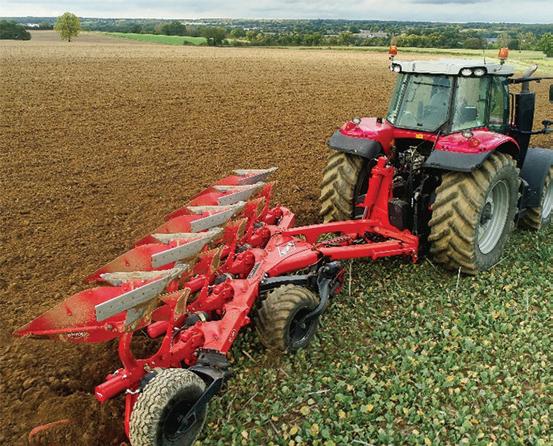
press wheels with 150mm spacings which, with KUHN’s Steady Control automatic pressure regulation system, impart up to 90 kilos of pressure at each pair of wheels to condition ploughed ground.
Ecomat –

Kverneland’s economical shallow plough option
Developed as an option for minimum disturbance seedbed preparation, Kverneland’s Ecomat shallow plough provides an effective method of mechanical control of pests and weeds through soil inversion, reducing the reliance on chemical methods.
“Ecomat is a half-way house between a plough and a cultivator,” explains Kverneland product specialist Adam Burt. “As a shallow plough, the

Ecomat still turns soil over but without needing to work as deep as a traditional plough.”
“We’re achieving 95% inversion at a working depth of 9cm,” says Adam. “And this implement is much easier to pull than a traditional plough, while doing a far better job of inversion than a cultivator.”
This new version of the Ecomat enables high-efficiency shallow ploughing, at working
PLOUGHS www.farmingscotlandmagazine.com 39 Main dealers for OVLAC Ploughs & Cultivators Sales • Service • Parts Repairs for a wide range of Agricultural Machinery Murthly, Perthshire, PH1 4HG Tel: 01738 710381 email: wilksbrothers@btconnect.com
depths ranging from 6cm to 18cm. As a result, output is much higher than conventional soil inversion methods, while fuel consumption per acre, is significantly reduced.
Developed as an on-land fullymounted plough, the Ecomat is available in two formats – 8 and 10 furrows. Short, plastic bodies suit high-speed use for inversion, while contributing to reduced weight.
By operating on-land, compaction can be easily managed by using tractors with much wider tyres and operating at lower pressures than those typically used when working in-furrow.
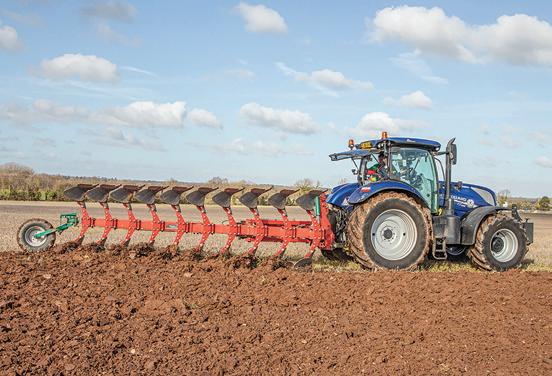
Furrow widths are mechanically adjustable from 30-50cm, generating a range of working widths from 3-5m. A 65cm point-to-point clearance contributes to a compact overall size, even for the 10-furrow fullymounted version.
Overall length is safely managed during transport thanks
to Kverneland’s innovative TTS – Trailer Transport System. This clever headstock design can
be found on many other new generation Kverneland ploughs, and includes a cross-shaft that
can be unlocked from its working position, enabling the Ecomat to be towed like a trailer.
New overload protection for LEMKEN ploughs well received
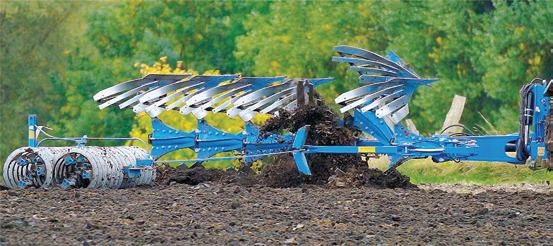
LEMKEN, the specialist for professional arable farming, launched the new OptiStone automatic overload protection for its Juwel, Diamant and Titan ploughs in 2021. At the heart of the OptiStone is a closed system of highly stable leg plates, which is reliably protected against dirt and foreign objects. A newly designed swivel bracket ensures high lateral tripping forces and optimal plough control in stony soils.
When an obstacle is encountered, the new LEMKEN overload element simultaneously deflects up to 37 centimetres upwards and 20 centimetres to the side. This provides for a sufficiently large range of deflection to ensure consistently disruption-free work, even with deep ploughing. The tripping forces can be continuously adjusted from the comfort of the driver’s seat to adapt to changing soil conditions. If the system catches below a slab of stone or
roots, it is additionally protected by a double-cut shear bolt to prevent damage to the plough.
The OptiStone overload protection features high-strength radial spherical plain bearings to keep the plough bodies stable as the system deflects. The plough bodies are firmly connected to the three-dimensional bearing points
and therefore cannot unhitch – a clear advantage compared to the overload protection systems with four-point suspension commonly found on the market. The radial spherical plain bearing is durable, reliable, and easily accessible for convenient maintenance.
Paul Creasy LEMKEN UK’s General Manager commented
‘the OptiStone autoreset system has been well received in the UK and Ireland. The tolerances it can work to suit the areas where auto-reset machines are a must’. The Juwel plough range will be on show at various events and field demonstrations throughout the UK and Ireland this autumn.
PLOUGHS www.farmingscotlandmagazine.com 40
Maschio Plough Range
The range of ploughs from Maschio offer the latest technology and are built for extra versatility and reliability. Mechanical variable width is standard across all Maschio ploughs; however, a hydraulic adjustment option can be specified. Shearbolt or hydraulic auto reset safety options are also available.
Available in two models the Maschio UNICO plough has certain key features that make it one of the best performers in the field – and one of the easiest to set-up and adjust:

The UNICO M is a mounted reversible range suitable for tractors up to200hp available with 3-5 furrows.
The heavy duty UNICO L range shares many of the UNICO M’s features but is built to cope with up to 300hp and is available in 4-6 furrow formats.

The UNICO ranges feature a wide range of benefits including:
Fast front furrow width adjustment - a double-arm parallelogram linkage ensures the line-of-pull remains straight and true as front-furrow settings are altered hydraulically.
Variable working widthmechanical or hydraulic varywidth. Bolt adjustment provides fine-tuning in 5cm increments – 27cm-54cm (depending on plough specification) while on the move hydraulic adjustment runs from 25cm–55cm.
PLOUGHS www.farmingscotlandmagazine.com 41
Turnover memory functioncloses the bodies up automatically when turning the plough over to ensure nothing hits the ground. Once back in its working position it returns to the preset position.
However, unlike other ploughs it does not do it by closing up the vary width linkage. Instead, it uses the beam alignment ram which means the pins, bushes and link rods do not get worn with every turnover.
Inter-body clearance of 95cm and under beam clearance of 80cm. Other options available.
Robust build - UNICO M - 120mm x 120mm reinforced
box section beam with 100mm headstock turnover shaft on 3+1 furrows and 120mm shaft for 4 and 5 furrow models. UNICO L Heavy Duty - 140mm x 140mm beam and 130mm shaft.
High quality from New Holland
New Holland ploughs are designed to guarantee high quality ploughing, easy set-up and favourable economy. All this is based on long experience of plough development. This places New Holland ploughs in a class of their own. Durable frames, manufactured using only the best quality raw materials, ensure long life and maximum output.
The plough range has onepiece frame tubes, some models are completely without welds.
All components of the frame are fixed with sturdy joints. Hole patterns are precision drilled in high-tech CNC machines with
the capacity to do all the drilling without removing the blank.
The PHVH 5 Furrow plough is popular with Scottish Farmers and could be considered the true workhorse of the New Holland plough line-up. This fully mounted, reversible plough, is compatible with tractors of up to 220hp that undertake heavy duty ploughing duties. The sleek, modern design ensure they cut an eye-catching figure in the field.
Easy adjustment - New Holland’s fully mounted ploughs feature a standard automatic adjustment system, aligning the plough as the front furrow
is adjusted. This system uses parallelogram geometry – which adjusts the plough once the basic setup has occurred. Once a plough is correctly adjusted, optimal results will be achieved. This system offers numerous benefits for daily use
• The front furrow width and alignment are adjusted to a basic setting using separate turnbuckles which do not influence each other
• Correct adjustment ensures the plough follows freely, using the minimum power required
• On ploughs with hydraulically adjustable furrow width,
this system ensures perfect alignment of all furrows, which can be easily adjusted

• The design is flexible, which means shocks are not directly transmitted to the tractor
• Correct setting minimizes unnecessary wear
Low fuel consumptionThanks to their efficient design, New Holland ploughs require up to 15% less draft effort compared to leading competitors. Don’t just take our word for it, the results have been verified by the Swedish University of Agriculture. The result: less effort means lower fuel consumption for lower overall operating costs.
PLOUGHS www.farmingscotlandmagazine.com 42

New SERVO 4000 and SERVO T 6000 with On-Land package from Pottinger
The plough still plays a major role in modern arable farming for controlling weeds and managing crop health. Due to the wide variety of soil types, no machine needs to comply with such a wide range of site-specific conditions as the plough.

The SERVO 4000 is the new 360hp rated hitch-mounted reversible range available from four to six furrows, whilst the SERVO T 6000 is rated to 500hp and available in formats up to nine furrows. Both ranges offer shear bolt, hydraulic reset (NOVA),
FARMING SCOTLAND MAGAZINE
Next issue out November 2023
Subscription page 109
hydraulic vari-width (PLUS) and PLUS NOVA models.
With the optional on-land ploughing package on the SERVO T 6000 not only is the power transmitted to the ground effectively, but the soil is conserved due to the large contact area, minimising harmful compaction in deeper soil layers. Likewise, it eliminates the risk of smearing the bottom of the furrow due to wheel slip from tractors tyres in the furrow. This prevents compaction, promotes crop root growth, soil life, and ensures access to water and nutrients.
Pottinger offer a wide range of mouldboard designs, however the 46Wc has become the most popular in recent years. The Carburised mouldboards include
highly wear-resistant surfaces for maximum service life, provide good tilth, with low draft in loam and clay soils and light soil types. This body is ideal for high working speeds and ensure excellent turning of the furrow ridge. The 46Wc preforms extremely well throughout all ranges of ploughing depths and ensures a wide furrow clearance for tractors with wide tyres.
The SERVO 4000 series offers a point-to-point spacing of 95cm with an under beam clearance of 80cm, whilst the 6000 series provides an interbody distance of 102cm. These clearances ensure trouble free ploughing when operating in heavy trash conditions or incorporating cover crops.
PLOUGHS www.farmingscotlandmagazine.com 44
Bees get week early wakeup call from warming climate
Warmer springs are causing British bees to wake up earlier, a new study has found, threatening the pollination of crops such as apples and pears.
The research – which is believed to be the largest of its kind in Great Britain – found that for every 1 degree Celsius rise in temperature caused by climate change, wild bees, such as bumblebees, emerge from their nests 6.5 days earlier on average.

As spring starts earlier and bees emerge closer to the start of the year, they may lose sync with the plants on which they depend, meaning there may be less food for them to consume. This means bees may not have the energy to pollinate crops effectively, or may miss crop blossom completely.
PhD researcher Chris Wyver, of the University of Reading’s School of Agriculture, Policy and Development, led the
study, which is published today (Monday, 10 July) in Ecology and Evolution.
He said: “Rising temperatures are making life tougher for bees. Warmer conditions mean bees emerge from hibernation earlier, but there may not be enough food to provide energy for them when they start buzzing about.
“Matching wake-up dates with plant flowering is vital for newly emerged bees because they need to find pollen and nectar to increase their chances of survival and produce offspring. A mismatch means bees cannot pollinate effectively.
“Less natural pollination could lead to farmers needing to use managed honeybees, meaning greater costs, which may be passed on to consumers. We could see even more expensive apples, pears and vegetables in supermarkets as a result.”
Four decades of data
The study examined 88 different species of wild bees over a period of 40 years, using more than 350,000 individual recordings that showed shifts in emergence dates, both over time and in relation to temperature.
Data showed that some bees emerge earlier than others as different species of bee respond differently to the changing temperature. On average, the 88 species are emerging 4 days earlier per decade.
With winters projected to be between 1 and 4.5°C warmer and up to 30% wetter by 2070, according to the Met Office, spring is likely to continue to start earlier and bees will continue to become active earlier in the year.
The shift in bee emergence will also have a greater effect on plants that are heavily dependent on pollination, such as apple
trees, which may not be ready to flower by the time hibernation ends.
FruitWatch
Like with bee emergence dates, understanding how climate change affects when flowers bloom on crops is also important because it can affect how well they are pollinated.
To learn more about when fruit trees flower, Chris and colleagues from the University of Reading and Oracle for Research have set up FruitWatch, a project that encourages people to report when fruit trees in their gardens, at their parks or allotments, start to flower. The submissions – of which more than 6,500 have been received in two years - will help the research team develop a greater understanding of the role climate change has on the flowering of fruit trees and pollination from bees.
www.farmingscotlandmagazine.com 45
ARTICLE
NORTHERN ISLES News

NFU calls for ‘support in writing’ in face of plant-based pledge by other councils
By Ethan Flett
SUPPORTING the county’s farmers should be a “no-brainer” for islands’ councillors, suggests Orkney’s NFU president, ahead of talks with School Place.
In the weeks ahead, union members will be lobbying elected members, in a bid to get a written agreement from Orkney Islands Council (OIC), committing its support for local farmers.

A motion recently passed by OIC on alternative modes of governance prompted international headlines — but Orkney’s NFU Scotland branch president, Colin Flett, is hoping their proposition will not prove so controversial.
He told The Orcadian that the move comes in response to “unfair press towards livestock farming” as well as growing national support for a “Plant Based Treaty.”
In January, Edinburgh City Council signed up to the initiative, which could result in a transition to more plant-based meals in schools.
In March, Norwich City Council joined the scheme, which aims “to halt the wide- spread degradation of critical ecosystems caused by animal agriculture.”
Now, the farming union will be seeking an explicit endorsement from OIC, backing the industry and its output.
Mr Flett explained: “We think that if the council pass a motion to support Orkney’s farmers and the food they produce then that would go a long way to helping our farmers who are under a tremendous amount of fire, to
feel slightly more valued and supported.
“Given the importance of agriculture and livestock farming, which is basically the only viable type of farming in these isles, and given the importance of it to the island’s economy, we think it should be a no-brainer for the councillors to get behind this.”
At the moment, the branch president added, OIC are “reasonably supportive of the industry”, including with ongoing efforts to tackle ferry and transport issues. Mr Flett also said that the kind of support they are looking for is not financial.
“We would like to see some support in writing, and we would like for the council to continue to source locally-produced food for all its services and for council events and things like that, and also urge members of the public
to support our local industries here,” he said.
He added: “As far as I can see, farming in Orkney is the backbone of the island’s economy. If the councillors
aren’t willing to back something like this, its a prettypoor reflection on them towards Orkney’s economy, and what we can produce sustainably here as well.”


George Taylor has a treasure trove of memories, and anecdotes to recall
George Taylor may not appear to have much to do with the sheepdog trials. But the retired dentist, who has spent his working life in Fife, has a treasure trove of memories, and anecdotes to recall.
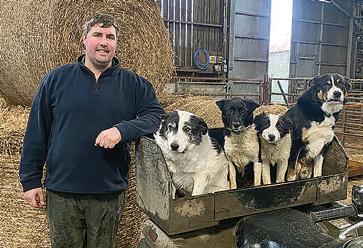
His grandfather, James Elliot Taylor, was a founding member of the Shetland Sheepdog Trails Association.
Born in Galashiels in the Borders, James Taylor came to Lerwick before the First World War.
“He noticed that very few dogs were used in the gathering of sheep in Shetland,” said George.
“It involved a lot of people, but a sheepdog could run miles and take direction from his master.
“Also, from the archives, it is apparent that sheepdog trials became more and more popular after the First World War, when socialising and gatherings resumed.
“My memories are of after the Second World War and in to the 1950s and early 1960s, when my father, also James –but known by his middle name, Elliot – was secretary.
www.farmingscotlandmagazine.com 46
Orkney’s NFU Scotland branch president, Colin Flett - Councillors called on to back livestock farmers
“James (Jeemy) Thomason, my father and Garnet Atkinson formed the core committee – a butcher, of Linklater & Co, a baker, Blacks, and an insurance agent, the man from the Pru.
“What did they know about sheep and dogs? They were president, secretary and treasurer, and formed a good team.”
Mr Taylor highlighted other names of those heavily involved, like auctioneer, George Keith Anderson, Angus Leslie of Laxfirth, ‘Sheepy’ Smith of Berry, Scalloway, Bobby Malcolmson of Sound and JJ Pottinger of Asta, who would provide sheep on the day.


Prominent dog handlers in these times included Davie Leask of Girlsta, Gideon Morrison of Vatster Gott, Angus Leslie of Laxfirth, J W Priest of Mossbank and Andrew Hughson from Fetlar.
Newcomers then were Marcus Georgeson from the West Side and the first female competitor, Alice Moar.
To be impartial, the judge and demonstrator was from south. Among those who made the trip up were David Murray from Peebles, J J Temleton from Ayrshire, Wat Little from Innerleithen and Mrs McCormack from Kingussie.
“Most dogs were black and white, but Murray’s dogs had some tan, mainly on their faces, while Mrs McCormack’s had a lot of white, sometimes covering half or more of the face,” said George.
“Pups from these experts were in high demand to increase the genes of good working dogs in the isles.”
Most dogs had the usual names, but one was unique –Laika, after the first dog to be sent into space by the Russians in 1957.
“It was quite expensive to bring the experts north and fundraising took the form of film shows and ‘concerts’ to various country halls.
“Jeemy Thomason was a keen amateur photographer and did a lot of cine work. One notable film, of documentary standard, was of the herring fishing – hauling in the nets on a lovely, early morning sunshine.
“Films were also hired, one showing life in New Zealand. This was of great interest as many Shetlanders had emigrated there.

“These film shows were a great success and some people came hoping to see relatives.”
But setting up for the trials was a hive of activity, which over the years saw the introduction of painted pens and gates, a tent and a loudspeaker.
“Catering was limited and most people brought their own –mainly a half bottle to share and drams were exchanged,” said George.
“One competitor who had come close to winning many times was advised to abstain from the ‘hospitality’, and he would have a good chance of winning.
“Unfortunately, he didn’t win that year, and on being consoled he replied that he was not worried about that – “It wis joost a’ da peerie drams dat I missed”.
George also recalls a time when he and Elliot went to meet the St Clair on her arrival in Lerwick, which was ferrying the
judge for that year’s trials, and his dogs.
The incident led to a dog going missing over the Knab.
However, it survived the incident thanks – George believes – to a heap of old wreaths discarded from the cemetery.
“Later in the morning we went for a walk to the Knab and one of his dogs got lost.
“The owner called and whistled to no avail. We went back to where it was last seen and, eventually, barking was heard.
“We discovered the dog down the cliffs, but not in the sea.
“I climbed down as far as was possible and saw the dog further down in small geo.
“The owner came down beside me and the dog, recognising his voice, clambered up to him safe and sound.
“We guessed that it had jumped the dyke, went straight over the banks and landed in this deep gorge about 40 feet down.
“Fortunately, this was the area where the cemetery attendants dumped the withered wreaths from the graves.
“The flowers had withered but the metal wire work remained, and made a cushioned landing for the dog.”
George also recalls having the good fortune to “borrow” a dog from Gideon Morrison and enter the junior class.
“There were three entries and there were three winners. But, as the story goes we were all equally bad. We shared the trophy for four months each. The others were Robert Tulloch of Lerwick and Bertie Couper of Weisdale.”
The Taylors left Shetland in 1962, when Elliot Taylor was presented with an inscribed wooden shield in honour of his years of service to the Shetland Sheepdog Trials Association. Elliot continued to maintain his connection with agriculture, running a farm in Easter Ross with George’s older brother, Leslie. Elliot died in 1981.

The farm, outside Tain, remains in the family, where the shield is still kept to this day.

www.farmingscotlandmagazine.com 47 www.shetlandtimes.co.uk Tel: 01595 742000 In association with www.orcadian.co.uk Tel: 01856 879000
Elliot Taylor on the left
Leslie Taylor, at his farm in Easter Ross. This photo was taken during the 1960s
Forays to Fort William
By Janice Hopper
The Lochaber Agricultural Show has just put the rural community in and around Fort William on the map when local farmers gathered on 26 August. Another real hub for those with a knowledge and passion for the local countryside is the Rural Centre in Lochaber and the Rural Education Trust.
The trust was recently visited by HRH Princess Anne in April, and pupils from Banavie Primary school demonstrated the art of milking a cow. Her Royal Highness’ second appearance of the day was to declare the Thomas Telford Corpach Marina open, but this wasn’t her first visit to the area as she also opened the Ben Nevis Auction Mart in 1999. While agriculture is highly valued in the area, Fort William is often referred to as the ‘Outdoor Capital of the UK’, so there are many varied attractions and activities here that make the most of its productive countryside.
The land in this corner of Scotland is appreciated for its beauty as much as for its agriculture and there are several quirky ways to enjoy it. Start by riding the Nevis Range Gondola (nevisrange.co.uk) up Aonach


Mòr to heights of 650m. The ride itself takes up to fifteen minutes
each way, so it’s possible to take photographs and have time to appreciate the views. Once up top, two short and well signposted hikes are available, Sgurr Finnisg-aig (approx 45min return walk) or Meall Beag (1hr return walk). Dogs are welcome too. It’s not uncommon to see mountain bikers tearing down the hillside in races, events and high octane practise runs. In winter look out for skiers and winter sports. The Snowgoose cafe up top has an outdoor terrace, plus it’s home to the highest bar in the UK, offering staggering views of the countryside. For those who wish to keep their feet on the ground, the Pinemarten cafe serves up meals back at base.
A second pitstop is Neptune’s Staircase. Built by Thomas Telford between 1803 and 1822 it revolutionised how goods could be transported (including agricultural goods) up and down the Caledonian Canal. Today it takes around ninety minutes for a boat to travel up or down the locks, so visitors often visit the waterside cafe and small ice cream parlour for a treat as they pass time watching the ships go by.
Another iconic way to experience the land around
Fort William is taking one of the most scenic rail journeys in Scotland. The Jacobite Steam Train (westcoastrailways.co.uk), made globally famous as Harry Potter’s Hogwarts Express, puffs its way across a 1,000ft span viaduct, 100ft above the ground, featuring 21 arches. Such a huge structure being built of concrete was revolutionary at the time of the viaduct’s completion in 1898 and its opening in 1901. The viaduct also stands out due to its beautiful curve across the landscape. Historically it was partly built to transport the harvest from the sea, taking fish
from Mallaig to Fort William and beyond, as part of the West Highland Line. Take it all in by booking seats aboard any of the trains that travel this line, from the Royal Scotsman to Scotrail. Today the line carries far more tourists than fish but the area is still invested in aquaculture. Salmon Farming developed around Fort William in the 1980s; it’s since been expanded and developed in the area by companies such as Mowi salmon farming.
The land here isn’t just fruitful it’s been violently fought over. Glenfinnan is an important

www.farmingscotlandmagazine.com 48
Travel Scotland
Jacobite steam train Glenfinnan Viaduct
View from Nevis Range hike
Caledonian Canal
Photo by Kenny Lam. Courtesy of VisitScotland
Photo Airborne Lens. Courtesy of VisitScotland
site because this is the spot where the the royal standard was raised and 1200 Highlanders gathered to pledge their loyalty to Bonnie Prince Charlie. After the campaign ended disastrously at Culloden in 1746 an eighteen metre high memorial was built in 1815 as a tribute to those who died fighting for the Jacobite cause. Today the site is under the stewardship of the National Trust for Scotland (nts.org.uk) and their on site visitor centre is full of detailed facts and information. Take a 5-minute walk behind the centre and cafe to reach an excellent viewpoint straight down Loch Shiel and over the monument, and then northwards up Glen Finnan. An equally powerful marker in the land is the Commando Memorial at nearby Spean Bridge. The commandoes trained here in WW2 with a base at Achnacarry House because the Highlands were considered some of the toughest terrain in the UK. The outbreak of war also changed Lochaber into a major centre for servicing Atlantic Convoys and for Motor Torpedo Boats.
After all the rugged, historic exploring take time to try something more indulgent. Book a distillery tour at Ben Nevis Distillery (bennevisdistillery. com) to learn how it utilises malted barley to create the water of life. Alternatively, make a beeline for the Highland Soap Company’s modern visitor


Travel Scotland

centre and Larder Cafe in Fort William (highlandsoaps.com). Here, visitors are surrounded by floral scents of the countryside. Savour a homemade cake, have a browse of the homewares and pick up Scottish toiletry products, such as ‘Hebridean Seaweed’, ‘Scottish Bog Myrtle’ or ‘Whisky and Honey’. The most immersive experience is getting hands on by booking a soap-making workshop to create your own small batch. Choose bespoke Scottish scents and textures, such as raspberry and whisky with oats, wild nettle with rosemary, heather complemented with tiny heather flowers, or go exotic with patchouli, rose, juniper or ginger. Such lovely mementoes to take home and enjoy.
Where to Stay
Ben Nevis Holiday Park on the outskirts of Fort William boasts an enviable setting, offering up the magical backdrop of Ben Nevis itself. Luxury lodges are available (three, four and five bedroom) with the option of a hot tub too. Plus there are smart glamping pods to consider. A budget option, allowing people to reconnect with nature, are camping sites and motorhome pitches. A playground, small shop, cafe, plus camping facilities such as laundry and modern shower blocks complete the picture. highlandholidays. com

www.farmingscotlandmagazine.com 49
Ben Nevis Holiday Park
Glenfinnan Memorial
Commando Memorial
Red deer by the Glenfinnan Monument.
Photo by Kenny Lam. Courtesy of VisitScotland
Spreading it about!
“Application timeliness improved through spreader ownership” Say Bunnings
Farmers wanting greater control over manure spreading applications to improve timeliness and increase consistency should be considering if owning a spreader, rather than hiring or using a contractor, will allow for greater efficiencies when applying valuable farmyard manures and composts.

As the second largest spreader in Bunning’s ninemodel Lowlander MK4 TVA range, the Lowlander 120 spreader offers users a 14t carrying capacity from the fully welded construction and is popular with farmers changing their approach to manure spreading. Ben Johnson, Bunning’s UK and Ireland sales manager, says the appeal of the TVA models are wide ranging.
“The 120 TVA is a popular model and is suitable for small and mid-sized farms wanting to increase flexibility and manage workloads to ensure manures are applied at the optimum time, and with high levels of product consistency.”
The robust design of the 120 TVA includes full width, socket-fit floor slats, with 80 grade 16mm floor chains that are standard on all Bunning spreaders up to the Lowlander 150 MK4 15t spreader. At the rear is a one-piece gearbox, while a rubber cushion drive coupling reduces shock loads to help increase the longevity of the spreading components.
At the rear, the standard spreading mechanism features twin 695mm dynamically
balanced augers with heat treated Boron flights to improve strength and longevity. Farmers looking to increase throughput and spread width, but retain the benefits of a smaller machine, can upgrade to twin 865mm dynamically balanced Widebody augers.
A popular additional feature is the rear canopy that covers the beaters during spreading, as Mr Johnson explains. “The canopy is fitted externally to cover the full length of the beaters, forcing the manure to be applied via the bottom blades. The option is aimed at light materials such as chicken litter, lime, and compost, allowing an even spread at low application rates.”
All Bunning spreaders are available with application rate controller using weigh cells via
Isobus or various Topcon control screens for precise manure application and management.
Conor Rear
Discharge Spreaders
The Conor Rear Discharge Spreader is a robust heavy duty machine designed for extensive use. It has many good features as standards such as wide angle PTO shaft, swivel hitch, torque clutch, viewing ladder, external grease points, speed control for the floor, commercial axle with 420 x 180 brakes, grade
80 16mm heavy duty chains and light protectors as standard. It is designed with strength and durability in mind. As standard it is fitted with 15mm Hardox tips and the base of the beater is made from 15mm plate. The floor is made from hard wearing 5mm. It also has a torque clutch on the drive line fitted as standard to
MUCK SPREADERS www.farmingscotlandmagazine.com 50
A look at some of the muck spreaders available in 2023
protect the rear beater gearbox in case something blocks the rotors. Extensive testing was carried out in the design stage to ensure the beater gives a wide and uniform spread. This has been achieved by using a combination of straight and curved tips and a wide spacing between the beaters. It is available in 8m3, 10m,3 and 12m3 models.
FARMING SCOTLAND
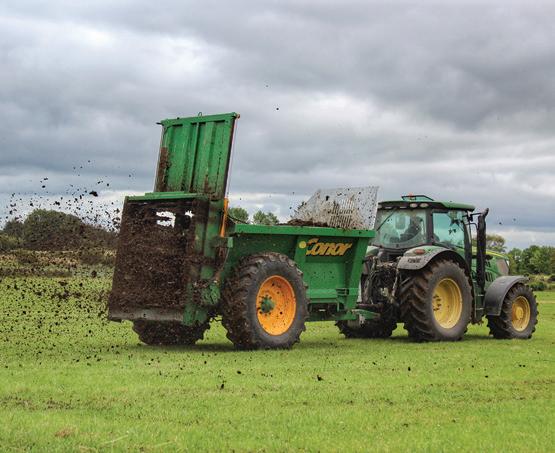

MAGAZINE
Next issue out November 2023
Subscription page 109
MUCK SPREADERS www.farmingscotlandmagazine.com 51
Muck Spreaders from Fleming Agri
Fleming Agri offer a range of side discharge muck spreaders with capacities from 1 cubic yard to 9.5 cubic yards covering both compact and agricultural uses. The bodies of all Fleming Agri muck spreaders are welded both internally and externally to give added support under load. There are 2 models in the compact range, the Minimuck which is three-point linkage mounted and has a capacity of 1 cubic yard and the MS150 trailed model which has a capacity of 3.35 cubic yards. Both models have a reinforced 3mm body and starter bars for quick start up. The power requirement is geared down through a simple chain and sprocket drive line mounted on heavy duty bearings to reduce the power demand on the tractor and increase fuel efficiency. The compact range of muck spreaders are suitable for tractors from 25hp upwards.
In the agricultural range, Fleming offer 3 models; the MS450 has a capacity of 4 cubic yards, the MS700 with a capacity of 6.5 cubic yards and the MS1000 which has a capacity of 9.5 cubic yards. The new and

improved MS1000 comes with a heavy duty galvanised, hydraulic opening lid. It has 8 stud axles with 550x60x22.5 wheels as standard. The MS1000 has 36 chains to give an accurate and even spread pattern and is fitted with 6mm end plates. Fleming Agri muck spreaders offer value for money with high output, and an even shred and spread of muck. Suitable for all types of manure,
including semi-solid and poultry litter as well as farmyard manure.
All Fleming Agri products are designed and manufactured in house, with a range of options to suite a wide range of uses. Here at Fleming Agri we manufacture products with simplicity and strength at the core, with a growing global dealer network, currently spanning over 20 countries.
A full list of our machinery and any optional extras can be found on our website www. fleming-agri.com. If you would like more information or images please don’t hesitate to get in contact with your local Fleming Agri rep and we will point you in the direction of your nearest Fleming dealer. Contact our Offices for more information on +44 (0) 2871 342637.
West Maelstrom Rear Discharge Spreaders from Harry West (Prees) Ltd
Built to a high specification and capable of achieving spread widths of up to 12M (40ft), the West Rear Discharge unit is particularly suited for farmyard manure. Fitted with the optional hydraulic rear door, it can also be used with poultry muck and semi-solids.
The twin rear vertical rotating beaters operate at a powerful 400 rpm from the PTO input drive of 1000 rpm. For trouble free maintenance the rear beaters are fitted with replaceable blades, and feature a protected two-piece drive-line with a PTO and slip clutch.

MUCK SPREADERS www.farmingscotlandmagazine.com 52
The rear discharge machine has large diameter tyres to minimise any ground pressure and is fully equipped for road use as standard with hydraulic brakes, hand brake and lighting.
The wide mouthed design of the main body allows for easier loading with modern telehandlers and larger buckets. It also enables the load to be increased with larger capacities. The
introduction of body extensions alters the model to reflect the increased load capacity.
Additional options are available for these machines, electric in cab controls for
the bed chains, mudguards & weighing systems/GPS.
Six different models are available in the West Maelstrom Rear Discharge line up ranging from 8M3- 18M3.
Hi-Spec side and rear spreaders
The range of spreaders from HiSpec Engineering include both the rear discharge XCEL 1250 spreader and two side discharge machines. The Hi-Spec XCEL 1250 is unique in that it uses a rotary chain and flail system to achieve a good break up of material, which is then spread using a pair of spinning discs.

The shredding rotor carries 22 heavy duty chains, which in turn carry 12mm Hardox flail heads, mounted under a 4mm Hardox hood, that shred all the material to an even consistency and ensure no lumps are deposited onto the spreading

MUCK SPREADERS www.farmingscotlandmagazine.com 53
MUCK SPREADERS

rotors. An adjustment plate on the shredding rotor hood, evenly places the manure onto the spreading discs to ensure an even spread.
The Xcel 1250 has a capacity of 12 tonnes and can evenly spread material up to 24m. Typical discharge time is 3-5 minutes and it is able to spread all types of material.
The material to be spread is moved rearward by a single slat marine grade floor chain. Individual floor chain tensioners are placed to the front of the machine and drive to the floor chain is via a hydraulic motor with overload protection and variable speed adjustment.
A hydraulically operated, vertical slurry door can be used to regulate flow of material to the shredding rotor, and at the spreading discs an option of lighter vanes can be specified for low density material, such as chicken compost.
The standard specification includes 580/70-R38 radial tyres for low rolling resistance and low compaction, and a commercial axle fitted with hydraulic brakes. Options include a weigh cell and the ISOBUS compatible RDS iSOCAN Apollo spreader control system or the straightforward DigiStar GT400 weighing system.
Side discharge spreaders
Two Hi-Spec side discharge spreaders are available – the 8m3 SS800 and the 10m3 SS1000. As with the tankers, Hi-Spec manure spreaders are built using heavyduty 5mm thick British steel and feature a 3mm lid.
The lid is hydraulically operated and once engaged, the 168mm diameter flail rotor rotates at approximately 230rpm, resulting in a constant and even spread of material at up to 8.0 metres width.
The rotor is driven by a single chain, with manual tensioning and is fitted with 12mm, 15-link hardened chains and toughened flail heads. Standard specification includes a ring hitch, hydraulic braking and LED road lights, while the SS1000 also incorporates centralised greasing., which is an option on the SS800.
Award-winning spreaders from KTtwo
Ktwo have continued to be recognised as one of the best British manufacturers of farming machinery! Most recent award wins include BUILD Magazine’s Construction & Engineering Awards 2021 Best Trailer & Muck Spreader Manufacturer SME’s British Made Awards 2021 Best Agricultural Trailers & Muck Spreaders Manufacturer and EU Business News Agriculture and Farming Awards 2021 Best International Trailer & Muck Spreading Machinery Manufacturer.
Robbie Polson, Ktwo Managing Director, says ‘’We pride ourselves on our innovation and quality, and we are very proud to be recognised as the Best Trailer & Muck Spreader Manufacturer in the UK and internationally. We
continue to improve our products around our customer needs, and our improved MK5 versions of our Ktwo Bio and Ktwo Evo spreaders have been very well received by customers which is a credit to our fantastic team.’’
Our Ktwo Bio range of rear discharge muck spreaders with twin horizontal beaters are designed with the most accurate of applications in mind and are the perfect choice when spreading higher value products. Whilst our Ktwo Evo range of rear discharge muck spreaders with twin vertical beaters are designed to cope with the most demanding conditions whilst at the same time providing extra accuracy and the highest outputs available.
We launched the improved MK5 versions of the Ktwo Bio
and Ktwo Evo in 2020 and the improvements further increased volume and ease of emptying which has been well received by farmers and contractors nationwide.
‘’We received our new Ktwo Bio 1600 in 2020.’’ Explains Adrian from Thoresby Farms in Nottinghamshire, ‘’we love it due to the high output and spreading accuracy. One of the key features for us was the hardened beater tips and wear plates due to spreading pig muck which has a high stone count.’’ Adrian was also very pleased with the support from the Ktwo team, ‘’The machine is very reliable, and we have good back up support from Ktwo on wearing parts. Ktwo supported us all the way in getting 100% output of the machine, all the time. ‘’
www.farmingscotlandmagazine.com 54
Powerspread side-discharge range from Shelbourne Reynolds
Shelbourne Reynolds continues to focus its muck spreader manufacturing on universal machines able to handle all types of manure from slurry to solids, with its Powerspread sidedischarge range. Available in two versions, the Powerspread Dairy comes in 7.25m³/1,600-gallon and 9m³/2,000-gallon models, each with a full-length auger rotating at 13rpm to bring material to the centrally-mounted discharge rotor. The hydraulically operated door opens vertically, utilising the complete width of the discharge rotor, which works at 700rpm in an overshot direction, allowing the Hardox door to act as a shear bar to fragment the material before spreading in an arc away from the side of the machine.
The four-model Powerspread Pro range offers capacities from 8-14.5m³ (1,800-3,200 gallons) for high-output operations. A new weigh scale option, developed from the maker’s Powermix diet feeders, features three 90mm load cells – two on the axle and one of the drawbar – each with a maximum 10t capacity. The scale head can be mounted on the spreader or in the tractor cab, and a wireless remote scale is also available for the machine loading the spreader.
“This new option allows users to manage application rates more efficiently, which is particularly important given rising fertiliser prices,” says Shelbourne Reynold’s Neil Smith.
“The system is optional on all long wheelbase Powerspread Pro models. For the near future we also have in development a data transfer system to help users maintain accurate application records for farm record-keeping, and a GPS mapping system to allow variable rate application, features will further enable these
machines to match the capabilities of any other type of spreader on the market.

“Powerspread Pro machines are also available with tandem axles and optional rear-wheel steering to spread the load and minimise field damage and tyre wear, options which can be combined with a range of flotation tyres.”

MUCK SPREADERS www.farmingscotlandmagazine.com 55
Quality Meat Scotland updates Auction Market and Collection Centre Assurance Scheme Standards
Meat Scotland (QMS) Standards Setting Body for the Auction Market and Collection Centre Assurance Scheme.

Key changes to the scheme will see additions to biosecurity and disease control, which covers pest control, updates to the cleansing and disinfection requirements and management of fallen stock.
Auction markets and collection centres play a significant role in our whole chain assurance which underpins the QMS brands and reinforce consumer trust.
Kathryn Kerr, Head of Brands Integrity at Quality Meat Scotland, said:
“Working in close collaboration with key industry stakeholders, the review incorporated a new step whereby members were able to provide direct and extensive feedback on the proposed changes, prior to being signed off by the standard setting body.
“These updated requirements are not intended to complicate business operations, but instead provide practical and relevant measures to protect the industry’s reputation at a time when consumers are demanding greater transparency about how their food is produced.”
A summary of the main additions and revisions to the
Auction Market and Collection centre Assurance Scheme, and why they were made, will be landing with members in the coming days
alongside a full copy of the updated standards, three months before they go live. They will also be available to view on the QMS website.
Making Changes to Manage Digital Dermatitis
Lameness is a challenge, but digital dermatitis is very easily controlled and prevented. It is estimated that c.1 in 3 cows is lame at any given time. The cost of digital dermatitis is estimated
loss of c.£107 / case / lactation, showing how important it is to manage DD for business efficiency.
To prevent digital dermatitis from occurring in the first place,

livestock www.farmingscotlandmagazine.com 56
the focus should be on foot hygiene. Once an animal is infected with digital dermatitis, she will carry the disease with her for the rest of her life. One way to manage this is through proper footbath use and identifying active lesions for timely treatment. The goal is not to focus solely on treatment but to prevent NEW INFECTIONS by disinfecting feet, ideally every day if not every milking. Footbaths are prevention, which is better than cure.
While formalin and copper sulphate are popular for footbathing, copper is not licensed due to its environmental toxicity and there are safety restrictions in place on formalin
crofting
Women in Crofting
By Patrick Krause, Chief Executive, Scottish Crofting Federation

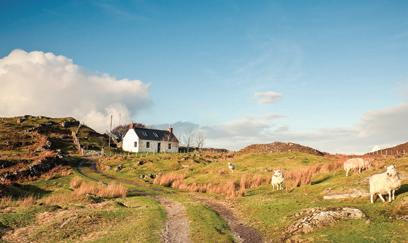
The Royal Highland Show may seem a distant, happy, memory now. The Scottish Crofting Federation (SCF) led the representation of crofters at the show this year with the launch of a trans-European gender-equality research project.
crofting areas and being organised by a collaboration of SCF and Newcastle University.

The SCF recently announced the appointment of a new chief executive, due to take up post in September.
due to its carcinogenic properties. Eventually, the dairy industry won’t be able to use either.
Provita Hoofsure Endurance
• Proprietary blend of organic acids & essential oils
• Safer to use and biodegradable
• Highly concentrated allowing up to 5000 cows per 20 litre drum
• 40+ trials across 3 continents, 440+ million cow passes worldwide

• Notable research shows it is up to 44% more effective than formalin and copper sulphate with proven antibacterial activity
• Range also includes hoof gel and spray.
The launch of the ‘GRASS Ceiling’ project was not only an enjoyable highlight of this iconic show, but was also very informative. George Burgess, Director of Agriculture and Rural Economy introduced the project and outlined the Scottish Government’s on-going commitment to this vital work with rural women. Scottish Government has taken this issue to the front, with a ‘Women in Agriculture Taskforce’ launched at a previous Highland Show by the, then, First Minister. Professor Sally Shortall, Newcastle University’s Duke of Northumberland Chair of Rural Economy, also gave a very interesting account of how women’s involvement in rural enterprise – including farming and crofting - can be misrepresented by statistics. She referred to some recent figures published that didn’t give the true picture of how much women are actually marginalised or rendered invisible in Scottish agriculture. She emphasised the project’s size – including 25 partner organisations in 9 countries –with the UK being represented by women innovators in the
Donna Smith is the first female chief executive the organisation has had, though the board of the SCF has a proud history of female directors and female chairs. SCF’s policy is to have no more than two thirds of either gender represented on the board and it has occurred that there needed to be action taken to ensure that women did not exceed this rule. The balance is currently 50:50, and over the past 20 years there have been roughly an equal number of female chairs as male chairs. According to statistics, which may well be an underestimate, 30% of crofters are female and are happy to declare this.
The Women in Agriculture Taskforce had representatives from across the rural sector including the farmers’ union and the SCF. We are seeing positive progress with the SCF’s latest appointment, with crofting women coming forward and with the GRASS Ceiling project, but people are asking if there is true recognition yet of the vital role of women in the farming sector, or are they still being unrepresented and hidden from view?
www.crofting.org
livestock www.farmingscotlandmagazine.com
Salmonella risks highlighted at Layer Conference
Elanco and Rosehill welcomed 50 delegates to their annual Layer Conference, at the West Midlands Shooting Ground on 29 June, where delegates were warned of the continued risk of Salmonella and recent vaccine research was showcased to help prevent the disease.
One of the major take home messages from the day was highlighted by Shaun Cawthraw, from the Animal and Plant Health Agency (APHA), who shared the alarming figure that cases of Salmonella on-farm between 2018 to 2020 had risen by approximately 50% compared to 2013 to 2017, driven by regulated and nonregulated serovars.
“While this has been mainly driven by a rise in non-regulated

serovars in broiler cases, it shows a trend that could be seen in layers in the future, if no action is taken,” he said.
“It’s imperative that egg producers are aware of Salmonella serovar prevalence and their risk levels.

“In commercial layers, S. Newport has been the most common serovar, affecting 18.4% of positive flocks.
“However, S. Infantis is one of the most frequently isolated poultry serovars globally, and it’s an emerging risk in the UK. It’s the most clinically significant serovar, as the principal source of human infection - something the layer industry must be vigilant against,” warned Dr Cawthraw.
livestock www.farmingscotlandmagazine.com 58

Bovine Coronavirus the Most Prevalent Virus Found in Routine Screening for Calf Respiratory Disease
Recent UK studies show bovine coronavirus (BCoV) as being the most prevalent virus found in routine screening during calf respiratory disease outbreaks.
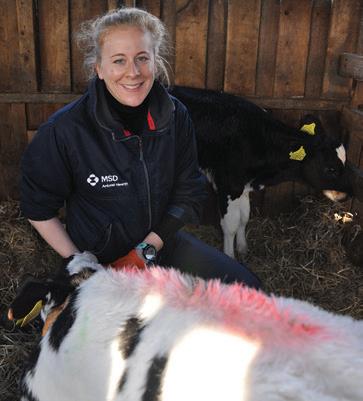
Calf respiratory disease is widespread (described as inevitable by some farmers) and comes at a high cost from

an emotional and business productivity perspective. It’s a classic iceberg disease and one which is continually highlighted as a critical area for overuse of antibiotics. Despite this background, there is an under use of vaccination in the UK cattle sector.
Calf serology on 59 UK farms known to have had a history of respiratory disease issues (2021-2022) reported
livestock www.farmingscotlandmagazine.com 60
91.5% of samples being positive for BCoV.
Speaking at the National Youngstock Conference, Dr Kat Baxter-Smith from MSD Animal Health UK (a division of Merck & Co., Inc., Rahway, N.J., USA (NYSE: MRK)) suggested coronavirus needed to be taken more seriously as a respiratory pathogen by veterinary practitioners and the UK cattle industry – just as human health experts have had to change their mindest following the Covid-19 pandemic.
“While BCoV is a relatively well-known cause of neonatal calf diarrhoea – and the same virus as the respiratory variant – its role and impact in calf pneumonia has been less well defined. However, our latest diagnostic data certainly shows its overwhelming presence during calf respiratory disease outbreaks in the UK,” she said.
She added that the fact BCoV is frequently isolated alongside other, perhaps more recognised respiratory disease pathogens such as BRSV, M. haemolytica, Pi3 and M. bovis, suggests an interplay between these organisms.
Wise Agriculture appointed as the GB agent for Advantage Feeders
Wise Agriculture has been appointed GB distributor for Advantage Feeders livestock feeding systems.
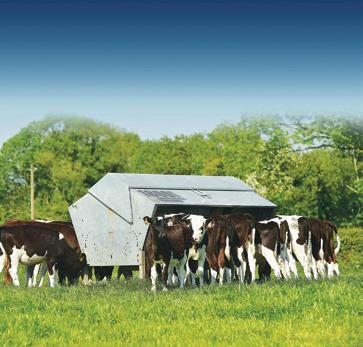
Headquartered in Victoria, Australia, and formerly known as 3IN1Feeders, Advantage Feeders offers an extensive range of grain and pellet feeders designed to optimise productivity in beef, dairy and sheep.
“Advantage Feeders promotes ‘little and often’ controlled feeding by utilising stock’s saliva production to manage feed intakes. This improves rumen function and digestibility, which increases feed conversion rates to achieve higher output on lower feed input,” explains Gerard Roney, managing
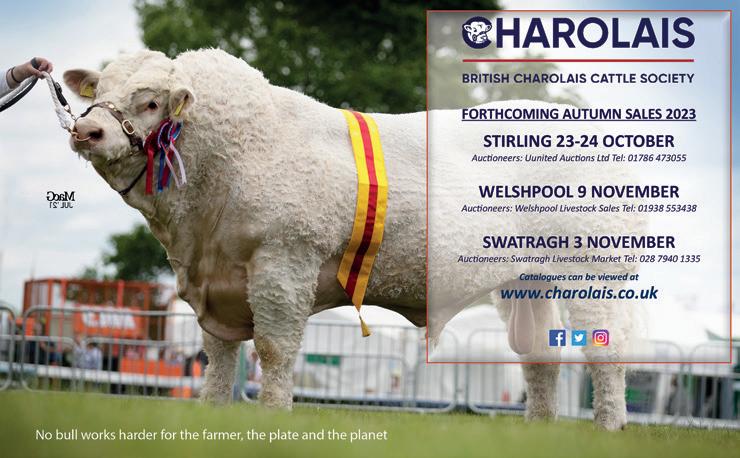
livestock www.farmingscotlandmagazine.com 61
director of Advantage Feeders.
According to Mr Roney, the partnership with Wise Agriculture will support the company’s mission of providing new innovative feeding solutions to British farmers and allow it to continue to provide a high level of customer service to existing and future customers.
Based near Richmond, North Yorkshire and established in 2018 by livestock farmers Edward and Laura Wise, Wise Agriculture specializes in premium livestock handling, data recording and animal welfare solutions for beef, dairy and sheep producers. The business is the UK distributor of Landquip’s Porta-Yards sheep handling portfolio and is the primary UK dealer of Arrowquip cattle handling equipment.
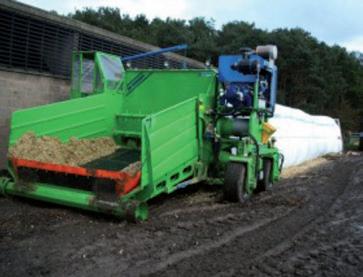

FARMING SCOTLAND
MAGAZINE
Subscription page 109
UK animal product exports to EU will soon need vet signed declarations
Starting from 13 December, 2023, non-assured UK livestock farmers will be required to provide a declaration signed by a veterinarian following an annual farm visit in order for their products to be eligible for export to the EU.
This new requirement is due to an EU animal health regulation change mandating farms producing animals or products of animal origin (POAO) for export to have regular veterinary visits. The previous temporary requirement, which involved a farmer declaration, will be replaced by this new procedure.
To obtain this declaration, farmers must undergo regular
animal health checks conducted by qualified veterinarians. During these visits, the vet will be required to carry out a visual assessment of the farm to confirm freedom of notifiable diseases.
No sampling or laboratory testing is required. It is important to note that this does not need to be the sole purpose of the visit and can be combined with other visits covering routine work,

livestock www.farmingscotlandmagazine.com 62 B. RAE CONTRACTING LTD. Chesters Brae, Southdean, Hawick TD9 8TQ Office: 01450 860672 Mobile: 07774 163665 / 07980 916297
FOR AG-BAG, SILAGE Direct Drilling • Crimping Grain Bruising all other General Contracting
B. RAE CONTRACTING LTD
providing that all species present at the premises are considered.
The vet visits should occur at least once during a 12-month period. If the visiting vet considers a need for a subsequent visit before the 12-month mark, this information will be communicated to the operator (livestock owner/keeper) and clearly stated in the declaration.
Farmers who are part of an approved farm assurance scheme already meet the requirement for a veterinary visit. Their participation in the scheme is already noted as part of the food chain information so no
additional veterinary declaration is required. Schemes currently approved are: Red Tractor, Quality Meat Scotland (QMS), Farm Assured Welsh Livestock Beef and Lamb Scheme (FAWL) and Welsh Lamb and Beef Producers Ltd (WLBP).


If your farm has had an annual health and welfare review as part of the Animal Health and Welfare Pathway, then this visit will also fulfil the requirements. You will need to retain the receipt from your visit as evidence as official veterinarians certifying goods for export do not have any access to the AHWP database.
New method to assess pullet quality on-farm
A new on-farm method for assessing the quality of pullets has been launched by Lallemand Animal Nutrition.
The new measurement was unveiled by the company at this year’s European Symposium on Poultry Nutrition (ESPN) in Rimini, Italy, following a trial to validate its use on a 30,000 pullet commercial rearing unit.
Hannah Elliott, Lallemand’s monogastric technical manager for the UK, says the tool will help poultry producers more accurately assess the quality and future performance of their pullets.

“We have known for some time that body weight measurement is not enough to properly evaluate pullet quality,” adds Ms Elliott.
“Muscle development and protein retention are also important parameters to consider for pullet quality and future laying performance.
“The new measurement tool we’ve trialled focuses on these parameters by assessing the thickness of the breast muscle in pullets using handheld ultrasonography.”
She says as well as validating the tool, the trial on the commercial rearing
Don’t forget the summer lungworm risk!
– calves which are prone to repeated cases of pneumonia and fail to grow. Whilst these are obvious cases it is more difficult to determine the level of damage done to the whole herd and calculate the cost of poorer growth rates and delayed finishing.
By Madeleine Brady Northvet Veterinary Group
unit also assessed the effect of probiotic supplementation with Pediococcus acidilactici CNCM I-4622, known commercially as Bactocell, on pullet performance.
“The trial found that supplementation with the probiotic led to thicker breast muscles in the pullets, alongside improved and efficient growth performance,” adds Ms Elliott.
“By improving feed digestibility and lowering inflammation, the probiotic appears to contribute to better protein retention from feed and more efficient protein deposition in the muscle - as such, it is considered a promising nutritional strategy to secure laying hen performance.”
Meanwhile, the results from two other Lallemand trials were presented at this year’s ESPN.
The first involved supplementing laying hens with Bactocell during the late phase of their production cycle, while the second involved supplementing rearing pullets at hatch with Aviguard - a natural microbiota isolated from healthy poultry.
“Results from the Bactocell study show confirmed benefits in laying performance, due to the probiotic improving gut health and performance,” explains Ms Elliott.
A warm and wet summer provides ideal conditions for parasites to thrive and lungworm is an important cattle parasite that may be seen. Calves are mostly at risk during their first grazing season as they have little immunity but it should be considered in older stock too especially if there is high burden on pasture.
Lungworms cause a parasitic bronchitis and pneumonia with adults living in the airways. Animals present with coughing and increased breathing rate, especially after exertion. Left to progress and animals may suffer fever, weight loss, secondary bacterial pneumonia and death. Animals that recover may be left with areas of damaged lung and have increased susceptibility to pneumonia in later life.
It is estimated that lungworm outbreaks lead to losses of £50-100 per head in growing cattle. Severe lungworm outbreaks can cause stunted growth and lead to ‘respiratory cripples’
Testing for lungworm is more difficult than testing for gutworms as larvae not eggs are passed in the faeces. Lungworm testing is not included in routine faecal egg counts so it is important to specially request this. Additionally we may see clinical signs before there are adult worms present so a negative test does not rule out an early infection. Most wormers treat lungworm very effectively and at risk cattle should be dosed pre housing to ensure animals are entering sheds with clean healthy lungs. With weather patterns changing it is very difficult to predict the timing of lungworm risk and so producers should be aware that dosing may be required earlier in summer. A vaccine is available so speak to your vet about the best lungworm control options for your farm.
Piece of lung with lungworms present

livestock www.farmingscotlandmagazine.com 63
The VET
Positive trends for dairy herds despite challenging conditions
Dairy producers faced unprecedented volatility in 2022-23, with record high prices across the board, from inputs to milk markets. But they did an excellent job, securing record margins over purchased feed –although the gap between the top and bottom performers widened further, showing the importance of attention to detail.
According to the annual Kingshay Dairy Costings Focus Report, milk prices have increased by 61% over the past 10 years, reaching an average of 50.98p/litre in December 2022. However, there was a sharp drop in the first half of 2023, with prices losing more than they gained in the second half of 2022.
“The gap between the top and bottom 10% of prices reached a peak differential of 16.2p/litre in February, with producers in Scotland suffering the worst prices on a regional basis,” says Kathryn Rowland, senior farm services manager at Kingshay.
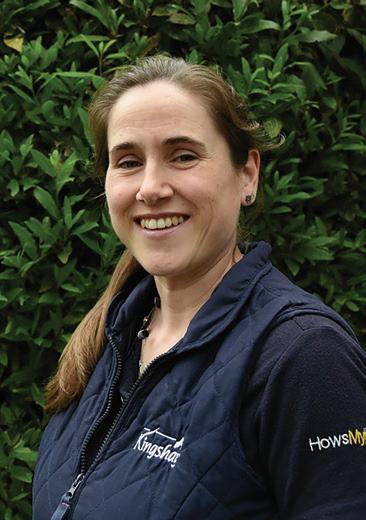
The hot, dry summer of 2022 caused milk from forage to drop slightly, with many producers turning to feed winter forage stocks. “The bottom 25% of producers used almost a tonne (917kg) more concentrate per cow than their higher performing counterparts, at 3,197kg fed over the 12 months.”
Not only did the summer impact yields, but fertility too. “Cows didn’t display such obvious oestrus cycles due to the hot weather. As a result, days to first service increased from 69 to 75, and given the high milk price, the cost of each day of extended calving interval increased to £5.89/day per cow,” says Ms Rowland.
When comparing production systems, year-round housed cows produced the greatest margin per cow (but this higher
margin needed to cover higher costs of production associated with housing systems), with low to moderate yielding organic herds leading on a per-litre basis. “However, the gap between the top and bottom quartile of those within the same systems widened again, showing the potential to improve performance within an existing system rather than switching to an alternative,” she adds.
New to the report this year is heifer trends, which found 62% of herds were not hitting the age at first calving target of between 23 and 25 months. “Also, 50.2% of cows leaving the herd are in their first three lactations, before they have fully paid for the cost to rear them and this can have a big impact on carbon footprints.”
Herd size has grown by 23% over the past 10 years, although there was a dip in 2019 to 2021 when flying herds were not restocking due to high heifer prices. “Since 2021, herd size has recovered its long-term trend, rising from an average of 201 cows to 217,” explains Ms Rowland.
Yields have also grown by 10% over the past decade, but over a shorter period have stagnated, remaining around 8,400 to 8,450 litres per cow since 2020. “This could be due to a reduced focus on production alone, with a shift towards efficiencies and margins,” she adds.
Milk from forage and grazing has also remained static since 2020, but over 10 years has grown by 31% and 9%, respectively. At the same time, concentrate use per cow has grown by 12%, with prices up by 46% to a record high of £357/t (rolling 12 month average). As a result, total purchased feed costs have jumped by 58% per cow and 44% per litre of milk produced.
“Thankfully, the milk price has increased by 61% over the same period – also to a record high –meaning the milk price to feed price ratio has widened by 10%, to 1.33,” says Ms Rowland. “The larger the ratio, the better it is for farmers – and last year was the highest it had been since 2018.”
The 10-year trend looks positive when it comes to the bottom line. “The average margin over purchased feed improved by 86% on a per cow basis, and 69% on a per litre basis, to £2,865 and 33.87p/litre, respectively – their highest levels since Kingshay first started the costings service back in 1998. A much-needed additional margin to cover increases in all the non-
purchased feed input costs,” says Ms Rowland.
Close attention should be paid to cost of production for the next 12 months, to assess the impact of high input costs, with accurate budgets essential for planning cash flow. “Margins over purchased feed continues to be a key way to easily monitor production, feed efficiency and feed costs, along with milk quality and price each month, with comparisons to similar herds.”
Download your free copy of the Dairy Costings Focus Report at www.kingshay.com or visit Kingshay at the UK Dairy Day on 13th September or The Dairy Show on 4th October.
dairy
www.farmingscotlandmagazine.com 64
Applications open for industry renowned dairy course
Business training course, Entrepreneurs in Dairying, run by the Royal Association of British Dairy Farmers, has opened to applicants ahead of its start in October.

Open to anyone involved in, or looking to be involved in, the dairy industry, the course is designed to equip applicants with varying knowledge that will be of use to them throughout their career.
Held across four months, there are a total of seven sessions, some of which are in person and others that are held virtually. Sessions cover a variety of topics such as understanding the milk market, business planning, succession planning, future opportunities, people management and tax and trading structures. In addition, there is a two-day finance course and a final two-day session which takes place on farm, both of which are delivered by The Andersons Centre, Partner, Tony Evans.
“Having been involved in the course since its launch ten years ago I have not only seen how it has evolved but have witnessed first-hand the confidence and success it has brought to a huge amount of its cohorts,” Mr Evans says.
Josh Fincham took part in the 2016 course, when he applied,
Soil Regenerative Agriculture Group Share Top Three Topics

he was herd manager for a 400cow split block unit and now runs a 270-cow herd in Dorset on a 50:50 contract farming agreement with RABDF Council Member Guy Trehane and his wife, Anne.
Josh says it is the only dairy-specific course available in the sector and it is as a result of enrolling that he had the confidence to manage his own business. He says: “Entrepreneurs in Dairying teaches you everything you need to know about running a business, such as accounts and people management, not only this but it taught me life lessons I didn’t even realise I needed to know.”
The scheme has continued to grow in popularity since it began, and with over 20 people having already registered their interest for the upcoming course in the autumn, anyone interested is encouraged to get in touch sooner rather than later to ensure their place can be accommodated.
The course starts in October and a full schedule of dates and topics will be released shortly. Applicants can be any age and at any point on their career journey. Forms are available to download at www.rabdf.co.uk and the course costs £490+VAT. Applications must be submitted by 1 September but with limited spaces we expect the spaces to fill up before this date.
There are a handful of subsidised spaces available, if this is of interest, please contact ambermckay@rabdf.co.uk for further information.
By Zach Reilly, Senior Agricultural Consultant, SAC Consulting
With the Soil Regenerative Agriculture Group reaching the end of its planned working life, here are the top three topics which the farmer group thought were most important to consider for those starting out on their own regenerative farming journey:
Rotation
The group has had many discussions about rotation over the past few years, from the inclusion of novel crops to the requirement for non-intensive break crops. However, the group agreed that the rotation forms the backbone of a regen system. A diverse rotation spreads risk for the business; creates space for weed control; provides entry for cover crops to enhance soil health and can allow a farm to reduce its input use.
Grass Weed Control
A growing issue on conventional and reduced tillage farms alike, grass weed control is an ongoing challenge. The group discussed grass weeds in depth, deciding that a zerotolerance approach to yield robbing grass weeds such as barren brome is essential in a non-inversion tillage system. Grass weed control is linked with a diverse rotation, but the group felt this was one area where farmers starting out on their own journey should really focus their attention.
Crop Establishment
The third element of the farming system the group thought potential adoptees would want to focus on was crop establishment. This topic is wide ranging, from sowing dates and seed rates to tine vs disc drills. However, the group thought that the most important element of crop establishment which needed further work was the establishment of spring crops, particularly barley.
The farmers in the regen group have been on a fantastic journey over the past 4 years, often coming up against significant challenges. Nevertheless, the open discussions and honesty within the group has provided real value to both its members and wider farming community.
For more information on the groups findings and other Farming for a Better Climate activities, visit: www. farmingforabetterclimate. org/ or find us on Facebook and Twitter @ SACFarm4Climate.
dairy www.farmingscotlandmagazine.com
for a Better Climate is funded by the Scottish Government.
Farming
FARMING
MAGAZINE Subscription page
SCOTLAND
109
Reduce the risk of mastitis this winter with Sorgene® Xtra
Mastitis is a common and costly infection that many dairy farmers will be all too familiar with. The painful inflammation of the mammary gland, which is often a result of an infection caused by pathogens in the environment, leads to decreased milk production, costing farmers time and money, as well as negatively impacting the cow’s welfare. And as these mastitis-causing pathogens are present in manure, bedding and standing water, they can easily be transferred to cows from the parlous, collecting yard, and housing.
The Agriculture and Horticulture Development Board estimates that each case of mastitis can cost a farmer between £250 and £300, as a result of the culmination of veterinary costs, treatment, reduction in yields and loss of milk. Aside from antibiotics, though, dairy farmers have few tools to treat the infection, which means prevention is key to ensuring the herd produces a high-quality and stable yield throughout the year.
To reduce the risk of infection, farmers should look to increase levels of hygiene to prevent this common and costly infection, advises BASF’s Country Business Manager for Professional and Specialist Solutions, Laurence Barnard:
“A focus on hygiene is one of the simplest and most economical ways to reduce the risk of mastitis in your herd, and more frequent and thorough use of disinfectants is the key,” he says.
To effectively use disinfectant as part of your milking routine, Laurence suggests the following approach:
Ensure housing is kept clean, as this will reduce the number of pathogens transferred to the milking parlour. It is unlikely farmers will be able to clean
the entire building at one time, but making sure that individual enclosures are cleaned when vacant is essential. Remove all bedding regularly and wash surfaces with a disinfectant solution, before replenishing with fresh bedding.
Thoroughly clean and disinfect cubicles, ideally between each milking to follow best practice, but as a minimum twice daily. First, use water to remove muck and debris in the cubicle, then follow with a disinfectant solution.
Disinfect clusters and milking equipment between cows, not forgetting to use water to rinse systems before and after a disinfectant solution is used to prevent debris and chemicals from remaining in the system. Any additional equipment that is being used in conjunction with milking should be disinfected before being used. Farmers should use a clean bucket and a solution of disinfectant to wash all equipment, and the solution should be changed frequently to prevent the buildup of bacteria.
Bacteria, viruses and other micro-organisms are often present on clothing and boots. Those working with dairy cows should wear clean overalls and dip boots in disinfectant to reduce the risk of introducing harmful diseases. Before entering the parlour, always remember to wash hands with an anti-bacterial soap and always wear an unused pair of gloves, especially when handling cows.
Disinfectants like BASF’s Sorgene® Xtra can be used for general hygiene, spraying or specific disease and infection control depending on the concentration used and application techniques.
Laurence adds: “Sorgene® Xtra is a *DEFRA-approved,
broad-spectrum environmental disinfectant, which contains a stabilised blend of peracetic acid and hydrogen peroxide. It is effective against viruses, bacteria, and hard-to-kill fungal spores.
“It can be used at a dilution rate of 1:200 for general hygiene, including accommodation areas, machinery, feeding equipment, and milking equipment, offering a costeffective solution to increasing hygiene on dairy farms. What’s more, it breaks down after use and leaves no residue, so no rinsing is necessary.
“These simple steps and effective tools will help reduce
the risk of mastitis in dairy cows and reduce the chance of farmers suffering substantial financial losses, as well as protect the welfare of their herd,” concludes Laurence.
*DEFRA approved against Foot and Mouth disease, Swine Vesicular disease, Poultry diseases and General Orders. Please refer to the product label for details.
For more information about Sorgene Xtra, please visit https://www.pestcontrol.basf. co.uk/en/Products/Overview/ Disinfectants/Sorgene-Xtra. html

dairy www.farmingscotlandmagazine.com 66
FARMING SCOTLAND MAGAZINE Next issue out November 2023 Subscription page 109
sheep
Record Number of Rams for Kelso Tup Sales
The Border Union Kelso Ram Sales saw the UK’s foremost livestock trading company Harrison & Hetherington selling 45% of the total number of tups in the 2023 ballot.
Across their seven rings the H&H’s team of auctioneers saw a total of 1946 tups go under their hammers on Friday 8th September at the Border Union Showground, Kelso.

Dating back to 1838, Kelso Ram Sales also witnessed a total number of 4,281 rams being sold across the 20 different breeds represented.
H&H sold on behalf of sheep breeders from across the UK, 794 Suffolk, an increase of more than 100 on last year, 233 Texel, 57 Border Leicester, 84 Lleyn, 323 Cross-Bred, 316 Beltex and 57 North Country Cheviots. Other breeds were represented by H&H include Berrichon, Hampshire Downs and Blue Texel.

Speaking about this year’s sale, Tom Story, Senior Auctioneer at Harrison & Hetherington’s St Boswells Mart in the Scottish Borders said:
“This is one of the most noted and prestigious ram sales in the UK. Along with seeing a surge in the number of Suffolk tups to be sold we had a new consigners who had come forward to sell for the first time including some from as far away as Ireland, Orkney, and Yorkshire.
“The increase in Suffolk numbers, I believe, can be directly attributed to the fact that more and more sheep breeders are recognising the commercial benefits and traits of the Suffolk as a terminal sire as heavier lambs in recent years are selling to a premium through the live auction ring.
“There is confidence in the sheep industry at present and early breeding sheep sales have seen good numbers. The lamb trade is good, if not slightly better than last year, and there is certainly more grass in the south of the country this year compared to last year. ]
Kelso Ram Sales is one of the most important sheep industry events in the UK and a phenomenal showcase of some of the finest rams to be seen in the country. It is also one of Harrison & Hetherington’s most important annual sale fixtures. In the sheep farming calendar, the Border Union Kelso Ram Sales is a very important sale, attracting vendors and purchasers from across the UK and Ireland to choose their rams for the forthcoming breeding season. In addition, it is also a major industry event, a social occasion, which brings with it huge economic benefits to the Scottish borders.
www.farmingscotlandmagazine.com 67
Moredun to Lead a £6M Collaborative Project to Develop a Novel Parasite Vaccine for Sheep
Moredun Research Institute are leading an international, multiinstitutional partnership with the University of Glasgow and the University of New England, Australia, to develop an effective vaccine for on-farm worm control. The project also includes colleagues at the James Hutton Institute.
Parasitism by gastrointestinal nematodes (parasitic worms which live in the gut) has a major impact on animal production worldwide. Nematode infections of sheep negatively affect health and welfare outcomes for infected animals. The cost of parasitism in the UK is
estimated at approximately £4 per lamb through reduced weight gain and treatment costs and the total cost to the Australian sheep and goat industry is estimated at more than AU$450 million each year. This inefficiency in production also impacts greenhouse gas emissions from agriculture, affecting our ability to reach Net Zero targets unless we intervene.

Chemical treatments are the mainstay of parasite control programs for nematode infections, but resistance to these treatments severely undermines control options on-farm in many areas of the world. To allow a sustainable
future for sheep farming, vaccines need to be developed. Although much progress is being achieved in this area, much of it funded by significant investment from the Scottish Government, UKRI and others, development of a commercial worm vaccine is a long-term project. However, by combining their expertise in parasitology, immunology, and vaccine formulation, along with recent technological advances, the work of the partnership will significantly increase the chances of success.
Dr Alasdair Nisbet, project lead from Moredun Research Institute, said: “We are delighted to be able to lead this international
team to develop our nematode vaccine technology further and push towards a commercial product to help control this major issue in the sheep industry in the UK and beyond.”
This project is co-funded by each of the partners with matched funding from the Australian Federal Government through the Meat & Livestock Australia Donor Company to a total value of just over £6M (AU$ 11M) over 5 years. More than half of the budget will come to the Scottish partners, with the intention to develop a commercially exploitable vaccine against the main gastrointestinal nematodes of sheep globally.
Sustainable control of parasites in sheep (SCOPS)
Important and useful updates to dipping code of practice to be shared in SCOPS webinar
The Sustainable Control of Parasites in Sheep (SCOPS) group is pleased to be able to share some important updates to the crossindustry Code of Practice for Mobile Sheep Dipping, via a freeto-attend webinar on Thursday 7th September 2023.
The main changes to the code are around how organophosphate (OP) can be supplied to mobile contractors for use on clients’ farms, and the role of farmers, contractors and prescribers to ensure this is done properly and legally.
Mobile dippers, sheep farmers and prescribers are encouraged to attend the online event at 1pm, which will discuss all elements of effective, safe dipping and focus
on the role of mobile sheep dippers in keeping on top of sheep scab in particular. CPD points will be available to collect. Registration is via the SCOPS website at www. scops.org.uk.
Speaking on behalf of SCOPS, independent sheep consultant Lesley Stubbings says: “Mobile sheep dipping contractors provide an increasingly important service for the sheep sector, as fewer on-farm facilities are available. They can reach a large number of businesses to treat sheep for ectoparasites and, in particular, sheep scab. However, it is vital this is carried out safely and effectively which means farmers, contractors and prescribers need to know how to use OP dip correctly.”
www.farmingscotlandmagazine.com 68 sheep
A number of industry organisations, including SCOPS and the National Association of Agricultural Contractors (NAAC), in conjunction with the Veterinary Medicines Directorate (VMD), created the Mobile Sheep Dipping Code of Practice in 2021 and have worked together again to agree these important updates.
Jill Hewit, NAAC Chief Executive, comments: “Our mobile sheep dipping members offer a professional service to their farmer clients and we’re delighted members will be able to work more effectively under the updated to the Code of Practice. The code now offers a more productive framework for contractors and ensures farmers customers and the prescribers selling the dip also know their roles and responsibilities.”
The importance of farmers being able to access top quality mobile dipping services has been
highlighted by initiatives such as the For Flock’s Sake sheep scab project, to give farmers without onfarm dipping facilities the option to treat sheep with an OP dip rather than relying solely on injectable treatments.
Ms Stubbings adds: “SCOPS has been and will continue to be very vocal about how important it is for sheep not be treated with an OP dip in a jetter or shower. These application routes are not licenced for OPs and deliver a sub-lethal dose of the product, encouraging the development of resistance to organophosphates. We already have sheep scab mites that are resistant to injectable treatments so cannot afford to have resistance to OPs too.
“Safe, effective dipping is important for all sheep farmers whether you are dipping yourself or using a contractor – so this SCOPS webinar will be a useful one-hour session for everyone.”

British-made Pedigree Cotton Harnesses from Nettex offer farmers versatility and quality

Keep in touch with your vet
As we head closer to the end of the show season and the start of the breeding season, it is worthwhile keeping in mind the need for vigilance when it comes to animal health and welfare. Prevention is always better than cure when it comes to diseases such as scab, OPA and a whole range of others which are easily transmitted. Despite many of us knowing what can and should be done, there is always a tantalising risk which can be taken to save some time in the short term.
Nettex’s Pedigree Cotton Harnesses give sheep farmers access to a high-quality tupping harness with the versatility to fit most makes of crayon markers on the market.
“Made in the UK, the Pedigree Cotton Harness is handmade with high-quality materials at our manufacturing facility in Staffordshire. Our manufacturing process, which includes hand stitching, ensures harnesses are extremely durable and made to last for multiple seasons with heavy use,” says Emily Hall, livestock farmer and product manager for Nettex.
The Pedigree Cotton Harness features extra padding in the chest strap and is made from cotton materials to deliver comfort without sharp edges that could cut or chafe rams.
“The durability and quality of the Pedigree Cotton Harness will allow sheep farmers to turn tups out for multiple seasons with the peace of mind that the harnesses are going to work properly,” concludes Ms Hall.
“As sheep farmers servicing fellow sheep farmers, Nettex is committed to providing highquality tools that can be relied on to help with flock management.”
With the example of sheep scab as only one disease which has severely detrimental impacts on a flock - even high value breeding animals still pose a substantial threat when being introduced. Not only can this be a costly mistake both in monetary and breeding terms, it is causing extra stockman hours. Whilst we know scab cases are on the increase across the UK,
occurrences are still vastly under reported. Coupled with populations of resistant scab mites to injectables, this approach simply will not work to overcome what has become a persistent blight on the sheep industry. Estimated costs of more than £80 million per year across the UK are being encountered –this cannot be sustained. We must use all of the resources available to us in a joined up and cohesive manner to ensure we can get on top of things. There is no use in panicking when clinical signs are apparent in your flock –failure to prepare is preparing to fail. But what about all the rest of the threats both small and large? Make sure to speak to your vet, do some research on how your flock may be affected and seek knowledge and support from every opportunity you can! Not only will your sheep thank you but your bottom line might also too!
For further information, please visit https://www.nationalsheep.org.uk/webinars/

www.farmingscotlandmagazine.com sheep
Origin Fertilisers becomes ambassador for The Green Tractor Scheme
Origin Fertilisers has become an ambassador for The Green Tractor Scheme to support the farming industry to dispose of plastic waste in the most efficient and sustainable way.
Founded in 2020, The Green Tractor Scheme’s goal is to ensure all agricultural plastic waste is recycled by 2030. It plans to do this through collaboration with farmers and providing best practice advice regarding the separation and presentation of plastic waste, whilst lobbying industry to
remove unnecessary plastics from the supply chain. A growing group of environmentally focussed agricultural businesses have joined the collective to encourage farm plastic recycling at over 80 partner locations.
Origin has already made significant steps to reduce the plastic content in its fertiliser bags, and, through working with its suppliers, all its 600kg and 1,000kg bags now contain 30% recycled material.

Mandy McAulay, marketing manager for Origin Fertilisers,
says the scheme will help towards a more sustainable approach to waste. “We are delighted to be part of The Green Tractor Scheme, which ties in with our core values of making agriculture more sustainable through innovative measures. We want to be a leader in making a positive change regarding plastic recycling and supporting farmers and the wider industry in doing the same.”
The ambassadorial role will build on Origin’s environmental values through developing science-led innovative products

to meet the needs of modern farming. Origin’s Fertile Future roadmap outlines its vison for sustainable agriculture by protecting the environment through improved soil fertility and nutrient use efficiency.
Mandy continues: “Joining the scheme shows our commitment to environmental change within agriculture and is a way of keeping us accountable to reduce our plastic use, alongside our other sustainability targets, such as maximising nutrient use efficiency across our fertiliser range.”
www.farmingscotlandmagazine.com 70 environment
Livestock innovation project awarded funding to transform sustainability of ruminant farming
The ruminant sector has been awarded £2.8 million to fund a project which will look at ruminant efficiency, sustainable farming, and on-farm methane monitoring.
Following a Farming Innovation Competition hosted by the Department for Environmental Food and Rural Affairs (DEFRA) in partnership with Innovate UK, The Dancing with Daffodils project, which is being run by a consortium, will look at transforming the efficiency and sustainability of ruminant farming.

The partnership organisations which include Rumenco, Agroceutical Products Ltd,
Analox Group, Beneve Ltd, Bioextraction Ltd, Bangor University, CIEL (Centre for Innovation Excellence in Livestock), Grampian Growers Ltd, Scotland’s Rural College and Wynnstay, will combine their expertise during the project to address challenges relating to the sustainability of livestock farming.
Annie Williams, Business Development Manager at CIEL explains this groundbreaking project will focus on three core components.
“The project will focus on the development of an innovative feed additive to reduce methane
emissions and enhance protein utilisation in ruminants. Secondly, the cultivation of a new cash crop, daffodils, for farm diversification purposes, and then finally the creation of a precision on-farm gas analyser to monitor methane emissions,” she says.
“Currently, livestock farming faces scrutiny in terms of its environmental impact and resource utilisation, particularly when it comes to methane contributions.
“Through the project, we can work to address these challenges head-on, and find a practical solution for making livestock farming more sustainable.”
The consortium will work closely with farmers, industry stakeholders, and policymakers throughout the project’s lifecycle to ensure alignment with the sector’s needs and priorities. By fostering collaboration and knowledge exchange, the consortium aims to bring tangible benefits to the farming community while contributing to national and global sustainability goals.
“We’re delighted to receive funding from the government and Innovate UK for the consortium project and it demonstrates their commitment to driving sustainable agriculture,” she says.

www.farmingscotlandmagazine.com 71 environment
Yara joins Green Tractor Scheme to promote farm plastic recycling

As Yara embarks on its Nature Positive strategy in the UK, the company is focused on providing solutions to some of the planet’s biggest challenges. One of those challenges is improving the recycling of farm plastic.
Yara has announced it has joined the Green Tractor Scheme, an initiative set up to help promote sustainability and recycling, and help farmers deal with their plastic waste correctly.
Green Tractor was established in 2020 by agricultural plastic recycling specialists who saw the need for positive change and education to encourage sustainability, recycling, and improve awareness within the farming community. The ultimate ambition is to ensure all farm plastic is recycled by 2030, through a network of independent waste plastic collectors and more than 80 collection points throughout the UK.
Yara joins an increasing number of environmentally focused, forward-thinking businesses that have joined the scheme and who share the same goal; bringing about positive change in the agricultural sector for the good of the planet.

Mark Tucker, Yara’s Sustainability & Business Solutions Manager, says that joining Green Tractor reflects the company’s sustainable ambitions.

“We joined the scheme to demonstrate a desire to support rural recycling and promote trade within the farming community,” says Mark. “Joining Green Tractor helps us to exhibit that we are a business taking a sustainable stance for agriculture to support the farming industry and circular economy.”
Part of solving the problem of farm plastic is knowing where
Soil Regenerative Agriculture Group Share Top Three Topics
 By Zach Reilly, Senior Agricultural Consultant, SAC Consulting
By Zach Reilly, Senior Agricultural Consultant, SAC Consulting
the solution lies. With years of experience of agricultural recycling, the scheme’s founders knew that the answer lay in education for farmers and collaboration with recyclers to make recycling more efficient.
“Green Tractor assures that farm plastic recycled through their network is to the highest standard and the necessary education is provided for all farms and agricultural groups to ensure this,” Mark explains. “Waste collected by Green Tractor is fully traceable, accredited, and dealt with correctly and due diligence is performed to ensure farm plastic is recycled and repurposed.”
With 1000s of tonnes of farm plastic collected every year and 1000s of farming customers already a part of the scheme, Yara is proud to be playing a part in changing the agricultural industry for the better.
“Through our ambassadorial role, we are directly investing in the future of agriculture,” says Mark. “We wear the Green Tractor badge with pride in the knowledge we are furthering the progress of agricultural recycling and the future of agriculture itself.”
With the Soil Regenerative Agriculture Group reaching the end of its planned working life, here are the top three topics which the farmer group thought were most important to consider for those starting out on their own regenerative farming journey:
Rotation
The group has had many discussions about rotation over the past few years, from the inclusion of novel crops to the requirement for non-intensive break crops. However, the group agreed that the rotation forms the backbone of a regen system. A diverse rotation spreads risk for the business; creates space for weed control; provides entry for cover crops to enhance soil health and can allow a farm to reduce its input use.
Grass Weed Control
A growing issue on conventional and reduced tillage farms alike, grass weed control is an ongoing challenge. The group discussed grass weeds in depth, deciding that a zerotolerance approach to yield robbing grass weeds such as barren brome is essential in a non-inversion tillage system. Grass weed control is linked with a diverse rotation, but the
group felt this was one area where farmers starting out on their own journey should really focus their attention.
Crop Establishment
The third element of the farming system the group thought potential adoptees would want to focus on was crop establishment. This topic is wide ranging, from sowing dates and seed rates to tine vs disc drills. However, the group thought that the most important element of crop establishment which needed further work was the establishment of spring crops, particularly barley.
The farmers in the regen group have been on a fantastic journey over the past 4 years, often coming up against significant challenges. Nevertheless, the open discussions and honesty within the group has provided real value to both its members and wider farming community.
For more information on the groups findings and other Farming for a Better Climate activities, visit: www. farmingforabetterclimate. org/ or find us on Facebook and Twitter @ SACFarm4Climate.

www.farmingscotlandmagazine.com 72 environment
Farming for a Better Climate is funded by the Scottish Government.
The Role of Biodiversity in a Profitable and Sustainable Farm
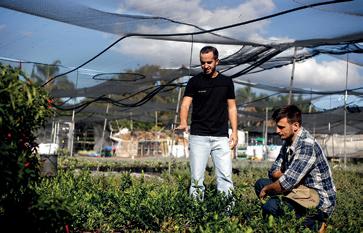 By Dr. Sagi Katz, VP Agronomy at Agmatix
By Dr. Sagi Katz, VP Agronomy at Agmatix
When looking to increase crop yields, a stable biological environment is the ultimate goal. Environmental needs vary from crop to crop, but the one constant is that each crop has an optimal environment to support maximum yields and crop quality. Creating and maintaining this environment is key to a successful farm.
The biological environment encompasses many sub-factors, such as soil health, water retention, biodiversity, and chemical composition, just to name a few. With so many factors at play, it can be hard to know where to start, and which should be the priority.
We can’t determine what to prioritise without communication. Trees show the value of communication, transferring food, water, and information with other trees through underground fungus mycelium. To ensure that our businesses thrive, we must also transfer knowledge and communicate more as an industry. What’s more, this communication of data on a global scale will enable us to be more sustainable and help us to solve global food poverty.
Just like the trees, farmers have been sharing knowledge through conducting field trials and sharing their results with fellow farmers. Driven forward by the need to comply with new regulations, increase yields in a sustainable way, future proof the farm and drive profitability, more and more farmers are looking at data as a solution. By considering available research, including data gathered through individual field trials, we can determine which factors have the largest effect on yield and crop quality. In time, this data can be aggregated on a regional, national or international basis.
Conducting a field trial can be a complex undertaking, leaving

one to question where to start, and what factors to prioritise. As the medium in which you grow your crops, and the factor most likely to determine crop quality and yield, soil health is the most important element to consider. When looking to assess this, the best indication is biological activity in the soilotherwise known as biodiversity. A highly biodiverse environment brings many additional benefits, ultimately improving yield and crop quality.
When looking into soil health, an important factor to measure is chemical composition. This can be relatively quick and easy to improve through the correct nutrition plan, so it is a great place to start. That said, it does depend on the chemical you’re looking to alter. For example, increasing the amount of carbon in the soil is much harder than increasing nitrogen.
Once results are gathered, the most effective way to begin implementing changes towards optimising your soil nutrient balance is through the use of an agro-informatic tool. These tools can determine the right amount of chemical fertilizer and optimal application time, factoring in all the variables of your specific field.
These tools can also advise growers on farming practices which will aid the development of a highly biodiverse environment, such as no till agriculture, or the cover crop approach. Biodiversity and its benefits vary greatly depending on the organism present. However, one overarching theme is that the presence of one organism encourages the presence of others, creating a positive ‘snowball’ effect. A natural bio stimulant, it’s an important factor for farmers to consider.
If you get the balance of this ecosystem right, yields will increase year on year, and carbon emissions will simultaneously decrease. Agro-informatics tools can provide information on the impact these regenerative farming practices, and the biodiversity benefits they bring, will make on yield and crop quality. Not only this, but they can help to track carbon emissions, allowing farmers to more easily make use of carbon credit schemes.
In agriculture, the decisions you make today will have a lasting impact for months, and even years down the line. So, it’s important to drive your decisions with high-quality data, collected
through well planned, accurate field trials. There’s no better way to obtain specific data about your farm than to conduct your onfarm experiments. Companies like Agmatix can help you to achieve that with minimal disruption to your business and daily routines, with insights that can be easily extracted.
Ultimately, if we are to ensure the long term success of the industry, as well as reduce our impact on the environment in a meaningful way, we must also share this data with fellow researchers and farmers through open data programs –communication is the key!
Dr. Sagi Katz is VP Agronomy at Agmatix, an agro informatics company which offers data-driven solutions for ag professionals worldwide. Their cutting-edge technology platform uses agronomy data science and advanced AI technology to convert agronomic data into actionable insights at field level. Recently adding a field trial app to their portfolio, Agmatix have simplified the organising, conducting, analysis and sharing of field trials by providing a simple platform through which all processes can easily be managed.
www.farmingscotlandmagazine.com ARTICLE
73
Farming family advocate for agriculture and win industry award

After graduating as an accountant, Claire Pollock returned to the family farm to support her family and future development of their business. The Pollock family always enjoyed farming and plans to keep the business viable led to changes in production methods, aiming to reduce costs whilst also looking for diversified income opportunities by selling the farm’s beef direct to customers. The family also recognised a gap in the public’s knowledge of British food production and felt it was important to tell people about farming.
When their beef demand exceeded expectations, a vision and desire to supply local food
to local people was born, and Ardross Farm Shop established in 2005. The plan was to try growing what they could, for sale through the shop. With no retail experience, the family researched everything they planned to do, including starting the farm’s flock of low input, EasyCare sheep, generating grass-fed lamb and mutton. With consumer demand for high health and welfare, grass-fed beef, the Pasture for Life certified Stabilisers slowly replaced their continental cattle.
Winter wheat and barley, oilseed rape, spring barley and beans, are farmed regeneratively on a five-year rotation, with cover crops grazed by livestock
in between. A growing number of beehives are nestled between OSR and bean crops, with bees pollinating wildflower meadows and producing honey to sell in the farm shop.
Constantly looking to improve, heritage cereals are being trialled on the farm, where Hebridean bere barley and black oats are grown alongside apple trees in the walled garden, Claire explains, “Heritage grain experts, Wendy Barrie and Bosse Dahlgren, are working with us to try growing grains that will taste good and make delicious bread and oatcakes. We are harvesting them using traditional methods and nutrient testing the grains before deciding our next steps.
“People are learning that food is important to their diet but are very busy,” she continued, “establishing the farm shop not only gave the surrounding community and holiday makers access to locally produced food, but it also generated a direct link between farms and the food we eat. We also enjoy the face-toface conversations and hearing how much people appreciate our produce, which supports our mental health when farming can sometimes feel a rather lonely occupation.”
The family realises the talent and dedication of staff members employed by Ardross Farm Shop and saw applying for the AgriScot Diversified Farm of the
people
www.farmingscotlandmagazine.com 74
Year Award, as an opportunity to publicly recognise their team, and thank them for their support and hard work over the last 15 years.
On winning the award and their plans for the future, Claire said, “We are thrilled to have won the AgriScot Diversified Farm of the Year Award, learning that we are on the right track and hearing the judge’s feedback was confirmation that we are doing well. Ardross Farm Shop’s operation is a team effort, and the award has given our wonderful staff a real boost. We enjoy what we do, and we plan to do it better by expanding the farm shop and the offerings from our kitchen, growing more of our own vegetables, and trialling new varieties, whilst continuing to work with local businesses and raising the profile of the Scottish local food network.
“We are customer focussed and aim to build on the relationships and trust created between farmers and the public, bringing the story of agriculture to life by welcoming people to see what we do, hosting food fairs to promote wonderful local food producers, offering tours of our farm and using social media to showcase the business internationally.”
Claire concluded, “Meeting other farmers during our journey with the Award has been encouraging and inspiring, giving us ideas on how to improve. We are proud of what we do, and we are constantly learning. I am looking forward to judging the entries for this year’s award and encourage anyone considering entering, to enter.”
Applications
for
the 2023
AgriScot Diversified Farm of the Year award are now open, to find out more and see a full list of categories, visit www. agriscot.co.uk
The UK Government not doing us any favours
By Martin Kennedy, President, NFU Scotland

The UK Government decision to once again ‘kick the can down the road’ on introducing post-Brexit border controls on animal and plant products imported from the EU has justifiably angered and appalled the Scottish food and farming sector.

It is a decision that seriously disregards the interests of our home food producers in favour of a cheap food policy that encourages asymmetric trade and it flies in the face of commitments made at the ‘Farm to Fork’ summit in Downing Street in May.
A formal announcement on the delay will bring a fresh timescale for introducing border checks and controls. However, the UK Government’s lax approach to border controls continues to leave farmers and crofters exposed to the introduction of devastating animal and plant diseases such as African Swine Fever.
It also leaves our food and drink exporters jumping
through the hoops of a full border check to get our produce into the EU while those sending their goods here from Europe continue to do so at a competitive advantage. This continuing asymmetric trade devalues any claims lauding the Trade and Cooperation Agreement by the UK Government. For the UK Government to delay Border controls for a fourth time is seriously disappointing. Since January 2021, we have been reassured on several occasions that a robust, reliable system delivering proper border checks on food, with additional measures verifying the health and safety of meat products will be delivered. The most recent legislative timeline, announced only a few months ago, that would have had a new Border target operating model (TOM) rolled out from October 31, with physical checks on imports starting in January 2024 and a full regime in place
by October 2024, is to be missed.
The longer there is no effective system in place, the greater the distortion of the market for UK producers – with importers facing less bureaucracy and cost than those looking to export produce from the UK to EU - and the longer our borders are left open to the potential introduction of plant and animal diseases.
We understand that the UK Government will shortly set out the new timetable for the import regime, to finally deliver a level playing field for UK farming, food and drink sectors. Regrettably, there will be little confidence amongst industry that the timetable will be adhered to.
And while we are discussing Brexit impacts, let’s not forget the immediate impact of the deal that saw a ban on valuable exports of seed potatoes to Europe also remains in place, and continues to deny our growers access to that important market.
www.nfus.org.uk
Scotland
NFU
people www.farmingscotlandmagazine.com 75
Inclusive Farm to give disabled young people new opportunities in Scotland and find out more about upcoming Women in Agriculture Scotland events
After headlining as guest speaker at the Women in Agriculture Scotland (WiAS) breakfast at the Royal Highland Show, Mike Duxbury from Inclusive Farm is seeking partners to support the development of a farm in Scotland. Inclusive Farm aims


to provide young people with disabilities with a route into agriculture.

Founded in January 2021, Inclusive Farm, which is based in Bedfordshire, was set up by Mike Duxbury and Ness Shillito. Each week they welcome students with
diverse needs onto their farm and give them the confidence and skills to pursue a worthwhile and fulfilling career in agriculture.
Mike, who lost his sight at age six, wants to provide the same opportunities to young people in Scotland.
“90% of blind people, and 78% of autistic people, are unemployed – but it doesn’t have to be like this. We’re seeing firsthand the impact of providing skills such as animal husbandry has had on the young people visiting Inclusive Farm.
www.farmingscotlandmagazine.com 76
“Our vision for has always been simple: there are disabled people across the United Kingdom, and we plan to develop Inclusive Farms in Scotland, Wales and Northern Ireland.
“We now have the opportunity to achieve this in Scotland and we want young people to be in the driving seat. Too often disabled people are told what they need, and we are determined that their voices and needs are met.”
Inclusive Farm is seeking likeminded organisations to partner with the project.
Dr Jenna Ross OBE, a Scottish environmental scientist, agricultural researcher, STEM Ambassador and EDI Champion, strongly encourages businesses and industry to support the project.
“Labour is one of the biggest issues plaguing our industry, but there is a demographic that is constantly overlooked.
“A golden opportunity is now available for partners to come forward and help be part of a project which is pioneering an inclusive approach to agriculture.”
Young people are encouraged to register their interest, and businesses interested in partnering the initiative should do so by emailing Mike via: info@ inclusivefarm.co.uk
Anyone – man or woman – is strongly encouraged to get involved with the WiAS network. Two more events are planned for 2023 with a regional event in Ayrshire in on 7th September to visit The Coo Shed, network with attendees and hear from an exciting guest speaker.
The Coo Shed was opened in April 2017 as an ‘add-on’ to the already successful and well established plant nursery, Corton Plants.
Set in the rural Ayrshire countryside on South Corton Farm, the Coo Shed has proven to be a very popular destination for many.
With its warm and inviting interior, it is the ideal place for the WiAS network to come together, meet friends old and new and learn a few skills all while enjoying a hot homemade lunch and some and mouth-watering cakes.
Finally, the WiAS AGM will be held on Wednesday 8 November at The Den at Culross. This is an opportunity for our members to hear from the committee about the year’s achievements as well as from some cracking guest speakers. Themed: Biodiversity and Banter, the event will welcome guest speaker Dr Jenna Ross OBE
As a farmer’s daughter from Aberdeenshire, Jenna has a passion for driving innovation in agriculture. Jenna holds a PhD in Environmental Science, as well as an MBA, and has more than 10 years’ experience working on various international projects across North America, Europe and sub-Saharan Africa.
She has completed a Nuffield Farming Scholarship, winning the Nuffield HSBC Silver Salver award in 2020, and is now the current Chairman of Nuffield Scotland. Jenna is also a Director of the Oxford Farming Conference, Honorary Fellow at the University of Aberdeen, Chartered Manager and Fellow of the Chartered Management Institute, Associate of CARAS, founding board member of the Africa Scotland Business Network and Co-Chair of the IOBC Slug & Snails Group.
Jenna is highly published and has won an array of business and agricultural awards. She is also passionate about inspiring the next generation of agriculturalists through her work as a STEM ambassador, LANTRA industry Champion and Lead on the OFC Scholars programme.
To register for either event, head to the WiAS website – www. womeninagriculturescotland. com – or via our social media channels.
Southern Belle
THEY DON’T MAKE THEM THE WAY THEY USED TO….

The final Ford Fiesta has rolled of the production line and it feels like the end of an era. This wee car was the go-to for many youngsters, starting out either as a mum share or their first car. While I had two fiestas in my life, The Speed Wagon and Baby Jane, my first car was a Triumph Herald with red leather seats, then worth about £250, now worth around £25,000! If only I’d kept it. Next, mum and I upgraded to a Triumph Herald Estate, which had two added advantages. You could start it with a lollypop stick, if you lost the keys and it acted as the team bus for the Carluke YF netball team. Many more cars would follow but none were ever named and none were quite the same as the Fiestas.
Another end of an era came this week in the shape of my mother’s freezer, which my father “procured” from Iceland (the shop not the country) during a refurb in the 1980’s and is still going strong today. The freezer has always been full to the
brim, in case we got snowed in, which hasn’t happened since 1967. The car too, has always been filled to the brim in case of emergencies, although it is hard to imagine what constitutes an emergency requiring a 350-mile drive by an 88year old woman! Anyway, we set about removing the contents, including a box of gooseberries picked in 2004! Something my father enjoyed but the rest of us avoided like the plague and while my mother was truly mortified, the rest of us found it hysterical and a good laugh was had at her expense.
So now we have an empty 40-year-old enormous freezer in good working condition, free to anyone who can figure out how to get it out of the old garage, which originally had a large double door and now has a brick wall. The “new” 3 feet door being operated by a 6-inch nail and a piece of binder twine!
The legacy of a DIY father, which crops up occasionally and make us smile. Some things will never change.
www.farmingscotlandmagazine.com Women in Agriculture Scotland
77
Iconic deer in the crosshair
By Jake Swindells,
Director for Scotland

Scottish Countryside Alliance
A common theme these days is the ongoing battle that the rural sector has with the Scottish Government. Everything seems to be a fight when all that is required is a bit of support and some sensible legislation. Is that really too much to ask? One thing that we do agree on is that deer numbers need to be reduced so that the damage caused by over-population is limited and can remain at a manageable level. ScotGov have targets to reach and we need a well thought out planting plan in place, and
the trees that are planted need to be protected. Overgrazing is an issue with the increase in deer numbers, as is the Tick population. Year on year Ticks seem more prevalent and this year is no exception. So how are we going to better manage deer numbers in Scotland?
Recently, rural stakeholder organisations were asked to comment on proposed legislation that is to be introduced in order to tackle the rising deer populations. Whilst this engagement is a very welcome step, parts of it
seem to be way off the mark and verging on preposterous. There are three elements to be considered and the SCA responded with deer welfare at the forefront of the argument.
The first, and by far the most controversial point is the opening up of the male deer season so that all male deer can be shot yearround in Scotland. There is a thought process that this will be an easy fix and an effective way of reducing deer numbers quickly. In reality, it will not have the


desired effect and will only serve to increase pressure on the likes of the iconic Red Stag. This proposal would allow the shooting of stags as they recover from the rut, where they will have lost a significant amount of weight and be in a relatively poor condition compared to just a few weeks before. This is a time when they need to be left alone so that they can build body weight and bulk up before the harsh conditions of Winter hit. When venison should be promoted as a healthy, sustainable and

SCOTTISH COUNTRY LIFE
www.farmingscotlandmagazine.com 78
Jake Kahles spotting
Jake Swindells
Howa at dusk
organic meat, it will be presented to food outlets in a very poor condition, rendering it little more than a pest species to be culled. Allowing the year-round shooting will ensure that they never get a break and are pushed away from the ground that they know will provide shelter and food. There may also be an increase in traffic collisions as stags are forced into unfamiliar areas seeking respite and the continued pressure will be moving the issue onto someone else’s ground, rather than it being effectively dealt with. What is required is a better approach to deer management. Better and more effective ways to manage female deer numbers as these are, afterall, the ones who add to the population. It is key that ScotGov properly engage with deer management groups and draw on the expertise of those on the ground, rather than implementing what they perceive to be a quick, easy fix following a light-touch, paper exercise consultation. What ScotGov are proposing will only cause the deterioration of the health and welfare of the herd, undoing decades of hard work and wasting millions of pounds in the process. Ironically, responsible for this blood thirst is Scottish Green Party Minister Lorna Slater, who often gives the impression that she wants to see an end to the killing of animals. I wonder what her constituents might make of this!
The UK is in a transitional period where ammunition is concerned. EU regulations mean we must seek lead alternatives for anything that may enter the food chain. This has proven to be a tricky process and complications have arisen with the UK’s most popular rifle calibre, the .243. As it stands, the minimum legal bullet weight to shoot deer in Scotland is 100 grains, but it has proven
very difficult for this weight of bullet to be stabilised in flight. An alternative is to allow the use of a slightly lighter bullet that is more easily stabilised and widely available, so the proposal aligns with England and Wales in allowing an 80 grain bullet to be used. Some have concerns over whether this is enough to effectively kill large deer but, looking at the evidence south of the border, it is generally accepted as a solution to a difficult problem in Scotland.
Shooting deer at night is another way that deer populations may be reduced. Current regulations state that you may only shoot deer in daylight hours, including an hour before sunrise and an hour after sunset, unless under licence. The advancements in technology means that we now have a number of options to enable us to shoot at night but, if implemented, this would have to be carefully regulated and planned. There is a general acceptance of night vision equipment being used, providing certain control measures are in place. Current thinking is that thermal scopes (which show heat signatures and less detail than night vision scopes) should not be widely used. Additional training should be introduced, such as a module in the existing DSC1 deer stalking course, a minimum level of competence (such as those registered on NatureScot’s Fit and Competent Register) and an addition to the Wild Deer Best Practice Guides, which are freely available online. Government officials can’t ignore that this shows a willingness from the rural sector to work with the Scottish Government in achieving a common goal, with self-regulation, welfare and safety at the heart of the decision making.
To keep up to date with our Scottish Campaigns, sign up to our Heather Routes newsletter online.

Catch our roadshow
By Scottish Government Cabinet Secretary Mairi Gougeon

Summer sees communities coming together at agricultural shows and events to catch up with friends, share news and celebrate rural life. Visiting these shows and meeting farmers and crofters each summer is one of the best parts of my job. Being back at the Royal Highland Show in person this year was of course a highlight, and last month I had the opportunity to visit some truly innovative rural and island businesses – including Farm Ness, Isle of Mull Cheese, and the Scottish Pantry Network.
This year, Scottish Government is taking an agricultural reform roadshow to shows, marts and area offices across Scotland speaking to farmers and crofters about how they can get ready for changes to agricultural support that begin in 2025 and hearing their views and ideas. With events from Orkney to Oban and the Black Isle to the Borders, our agricultural officers are there to talk about the changes coming in and the support available now to help farmers and crofters prepare. This includes support towards the
cost of conducting carbon audits, soil analysis and towards animal health and welfare activities.
In July, I had the chance to join Scottish Government colleagues at visit the Border Union Show, talking to local farmers about how support is changing and what they are doing now. It was a great opportunity to hear colleagues share the questions and conversations they have been having over summer and to speak to farmers and crofters about how their own plans and ambitions for their businesses.
In addition to the roadshow, we have produced a route map for change, leaflets, guidance, how to videos and case studies which can all be found on the rural payments website in the Agricultural reform section. The roadshow will run until the end of the year with more dates to be added in the coming months. We hope to see as many of you as possible at these events which will also run in 2024 as the changes approach, and I urge all farmers and crofters to start to prepare now using the support available for their businesses.
www.farmingscotlandmagazine.com 95
Beatha an eilean

Àrd-oifear ùr dha Caidreachas
Croitearachd na h-Alba
Le Murray MacLeòid
Chaidh tè a b’àbhaist a bhith ann an àrd dreuchd aig Coimisean na Croitearachd ainmeachadh mar àrd-oifigear ùr Caidreachas Croitearachd na h-Alba (SCF).
Buinnidh Donna Nic a’ Ghobhainn do Shiorrachd Rois agus chaidh a ràdh g’eil eòlas fhada aice ann an gnothaichean croitearachd is poileasaidh agus ged a bha i aig a’ Choimisean fad bliadhnachan, tha i air a bhith ag obair san roinn phrìobhaideach bho chionn ghoirid, an dèidh dhith a’ bhuidheann fhàgail son companaidh comhairleachaidh a’ stèidheachadh.

Tha i a’ gabhail a-nall bho Phàdraig Krause a dh’ainmich na bu thraithe g’eil e seasamh sios mar àrd-oifgear an SCF san Damhair.
Dh’ainmich a’ bhuidheann g’eil cathraiche ùr aca cuideachdIonatan Hedges, croitear à Cataibh - a’ ciallachadh gum bi sgioba gu tur ùr os cionn na buidhne a-nis.
Thuirt Ionatan: “Chur mòran a-staigh airson na h-obrachd agus rinn sinn agallamhan le grunn dhaoine gu math comasach, ach mar a tha fhios aig a h-uile duine, tha e tighinn sios gu aon neach agus bha sinn gu h-aona-ghùthach dhen bheachd gum bu chòir a thabhann do Donna, agus gabh i ris.”
‘S ann à Baile Dhubhthaich a tha i agus mus do dh’fhàg i a’ Choimisean bha i ann an dreuchd na h-iar àrd oifigeir. Bha i ag obair dhaibh fad ochd bliadhna, mus do dh’fhàg i son a companaidh fhèin a’ stèidheachadh.
Mus deach i chun Choimisean bha i ag obair ann an Roinn an Aiteachais dha Riaghaltas na h-Alba, gu sònraichte a thaobh dèiligeadh le pàighidhean.
Thuirt i: “An dèidh a bhith ag obair air poileasaidh croitearachd fad iomadach bliadhna, agus le bhith a’ ruith a’ chompanaidh agam fhèin agus air bùirdstiùiridh grunn bhuidhnean cathrannas, tha mi an dòchas an t-eòlas sin air coitearachd agus a-thaobh a bhith a’ stiùireadh bhuidhnean a thoirt chun na h-obrachd ùr, inntinneach a tha seo.
“Tha iomadach dùbhlain ma choinneimh croitearachd a-thaobh a bhith a’ cruthachadh poileasaidhean ann an Alba agus le sin feumaidh guth laidir a bhith againn a bhruidhneas as leth croitearan agus croitearachd.

“Bidh e na phrìomhachas dhomh-sa ballrachd na buidhne a leudachadh airson dèanamh cinnteach gun faigh guth nan croitear èisteachd cheart.”
Tha sin gu bhith buileach cudromach anns na deasbadan ri thighinn timcheall Bile Aiteachais ùr a tha an ìmpis crathadh nach beag a thoirt air mar a tha croitearan is tuathanaich a’ faighinn taic san àm ri teachd. Ged a tha an deasbad air a bhith dol airson deagh ghreis a-nis, tha fhathast mì-chinnt mòr ann.
Tha i a’ gabhail a-nall bho Phàdraig Krause a tha air a bhith ann an dreuchd àrd-oifigear an SCF corr air fichead bliadhna, àm a tha air a bhith air leth caochlaideach ann an diofar dhòighean, dha croitearachd agus dhan bhuidheann fhèin.
Chaidh turastal de £35£40 a chur ma choinneimh na dreuchd agus nuair a chaidh na sanasan an cur a-mach bhathas ag iarraidh daoine a bha air an oideachadh gu ìre ceum ann an cùrsa freagarrach, eòlas a bhith aca air stiùireadh bhuidhnean gu àrd-ìre agus ùidh làidir ann an croitearachd agus a’ Ghàidhealtachd is na h-Eileanan.
“‘S e àite beòthail, adhartach a tha ann an Alba agus sinn a’ coimhead ri siostam ùr àiteachais a chruthachadh a tha nas bàitheil dhan àrainneachd agus crathadh a thoirt air mar a tha sinn a’ cleachdadh talamh.
“Tha na rudan sin a’ dol le chèile agus tha croitearachd aig a’ mheadhan, le modhan obrachd fearann a tha cumail daoine ann an coimhearsnachdan agus a’ cruthachadh biadh a tha faisg air nàdar.
“Tha croitearachd math dha daoine, math airson stuth àrach agus math dhan àrainneachd agus bidh e na onair dhomh-sa obair as leth croitearan is croitearachd.”
www.farmingscotlandmagazine.com 80
www.stornowaygazette.co.uk
Buinnidh Donna Nic a’ Ghobhainn ri Baile Dhubhthaich
Prime arable land for sale in Aberdeenshire
Galbraith is bringing to the market a block of Grade 3.1 arable land devoted to regenerative agriculture in the renowned Howe of the Mearns valley, Aberdeenshire.

The farmland extends to approximately 269.86 acres (109.21 hectares) of predominantly Grade 3.1 arable land. There are areas of more productive Grade 2 on the east side, with areas of Grade 5.3 on the fringe of the Esslie Moss to the north.
The land at Moss-side of Esslie sits on the fertile valley floor of the Howe of the Mearns, known for its productive agricultural land.
Iain Paterson of Galbraith said: “This is a rare opportunity to purchase land that has been farmed under a regenerative farm policy for more than a decade. The land is in good heart and will be rich in organic matter. No potatoes have been grown on the land in over 12 years. There is good access to all the fields via a network of well-maintained farm tracks and several of the fields are bordered with hedgerows, providing connected habitats for wildlife. This sale represents a perfect investment opportunity or as a useful bolt-on to an existing holding.”
The Howe of the Mearns is renowned for its highly productive agricultural soils with soft fruit, potatoes and vegetables all commonly featuring in crop rotations.
The vendor is an active member of the ‘Soil Regenerative Agriculture Group’ as part of the wider Farming for a Better Climate group. As a result of
this careful land management the land at Moss-side of Esslie will be of an excellent standard, being rich with organic matter and in good heart. Furthermore, the land is free of pests such as Potato Cyst Nematode (PCN) and Clubroot. Soil sampling results are available from the selling agents.
The farm has an extensive network of internal tracks that have been well maintained, are in excellent condition and provide access to all of the fields.
The unit is ring fenced and a number of the field boundaries form extended hedgerows which provide an important habitat for local wildlife, complementing the regenerative agriculture practices that have been adopted.
The land consists of Balrownie Brown Earth soils and Mineral Alluvial Soils.

According to the James Hutton Institute it will be capable of supporting a wide range of crops due to the quality of soil and drainage in place; the land
has supported a range of cereal crops.
The land is located in Aberdeenshire within the highly productive area of the Howe of the Mearns. The town of Laurencekirk, about 6.5 miles away, offers local village amenities and a train station while the A90 dual carriageway is just a couple of miles from the land.
The land at Moss-side of Esslie is for sale through Galbraith for offers over £2,250,000.
www.farmingscotlandmagazine.com 81 estate
Two new outdoor products to keep you warm from Torimor

Long-line fleece – perfect for early mornings or late evenings out on the farm and hills, long lined to keep the elements out, detachable hood, the perfect combination of warmth and style. Great for walking the dogs, riding, shooting, fishing.


New Colour launch – we are launching our incredibly popular ladies and gents jackets in Coyote this Autumn. Perfect for out on the hill working, walking dogs, stalking or just enjoying the views. Manufactured and designed in Britain from sustainable material designed to withstand the harshest of conditions.

estate www.farmingscotlandmagazine.com 82
Burncastle Estate awarded prestigious Wildlife Estates Scotland accreditation


The Duke of Northumberland’s Burncastle Estate near the Lammermuir Hills is the latest landholding to have been awarded prestigious wildlife recognition to acknowledge its outstanding conservation work.
Wildlife Estates Scotland (WES) accreditation was presented to the estate at the Border Union Show at Kelso this weekend.
Burncastle Estate spans more than 9,000 acres and is a mixed-use estate with integrated farming, forestry and country sports operations.
The estate and its staff are involved in a variety of different conservation projects and habitat management schemes to allow biodiversity to flourish.
For some time now, the estate has collaborated with the Butterfly Conservation Trust and, through their monitoring, recorded an increase of 20 moth species (micro and macro) identified between 2020 and 2022. With a total species list comprising 220 species, the longterm monitoring taking place there is crucial for understanding species resilience in the face of increasingly unpredictable weather conditions and climate change.
Recently, the South of Scotland Golden Eagle Project announced that Burncastle Estate was the first to host two new artificial eyries on its land. It is hoped the eyries will help support the restoration of golden
PARTRIDGE project influencing future agri-environment scheme in Scotland
By Fiona Torrance, Farmland Biodiversity Adviser, Game & Wildlife Conservation Trust in Scotland and Scottish PARTRIDGE project manager
The EU Interreg PARTRIDGE project started in 2016 and one of its objectives was to use the findings from research and monitoring to influence the design of agri-environment schemes in each of the participating countries. This has included beetle banks in Belgium, the PARTRIDGE mix in Germany and the wildlife plot in England. In Scotland this objective has been particularly challenging until the publication of the Scottish Government’s draft Agricultural Reform Programme earlier this year.
The PARTRIDGE team in Scotland has worked hard to increase the allowed duration for an established wild bird seed mix which under the current AECS scheme, could only be established for one year before being moved elsewhere. However, many of the species in the specially designed PARTRIDGE mix only appear in year two, and it was therefore unable to deliver all its potential benefits to
wildlife if sown as an annual mix.
But the Wild Bird Cover measure in the draft Agricultural Reform Programme is now listed as providing resources for biodiversity over two to three years, depending on the mix. This means that mixes like Kings Interreg Grey Partridge mix would last for a number of years, ensuring that the habitat is able to provide nesting, brood-rearing and predation cover for grey partridges and many other farmland species, as well as food during the winter months.
This change has been achieved by the Scottish PARTRIDGE team working with NatureScot. As well as being on the steering committee for the project, we also invited NatureScot’s agricultural team to visit Balgonie in Fife to discuss the project and speak with the farmer. Going forward, we will continue to work with them on the new PepsiCo Farming
Arable Biodiversity (FAB) project and look forward to testing new tools they are currently developing for the reform programme.
As seen from the work at Balgonie and other PARTRIDGE demonstration sites, this habitat type delivers many different benefits for farmland biodiversity if left in place for the right amount of time so it can provide benefits for farmland birds, pollinators, small mammals and other species. We are excited to see how it can deliver for wildlife, as well as farmers across Scotland.
Although the programme is still in draft form, it is hoped that the work already undertaken, and now continuing at Balgonie definitively demonstrates that this habitat type delivers for biodiversity.
More information about the Interreg North Sea PARTRIDGE project at: https://northsearegion.eu/ partridge/

estate www.gwct.org.uk/auchnerran/
PARTRIDGE mix at Balgonie in 2022
Photo by Amy Mason
Sustainable and regenerative agriculture
By Eleanor Kay, Senior Policy Adviser
(Agriculture & Climate Change) at Scottish Land & Estates

Scottish farming’s frustration with the vague post-2026 support framework persists. The upcoming Agriculture Bill, though anticipated, won’t clarify matters as it’s a framework bill, leaving specific details for later legislation. However, the urgency of climate change compels proactive planning, irrespective of Tier 1 and Tier 2 conditions.
It is increasingly clear that global warming is unlikely to be limited to 1.5 degrees centigrade - and even if it is, there will still be considerable changes to the environment Scottish farmers have to work in.
Doing nothing is not a sensible business approach but that doesn’t mean we must rush to make changes. Instead, we want to see farms making the most of the transition period in the Agricultural Reform Route Map. Farmers should be using the ‘Preparing for Sustainable Farming’ scheme to aid the assessment of current farming systems and identify holding specific risks as a result of climate change and priorities to build resilience.
It is only after assessing risks and potential opportunities that farms can start to work out what work should be prioritised for the goal of resilient business
and ultimately profitability. This exercise can help farms make smart decisions when the new agriculture policy is introduced from 2026 and we are all faced with a very long list of Tier 2 options, or indeed make a start now rather than wait for legislation if it is right for your farm. This could mean improving soils, making plans for water management, planting trees where appropriate, improving livestock productivity, genetic diversity for crops or animals, disease control and making better use of data. All things which reduce emissions but more importantly for your business, have been shown to increase productivity and gross margins.
Rather than waiting for new policies to emerge, farms should utilise the tools offered by the transition to make the best plan for their farming business to shape their future resilience ahead of new policies.
We know that the Scottish Government wants to see sustainable, regenerative agriculture, but that will mean different things for each holding. We hope that the Scottish Government will understand that improved communication and flexibility will be key to the success of the future support framework and how it delivers for the national climate targets.
eagles in the region, allowing the birds to nest and raise chicks in the future.
WES is a national version of the Wildlife Estates (WE) initiative and is endorsed by the European Commission’s Directorate-General Environment, whose objective is to protect, preserve and improve the environment for present and future generations.
All types of landholdings, farms and estates can apply for accreditation and Scotland currently sits second in the league table of Wildlife Estates accredited land on 1.25 million acres, with only Spain ahead on approximately 1.6 million acres. Between them, WES accredited landholdings have stewardship of 97 nationally protected sites (SSSI, NNR) and 79 internationally designated sites (SAC, SPA, Ramsar etc).
Craig Dickman, Head Gamekeeper at Burncastle Estate, said:
“Burncastle is incredibly committed to enhancing wildlife and habitat to ensure that nature can flourish. For many years, we have been undertaking native species tree planting and drain blocking to allow for rewetting alongside moorland restoration projects and the long-term monitoring of moth species. The estate is gradually establishing a
network of continuous woodland cover and working with others so that the challenges of land management can be addressed collaboratively.
“We’re pleased to retain Wildlife Estates Scotland accreditation as it is recognition of the best practice we are striving to follow.”
Caroline Pringle, Project Manager at Wildlife Estates Scotland, added:
“It is a pleasure to see Burncastle Estate retain their Wildlife Estates Scotland accreditation. The effort they are employing to integrate and enhance biodiversity is worthy of recognition, as is their commitment to knowledge exchange.

“Burncastle is part of a group of accredited farms and estates that have followed a meticulous process to demonstrate their exemplary standards of land management – an achievement that hopefully others may replicate.
“Such work often comes at considerable private cost to businesses but such is their commitment to the environment, properties like Burncastle are willing to undertake this vital role. It is only correct that accreditation such as WES exists to acknowledge the work the estates are accomplishing.”
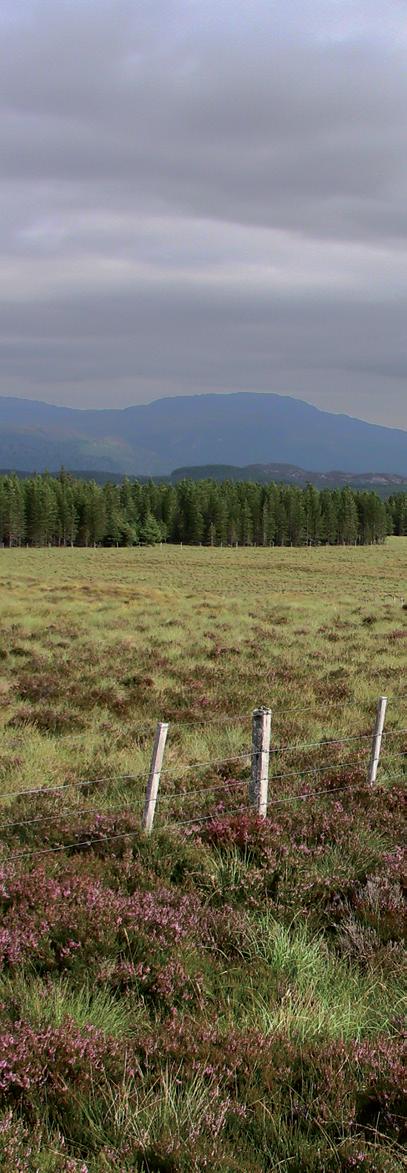
estate
information
Telephone : 0131 653 5400
For more
www.scottishlandandestates.co.uk

How Agroforestry is Benefiting Livestock and the Land

Planting trees will help farmers on their journey to net zero whilst benefitting livestock and the environment, visitors to last week’s (6 July) Down to Earth event in Cumbria heard.
Graham Watson from Cumbria Community Woodland explained how many farmers were already integrating agroforestry into their livestock systems through a network of hedges surrounding field margins and trees already established in fields, for example. However, he said more trees could be planted, with government grants available to help support agroforestry.
He said the starting point was to plan the planting and apply for
carbon credits. “There are many different ways to incorporate tree planting onto farms. You can implement alley cropping, where trees are planted in lines, allowing tractors to pass through. You can also plant field corners or consider areas of land that are less productive for planting. They can also be planted in fields in higher density planting or singularly depending on the purpose.”
The suggested number to plant will vary depending on a farm’s objectives, with a minimum of 30 trees per ha.
“By planting more trees, you are spreading the pressure of the stock when they are grazing,” he said.
The types of tree species planted will also depend on the farm’s objectives and location. “Oak, willow, ash, birch and crab apple are the main species. However, the Forestry Commissions Ecological Site Classification (ESC) will tell you the best species for your land,” he said.
Trees can provide health and welfare benefits to cattle, offering shade, shelter and feed, with some varieties, such as willow, thought to provide pain relief to livestock.
“They also help to improve water infiltration and slow water runoff,” he added.
forestry
www.farmingscotlandmagazine.com 86
MAGAZINE
FARMING SCOTLAND
Subscription page 109
Going for growth Sustainable
north-east timber business GMG Energy plants another 10,000 trees to maintain its continuity of supply

Boosting agroforestry
Agroforestry is a land management approach that combines trees and shrubs with crop and livestock farming systems. The practice delivers a multitude of benefits both for the farm and for nature.
by 50% from £3,600 per hectare to £5,400 per hectare;
• Making agroforestry funding available for planting fruit and nut and native trees;
In keeping with its commitment to a minimal impact on the environment and the natural world, timber products specialist GMG Energy has announced that is planting another 10,000 trees in a swathe of forest it owns in the far north-east of Scotland.
The latest enhancement of its strategic reserve of timber is part of an ongoing resource replenishment programme which is based on the industry standard of one-for-one, but the company has substantially exceeded that target in most recent years.
The new planting will take place on 400 acres of softwoodplanted land at Quintfall Forest, towards the east coast south of John O’Groats, which GMG Energy purchased early last year to protect future supply and increase its resilience to market shocks.
It will be overseen by forestry consultant Donald McClelland, from Caithness, who will assemble a team to undertake the
planting and will then manage the growth and wellbeing of the crop until maturity after 35 years.
Malcolm Morrison, Director of GMG Energy, said: “We are committed to replacing every log of timber that we use in our sawmill, biomass and timber products facility in the Strath of Halladale in Sutherland and this latest tranche of planting maintains that momentum.
“We are also dramatically reducing our reliance on diesel fuels with the recent installation of a solar array of more than 100 photovoltaic panels on the roof of the main production facility at the plant.
“Quintfall is just over 20 miles from our base of operation at Bighouse Farm, so it will not add to the road miles burden and planting there will chime with our wish to invest locally and provide a reliable resource for other local companies.”
It’s great news therefore that later this summer, Scottish Forestry will put in place four new measures to its Forestry Grant Scheme which will help boost agroforestry planting in Scotland.

The new measures are a direct result of joint working between Scottish Forestry and agricultural stakeholders.
One of the key measures include a 50% increase in the agroforestry grant rate and funding for biodiversity and fruit and nut trees.
The agroforestry grants boost aims to support farmers wishing to integrate trees on their farms, whilst strengthening their business through diversification.
Specifically, the four new measures to attract more agroforestry planting are:
• Increasing the grant rate for agroforestry projects
• Allowing additional protection measures for trees, to allow cattle to graze within agroforestry projects; and
• Giving farmers more opportunity to participate in agroforestry by adapting the planting thresholds.
The new measures will be introduced later in the summer so that farmers and any other prospective applicants have time to work up new projects.
The action to boost agroforestry planting is part of an overall plan to help get new planting levels across Scotland back on track as they dipped last year.
The farming community has a large part to play in helping the Scottish Government to reach its annual national woodland creation targets and to becoming world leaders in sustainable and regenerative agriculture.

www.farmingscotlandmagazine.com forestry 89
If you are using Scotland’s upland footpaths, you should really be thinking about donating money towards their upkeep.
It is easy to take our access to the mountains for granted in Scotland. South of the Border, the rules for ramblers are far more restrictive. Many countries demand fees for access to their wild land areas, like the US National Park system. Other places, like Sweden, provide excellent facilities in their wild areas, but only at a hefty price tag. Scotland’s curious mixture of excellent outdoor access and extremely concentrated land
On the beaten track
In our penultimate extract from his acclaimed new book, Andrew Painting looks at why repairing Scotland’s upland paths is a spectacularly good investment


ownership is pretty much unique in the world.
This brings both positives and negatives. Despite being a national asset, Scotland’s footpath network has no overarching managing body. Instead, its wellbeing is subject to the whims and bank balances of a whole heap of disparate landowners, public bodies and charities, though by NatureScot’s Upland Footpath advisory group plays a valuable role in establishing a coherent management strategy.
In 2017, SNH (as it was then) published figures showing that users of upland paths contribute
£110 million to the economy every year (by comparison, deer stalking brings in around £50 million, and driven grouse shooting a further £25ish million, and these are the industry’s own estimates). SNH’s upland path audit from 2017, which incorporated information from ten different organisations, gives a good overview of the cost and scale of upland footpath maintenance, and deserves to be quoted extensively:
“Around 700 kilometres of paths have been repaired and restored over the last 30-40 years and the study has identified a
further 410 kilometres that are in need of repair. An initial estimate of between £27 and £30 million is required for capital investment to secure and enhance the benefits of these paths to the nation, its people and the visitors who come to enjoy Scotland’s mountains. The investment would, over a ten-year period, provide stability to a fragile industry and secure upwards of 40 skilled jobs in rural areas (not accounting for any multiplier effects). This investment would help to sustain and nurture the estimated £1 billion [my italics] of value contributed by upland paths to the
www.farmingscotlandmagazine.com 88 BOOK SERIALISATION
Winter in the Cairngorms. ‘An avalanche can wipe out thirty grand’s worth of work in a few seconds,’ says Paul Bolton who looks after more than 100 miles of paths across the mountains.
economy over the same period . . . This study has also estimated, for the first time, the likely resource requirements and employment opportunities to sustain the management of Scotland’s upland paths. This will be an incremental cost during the major repair phase which would reach approximately £400,000 per annum to maintain 1,100 kilometres of upland path and provide long-term skilled employment opportunities for at least 20 people.”
£30 million, to secure £1 billion in value? If the figures are startling, then it is because the great benefits created by our footpaths can be realised so cheaply.
Maintaining upland footpaths is truly a Sisyphean task, and Paul Bolton is the man on the ground managing the hundred-odd miles of footpaths that crisscross Mar Lodge. I’m a fairly quick walker, but Paul is one of the few people I would struggle to keep up with on the hills. He’s been part of the Mountain Rescue teams in both Braemar and Torridon, and his time in the hills has given him an instinctive ‘feel’ for the ways
that footpaths work, and the way the trust needs to work on the footpaths.
‘There’s always more to do, it’s one of those Forth Road Bridge kind of jobs,’ he says. The trust has just finished its upland footpath audit, which involved assiduously mapping and assessing every metre of its 400 kilometres of footpaths across Scotland. It was, he says laconically, ‘quite a big piece of work.’
Paul’s next quite big piece of work is a five-year project which aims to tackle all of Mar Lodge’s footpaths’ problem areas. The idea is that a big, strategic push will keep costs down in the long run. But this project isn’t cheap: the total cost will be around £1 million, and it will all be paid for by trust funds. In the five-year period that the project is running, Mar Lodge will expect to be visited by around half a million people. That’s £2 per visitor, spent on footpath upkeep (and might make you feel better about the £3 per day parking charge at the Linn of Dee for non-NTS members).
It’s a huge task. Paul lists off the places where work will be taking place in the project: ‘Lairig an Laoigh, Beinn Bhreac, Glen Dee, Coire Odhair, Macdui, the Braeriach plateau, the Devil’s Point, Beinn Bhrotain, Beinn a’ Bhùird, Carn na Drochaide, Bynack, Carn Liath, Carn Crom, Derry Cairngorm, Etchachan, Luibeg, Sron Riach. And of course, we did Carn a’ Mhaim and Beinn Mheadhoin this year.’ This is all on top of the regular maintenance work.

Paul next ticks off the usual difficulties of footpath work. It’s physically demanding, and finding people capable of doing this incredibly skilled, difficult work can be hard. The trust has its own in-house specialist footpath team, but there is more work across its land than they can manage themselves.
Then there is the increasing footfall on the paths themselves. ‘This is great,’ says Paul, ‘so long as it’s managed. These are really fragile environments. People want to keep to the footpaths, because most people are aware of the damage they can do to
fragile plants and soils, and let’s be honest, walking on the paths is a lot easier than going off-piste. But as land managers, our side of the bargain is to keep them in good order.’
However, working at Mar Lodge brings extra difficulties. Material is usually sourced onsite, but even then, some of it has to be helicoptered around, ‘and when you start getting helicopters involved, the costs really ramp up.’ Then there are the eagles. ‘We have to wait until the breeding season is finished before the choppers come in, or before we can work on paths that are close to their nests. That can really shorten the time we have to do the work.’ Then there’s the weather. nothing can really be done between December and March. ‘Obviously it’s a pain for the teams to be working in poor conditions. A spell of bad weather can really slow things down.’ Avalanches can wipe out thirty grand’s worth of work in a few seconds’ Even footpaths are beginning to be affected by climate change. ‘We’re beginning to see more extreme weather events. Flash flooding and heavy rain can wash away even new sections of paths.’
The trust’s footpath fund is one of their most successful ever fundraising campaigns, which is just as well, given the challenges of managing 400 kilometres of footpaths in some of the remotest parts of Scotland. For people wanting to get their hands dirty, the trust also offers Thistle Camps, week-long working holidays which mix practical conservation and days off to enjoy the hills. Paul and the team have started offering tailored ‘Mountain Thistle Camps’, which mix ranger-led walks up the mountains with footpath maintenance work.
Footpaths are a (comparatively) easy win in a sector used to tackling complicated problems. Here are projects where the impact of one’s cash can directly be seen under foot.
www.farmingscotlandmagazine.com 89 BOOK SERIALISATION
SPECIAL OFFER
10%
Readers of Farming Scotland can claim an exclusive
discount on copies of
Regeneration: The Rescue of a Wild Land by Andrew Painting PLUS free P&P in the UK. Order online https://birlinn.co.uk/product/regeneration-3/ quoting FS23 at the checkout.
You might have to pay £3 a day to park at the Linn of Dee, but repairing footpaths across places like nearby Glen Quoich costs Mar Lodge the equivalent of £2 per visitor
Gooseberry ice cream
By Wendy Barrie
Gooseberries are making a comeback - who would believe they were once 160 gooseberry associations across the British Isles alone? Known historically as the Nordic lemon - although some varietals can actually be quite sweet - gooseberries were used for sparkling and still wines, and regularly served as a sauce with mackerel, herring and duck. With a glut of gooseberries this year, I decided on gooseberry ice cream. Pure, simple and loved by all the family. I used fresh but you can alternatively use defrosted ones later in the year for a festive treat.
Ingredients:
8 egg yolks
150g caster sugar
Method:
700mls double cream
400g gooseberries
• Prepare the berries by topping and tailing, removing any wee stalks. Rinse in a colander, setting aside a few aside for garnish and placing the remainder in a pan. Add a touch of water to the base of the pan to prevent berries sticking then warm on a medium heat to allow them to soften and release their juices.
• Once soft, bring to boil and the berries will become pulp. There’s no need to strain them. Add up to 50g of the weighed sugar, sweetening to taste. The pulp should be the consistency of a thick purée so reduce a little if required or alternatively, add a little water. Set aside to cool.
• To make ice cream, heat cream in a pan until scalding hot. Meanwhile whisk yolks and sugar until pale, thick and holding a trail.
• Pour piping hot cream over the eggs, whisking together using a balloon whisk. Set over a pan of hot water and, using the whisk, swirl gently as the custard heats and thickens to a coating consistency.

• Pour custard into a container suitable for the freezer and set aside. When cool, drizzle over gooseberry sauce.
• Cover and freeze until firm for 2 hours or so then remove from freezer and work roughly with a fork to break up ice crystals as they form. Return to freezer and repeat hourly over 4 hours of freezing.
• When serving ice cream, remove from freezer ½ hour before serving (depending on the warmth of the room) to soften a little. To make ice bowl:
• Select two bowls that will nestle together with at least 1cm gap between them. Place sufficient cold water in the gap for the inner bowl to float up (plastic bowls are best for this).
• Using tape, secure the ‘floating’ bowl in a central position, ensuring there is sufficient water underneath and an even space all around. Place in fronds of herbs/edible flowers and fill up with cold water – not quite to the brim as water expands on freezing.
• Freeze overnight or until required.
• When ready to use, remove from freezer 20-30 minutes in advance to loosen the bowls and expose your ice bowl. The recipe makes sufficient ice cream to fill this generous ice bowl.
Wendy is a cook, food writer & campaigner for local sustainable produce & biodiversity.
Founder Director of award-winning Scottish Food Guide & Scottish Cheese Trail, Wendy is also Leader for Slow Food Ark of Taste in Scotland, Cooks Alliance member, IGCAT Global Experts Network member, co-founder of Scottish Bread Championship & pioneer of East Ayrshire Council’s school lunch programme. She has co-written “Meadows: The Swedish Farmer & The Scottish Cook,” with her husband, on regenerative food production.
www.farmingscotlandmagazine.com 90
 Photograph © Wendy Barrie
Photograph © Wendy Barrie
My name is Hayley and I am a self-taught artist that specialises in creating pencil portraits of pets, capturing their unique character and personalities, as well as animals of all different shapes and sizes! Having a love for animals my whole life, as well as an artistic passion for capturing moments in pencil, I decided to combine the two of them in 2017 to create Furry Portraits.

ARTWORKS
By Hayley Russell
Drawing from my studio based just outside of Glasgow, I ship my custom drawings to animal lovers all over the world. You might also catch me attending local craft and agricultural shows where I also sell a variety of prints, originals, and greetings cards.

I primarily draw from your favourite photographs, and can create your artwork in a variety of



sizes, so it will look good on any sized wall. I can also draw group portraits from multiple photos, as we all know how hard it is getting pets to sit together and face the same way!
Whether you’re looking for that special gift for someone, or a cherished keepsake, let me create a one-of-a-kind portrait of your furry friend that you’ll treasure for years to come.

You can get in touch with me by emailing hayley@furry-portraits. com, or through my website www.furry-portraits.com.
Instagram: @hayleysfurryportraits
facebook.com/ hayleysfurryportraits
www.farmingscotlandmagazine.com 92
More functions for LEMKEN front tanks
Now with single-row deactivation and liquid under-root fertilisation
The LEMKEN SprayHub front tank can now be used with the SprayKit application unit and a rear-mounted hoeing machine for band spraying during hoeing. The combination of both implements can help to reduce farmers’ workloads by up to 60 per cent. For the upcoming season, the SprayHub and SprayKit have been equipped with new functions like an electrical single-row deactivation via ISOBUS which enables row-by-row automatic section control by means of GPS. In addition, there is also a version of the SprayKit for under-root fertilisation with the Azurit precision seed drill.
The SprayHub front tank is equipped with its own controls, agitator and cleaning system.
It is ISOBUS-controlled and can be operated via the “iQblue spray” software. The SprayHub has a 1,100 or 1,500 litre tank volume and is fitted with a clean water tank, a hand wash tank and a filling filter. There is an additional induction nozzle to help break up solid materials. A CTS connection for contactless induction is also available.
Depending on the model, the SprayHub can be used for band spraying on up to 28 rows with EC-Weeder hoeing machines. It is possible to have two nozzles per row here so that the herbicide can be sprayed from the side and under the leaves of the crops. Another area of application is for liquid fertilisation with a duck-foot share done in the immediate vicinity of the crops.
The SprayKit for LEMKEN Azurit precision seed drills with up to eight rows can be used for under-root fertilisation with a double disc coulter.
The SprayHub front tank can be flexibly combined with a wide range of different machines. The SprayKit can be adjusted to any specific application.

More performance in every respect: the XERION 12.590 and 12.650 TERRA TRAC from CLAAS

With the XERION 12 Series, CLAAS presents uncompromisingly powerful specialists in the highest
performance class for tractors. Due to be available in the UK in Spring 2024,the two models come in above the XERION 4200 - 5000
and feature the highly efficient low-engine speed drive concept 2.0, maximum power outputs of up to 653hp, the CEMOS operator
assistance system, an enormous hydraulic pump capacity of up to 537 l/min and a new spacious cab with four-point suspension.
machinery www.farmingscotlandmagazine.com 93
In addition, the TERRA TRAC models are equipped with newly developed, damped crawler tracks from CLAAS Industrietechnik –making them stronger than ever: stronger on profitability, stronger on tractive power, stronger on comfort and stronger on assistance.
The XERION has been establishing new fields of application and expanding into new market regions for more than 25 years. The two new more powerful 12.590 and 12.650 models are designed as highly efficient specialists for the toughest of draught work, such as pulling wide cultivators and seed drills as well as chaser bins. In addition to North America, central Western Europe and South America, the core target markets include countries such as Australia.

Four key development goals for the XERION 12 Series were identified during numerous discussions with customers:
Stronger profitability through low fuel consumption, low
maintenance and wear costs and high resale value
Stronger tractive power through high torque, large ground contact area, optimal 50:50 weight distribution under all operating conditions and enormous hydraulic power
Stronger comfort thanks to spacious cab with four-point suspension and excellent all-round view, damped crawler tracks for TERRA TRAC and comfortable steering behaviour
Stronger assistance via CEBIS, CMOTION, CEMOS and GPS PILOT CEMIS 1200.
The successful basic concept with a bolted, highly resilient central frame and two steering axles was adopted from the XERION 4200, 4500 and 5000 models and adapted to reflect the increased output, higher weight and larger track width. The new TERRA TRAC triangular crawler track units transfer the power gently and efficiently to the ground, while the driver enjoys an excellent

all-round view in the large, fourpoint-suspended cab. The lowspeed concept 2.0 marks a perfect synthesis between the efficient, high-cubic-capacity MercedesBenz engine and the optimally coordinated continuously variable transmission – capped by the high-performance, low-engine speed hydraulics featuring the highest hydraulic output on the market. With a maximum power output up to 653 hp and up to 3100 Nm of torque, the XERION 12 Series is currently the most powerful four-wheel-drive tractor
with continuously variable transmission technology on the market and features the familiar CEMOS operator assistance and process optimisation system from CLAAS standard tractors with CMATIC continuously variable transmission.
The new XERION 12 Series with up to 653 hp, 3100 Nm, new TERRA TRAC crawler tracks, four-point-suspended cab with perfect all-round view and hydraulic output of up to 537 l/min: strength is more than power!
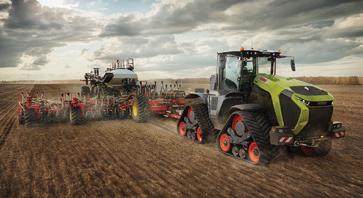
machinery www.farmingscotlandmagazine.com 94

TERRIA: More applications and even higher efficiency

Following the distribution system package featuring fertiliser boots, more equipment options are now available for all the models in the TERRIA range of Pöttinger, the trailed stubble cultivators with three or four rows. For even more applications and higher efficiency, the stubble cultivators are now available with the proven TEGOSEM flexible hopper for sowing seed and applying micro-granules. This makes it easy to combine tillage and drilling a cover crop, or applying fertiliser in a single pass. With the TRACTION CONTROL system, the weight of the stubble cultivator is shifted to the rear axle of the tractor. Less wheel slip is the result, allowing

the tractor to deliver power to the ground more efficiently.
Working efficiently is becoming increasingly important in the field to take full advantage of planting time frames in addition to meeting deadlines for sowing cover crops after harvest. The TERRIA with the flexible TEGOSEM hopper and a capacity of 500 litres makes this possible. By establishing ground cover rapidly and extensively, unproductive water evaporation is prevented. Likewise, excess nitrogen in the soil is absorbed by the plants and retained on site. Improving and stabilising the soil structure with organisms increases water infiltration while reducing the risk of erosion. By carrying
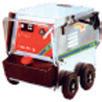
out both tasks in a single pass, the flexible hopper saves time and costs. Reducing the number of passes conserves the soil and any harmful compaction is avoided.
The flexible TEGOSEM hopper from Pöttinger is equipped with an adaptable metering shaft. This is electrically controlled depending on the driving speed, and it switches off automatically at the headland. Before starting work, the system is optimised by means of a calibration test. A hydraulic
fan ensures reliable transport of the material to the distribution plates. To ensure a uniform spread of material close to the ground and to be able to vary the application point, the angle of the distribution plates can be adjusted by twisting the shaft. The aim is to deposit the seed material in front of the rear roller or at the rear roller for optimum germination conditions. A clear and intuitive control terminal is available for operating the flexible TEGOSEM hopper.
Kubota announces GGM dealership expansion
Kubota (UK) Ltd is pleased to announce that GGM is to widen its Kubota portfolio as it expands into the agricultural sector with higher horsepower M-series tractors and R0 loaders, to sit alongside its existing groundcare business.
The extended product range is a logical step for the dealership, as it looks to broaden its customer base with a full range of Kubota tractors suited to the agricultural sector. The additional models will include
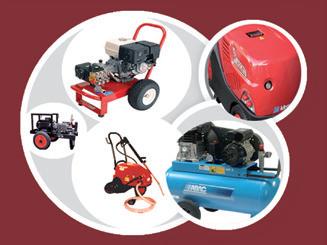
M6001 Utility, M6002 and M7003 models spanning 104175hp, plus corresponding LK tractor-loader models and R0 pivot steer loaders.
“GGM’s expansion into agriculture continues to reinforce Kubota’s commitment to its customers and the markets,” explained Henry Bredin, general manager of Kubota (UK)’s Tractor Business Unit. “GGM already has considerable M-series tractor experience,
machinery www.farmingscotlandmagazine.com 96 Manufacturers and suppliers, W Bateman & Co has an enviable reputation for manufacturing and supplying both domestic and industrial pressure washers and air compressors. The Air Compressor and Pressure Washer Specialists Nationwide DELIVERY on all orders 01772 862948 email: info@bateman-sellarc.co.uk www.bateman-sellarc.co.uk

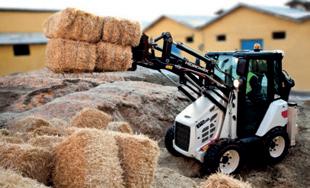


KATTRAK INTERNATIONAL LTD Newly appointed HOLP –ROTOP ATTACHMENT SCOTTISH DISTRUBUTOR & TOWMATE TRAILERS WE ARE ON THE RIGHT TRACKS Distribution, Sales, Hire Fleet, Service, Spares, Training Wheeled dumpers, tracked dumpers, excavators, telehandlers, special machinery Kattrak International Ltd is proud to be an official Scottish dealer & distributor for Sunward, Hidromek and Ausa plant machinery Kattrak offers a broad range of wheeled & tracked dumpers as well as other machinery for hire at competitive rates Ardoch Farm, Old Glasgow Road, Kilwinning, KA13 7QJ Telephone: 01294 557835, fax: 01294 554095 E-mail: sales@kattrak.com or info@kattrak.com
having delivered on sales, service and support with smaller M4003 and M5002 models to a broad spectrum of customers and industries.”
As a specialist supplier of tractors and high-quality professional groundcare machinery, GGM has a long-standing

Maschio Gaspardo Chrono 500 offers variable row spacing
business relationship with Kubota which spans more than 45 years. Based in Colne, Lancashire, with a second depot at Haydock, Merseyside, GGM will be accessible to agricultural customers throughout Merseyside, parts of Lancashire and West Yorkshire.

The Chrono 500 is a mounted machine which has a key feature that sets it apart from anything else. It can be set up to run with variable row spacings and is equipped with either 8 or 12 planting units, making it suitable for sowing a range of crops with 45cm, 50cm, 70cm or 75cm row spacings. This versatility makes it possible for the operator to switch from drilling sugar beet in the morning to maize in the afternoon, the conversion taking less than two hours.

Whether customers opt for the fixed row variant or the variable spacing option, the 500-seriesshares all the common features with the other highspeed precision planters in the Chrono range.
When it was launched in 2020, the Gaspardo Chrono brought a new level of sophistication to precision drilling. With a completely new seed delivery system, air bag suspension for
each unit and electronicallycontrolled metering for both seed and fertiliser, the Chrono range offered fast-paced precision drilling with unrivalled seed placement and depth control.
While conventional precision drills might run at 7-8kph, the Chrono has the potential to at least double these work-rates, at the same time improving the accuracy of seed spacing and depth placement.
This level of precision is all down to the design of the metering unit. Using a combination of traditional vacuum singulation and then pressure delivery down the coulter tube, the moment the seed leaves the metering disc it is kept under control. The Chrono doesn’t just leave it to gravity to ensure seed ends up in the ground, a venturi puts it under positive pressure, controlling its speed and therefore ensuring it ends up in the soil without bounce.
machinery www.farmingscotlandmagazine.com 98

Kverneland introduces Exacta CL W PRO
Kverneland has introduced a new fertiliser spreader to its line-up of Exacta twin disc models. A narrow frame model, it’s called the CL W PRO, and slots into the range below the CL GEOSPREAD version, replacing the single weigh-cell CL EW model.


The PRO specification brings more accuracy and precision over the CL EW thanks to the use of four 2.5 tonne capacity load cells in combination with a reference sensor, to improve weighing accuracy and reliability. With a full complement of weigh cells, the new CL W PRO is capable of achieving greater precision and application accuracy, through dynamic weighing. It also provides plug-and-play functionality, being ISO 11783 compatible.
Improving the technology available on this mid-spec
machine also enables the spreader to carry out basic GEOSPREAD section control functions when purchased with a licence key.
In its most basic form, the Exacta CL W PRO offers a 1300-litre hopper capacity, though it can be equipped with hopper extensions to boost carrying capacity. One extension delivers an 1800-litre capacity; two extensions create 2300 litres, and a third – the maximum available for this model –delivers a 2800 litre hopper capacity.
The CL W PRO is capable of delivering a spread width from 10-33 metres. Its two spreading discs each carry eight vanes, fed from Kverneland’s proven CentreFlow distribution system that starts the fertiliser acceleration process before it
reaches the vanes, to minimise damage to the fertiliser.
Standard specification includes a folding hopper cover, hopper sieves, mudguards

for disc and vane protection, ExactLine border spreading device, and LED road lights. Price of the CL W PRO starts from £15,910.
Avadex Application for Sky EasyDrill
New to the market, and showcased at Groundswell 2023, is a mounting kit to fit a Stocks Ag Turbo Jet 10 to a trailed Sky EasyDrill. The new mounting kit allows separate metering and accurate application of Avadex through an additional set of outlets behind the drill’s press wheel.
The mounting kit is designed to integrate with the Sky EasyDrill and consists of a loading platform, steps and guard rail to meet all safety regulations and maintain a safe environment for the operator.
The Turbo Jet on display at Groundswell is specified for the 6m Sky EasyDrill, it has been
machinery www.farmingscotlandmagazine.com 100

colour matched, fitted with a 240ltr hopper and includes an Avadex feed block metering roller, 32mm seed hoses and 10 outlet spreader plates, allowing for an even application. The Turbo Jet Avadex applicator fitting kit is also available for the 4m and 8m EasyDrill; 4m specified with a Turbo Jet 8 (8 Outlets), whilst the 8m EasyDrill is specified with the Turbo Jet 10 (20 outlets), with the option of a 400lt hopper.
For ease of operation, the Turbo Jet 10 is fitted with the intuitive i-CON Control, which allows for rates to be automatically controlled in proportion to forward speed for ultimate accuracy. When the Turbo Jet is not being utilised for Avadex application it can be used as an additional applicator enabling a fully specified drill to apply 5 products at once through 3 different outlets. Furthermore, the Turbo Jet can apply variable rates of product according to mapping data using a GPS based touch screen.
FARMING SCOTLAND MAGAZINE
Next issue out
November 2023
New 2024 Yamaha line up
Yamaha has announced a range of modifications and additions to its ATV and Side-by-Side models with new colours, features, accessories, and technology, to offer agricultural operators’ greater choice and versatility.
The Kodiak 450 and 700 ATVs both offer the option of Electric Power Steering (EPS) and Diff-Lock for greater stability on uneven ground. Special Edition (SE) specification models will offer alternative paint colours and all models will be supplied with a 10-year belt warranty and Datatool tracking devices free of charge*.
A WARN winch is also standard on all the new ATVs. Both Kodiak and Grizzly models have a towing capacity of 600 kilos. The 421cc Kodiak has a rear rack load capacity of 120 kilos, whilst the 686cc Kodiak and Grizzly models can carry 140 kilos. All the ATVs in the range can also be supplied with tracks for snow and to assist travel on the most challenging of surfaces, whilst having the added benefit of reducing compaction on wet or waterlogged soil.
The range features Yamaha’s On-Command® 2WD/4WD drive system with optional DiffLock, which will help riders on uneven and hilly ground, especially in wet conditions.
The switchable drive system is operated using a switch on the handlebars to enable operators to move between 2and 4-wheel drive as ground conditions change. This coupled with Yamaha’s Ultramatic® CVT automatic transmission and independent long-travel adjustable suspension, makes both the Kodiak and Grizzly models easier to control and more comfortable on difficult terrain.
The three seat Viking EPS Side-by-Side vehicle features a cargo bed box and an accessory mounting bar to make using spreaders, sprayers and other implements easier to manage. The 686cc Viking has double
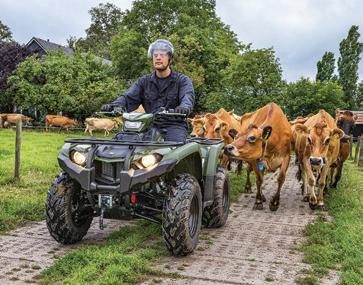
wishbone suspension and a tipping cargo bed that can carry a 272 kilo maximum load. Like the ATVs, it also features electric power steering (EPS) and switchable 2-wheel drive, 4-wheel drive and Diff-Lock.
Yamaha has also extended its commitment to operator safety by offering free ATV rider competency training from the European All-Terrain Vehicle Safety Institute (EASI®) to anyone purchasing a new Yamaha ATV. This training provides the necessary information and practical experience to operators, enabling the full features and performance of the ATV to be utilised safely in all conditions.
New
Puma AFS connect CVXdrive & Multicontroller
In the most significant revision since the introduction of Puma tractors 15 years ago, Case IH has released a full line of redesigned Puma AFS Connect CVXDrive

185-260 and Multicontroller
185-220 powershift long wheelbase tractors. Made in St Valentin, Austria, they feature a larger, quieter cab, customisable
functions, integral AFS Connect telematics, more power and a bigger footprint. The flagship Puma AFS Connect 260 CVXDrive was previewed at the 2022 SIMA and EIMA shows.
In addition to the nowestablished front-end styling with enhanced lighting, one of the most visible changes on the
machinery www.farmingscotlandmagazine.com 102
new Puma AFS Connect tractors is a new cab design. This provides 8% more volume, giving the operator more head and leg room and additional storage. One of the most significant upgrades is reduced internal noise levels of 66 decibels, among the lowest in the sector, matched by an interior which features premium automotive-style trim. There is 11% more glass area for enhanced vision and safety, and a windscreen wiper providing up to 240° of coverage.

To match comfort with control, a new Multicontroller armrest on both Multicontroller (with 19-speed PowerDrive full powershift) and CVXDrive (with CVX continuously-variable transmission) models now incorporates more features, many customisable. It incorporates a turn-and-press encoder dial that can be used if preferred as an alternative to swiping the new 12in AFS Pro 1200 touchscreen
for display navigation and feature selection. Through the terminal, the CVX transmission and front axle suspension responses can be configured, and LED-lit remote valve paddles assigned according to preference. Operation of the
AFS 1200 is supplemented by hot key quick-access buttons. A semi-active hydraulic cab suspension, adjustable to individual preferences or changing terrain, further boosts ride quality and comfort, while optional Case
IH Advanced Vehicle Suspension (AVS) enhances this further by integrating the semi-active cab suspension, rear hitch and front axle suspension, co-ordinating them via software that reacts instantly to changing surfaces.
Valtra appoint new UK dealer
Valtra UK are pleased to announce the appointment of Malpas Tractors Ltd as their new dealer covering the Lancashire region.
“Valtra in the UK continues to strengthen their dealer network by appointing Malpas Tractors Ltd for Lancashire from their branches of Lathom & Condor Green. Malpas is a longestablished family company in the Agri machinery business in the northwest of England and look forward to continued success growing the Valtra market share in this region. Malpas Tractors
Ltd will be offering the full Valtra tractor model range from 75 HP to 400+HP, along with a comprehensive service and parts back up,” states Alan Sanderson, National Sales Manager, Valtra UK & Ireland.
Today Malpas Tractors Ltd remains a family-owned

business run by Rachael, Edward and Paul Reeves with Paul being the current Managing Director.
Paul says, “Being farmers ourselves, we have long recognised the needs of our customers who want reliability, durability, productivity, and technical innovation from the
machinery www.farmingscotlandmagazine.com 103
equipment they use to meet the challenges of modern-day farming. Our partnership with franchises including Kuhn, Grimme, Merlo, Trimble Guidance, Sumo, Richard Western, Hi-Spec, Shelbourne Reynolds, Bunning, Can Am, with their ranges of tillage, harvester, and forage machinery, backed by our customer service and support has risen to meet that need.”
JCB returns to LAMMA in 2024 to showcase latest products
JCB is set to attend the LAMMA 2024 show on January 17/18 at the NEC Birmingham – with plans for an impressive display of both established and new JCB agricultural products.

In January this year, LAMMA re-established its status as Britain’s leading agricultural machinery show with strong participation by manufacturers and distributors supplying a wide range of machines and equipment, and with enthusiastic attendance by farmers, contractors and dealers.
John Smith, JCB Agriculture Managing Director, said: “We’ll be at LAMMA in 2024 with our best-ever range of agricultural machines for productive farming and contracting.
“We are the largest machinery manufacturer in Britain, with a full range of agricultural products to support the farming, commercial horticulture and other rural

industries and are delighted to announce our presence at next year’s LAMMA.
“It will be an effective showcase for our products, held
machinery www.farmingscotlandmagazine.com 104
FARMING SCOTLAND MAGAZINE Next issue out November 2023 Subscription Page
109
at the right time of year in a comfortable environment, and we are looking forward to having face-to-face conversations with existing and potential customers as we present an exciting line-up of existing and new machines.”

In recent years, JCB has invested in design and technology to continually improve its range with more productive, more powerful and more fuel-efficient machines across the board.
Newcomers include the 173hp, 50kph Loadall 542-70 AGRI Pro telescopic handler and TM 420S telescopic wheeled loader, and the 282hp JCB 457S high-performance wheeled loading shovel.
Then, of course, the new JCB Fastrac iCON tractors, which not only lead the field in comfort, speed, safety, versatility and productivity, but raise the bar even higher with the all-new iCON operating system introducing a fully configurable operator environment, integrated precision technology and superior machine control.
Alongside this activity, JCB has built a growing portfolio of quiet and compact batteryelectric E-Tech machines with zero emissions helping preserve a clean-air atmosphere on farms while slashing maintenance and running costs.
FARMING SCOTLAND
MAGAZINE
Subscription Page 109
Kubota introduces FB1000 non-stop fixed chamber, baler wrapper combination
Kubota’s baler range has been extended with the arrival of the FB1000 – a non-stop round baler wrapper combination that integrates a pre-chamber, main chamber and wrapper.

Designed and developed at sister company Kverneland Group’s baler competence centre in Ravenna, Italy, the FB1000 uses two bale chambers arranged in series, to allow a number of rollers to be shared.
Operating as a pre-chamber, the front half of the FB1000 produces two-thirds of the bale. As the pre-chamber reaches
machinery
its preset density, crop flow is diverted into the main bale chamber allowing baling to continue non-stop. The prechamber is then opened, moving the pre-formed bale into the main chamber, where it can be taken up to its maximum size of 1.25m.

Once bale formation is complete, crop flow is switched back to the pre-chamber without stopping, allowing round baling to continue as a non-stop process. Net is then applied to the completed bale in the main chamber. After which, the tailgate is opened and the finished bale is transferred onto the wrapper. This entire sequence enables baling to continue uninterrupted.To make bale transfer simple, reliable and fuss-free, the FB1000 uses a wrapper frame mounted on a parallel linkage. This enables the wrapper to be lowered from its working position to collect the completed bale as it rolls
from the main chamber. This avoids the need for a complex mechanical transfer system.
With the bale collected, the wrapper is raised to allow twin satellite arms to rotate around the bale. Unlike traditional wrapping mechanisms, the FB1000’s twin satellite arms rotate in a vertical plane. With the required number of film layers applied and the satellite arms in their parked position, the wrapper frame is lowered to allow the rear wrapper roller to be raised, gently releasing the wrapped bale onto the ground.
An ISOBUS compatible machine, the FB1000 is operated through an IsoMatch Tellus PRO terminal, offering fully automatic control of the baling and wrapping processes, along with manual over-ride functions to suit changes in field topography.
Up front, the FB1000 is equipped with a 2m grass pickup with dual cam tracks, feeding crop

through an 800mm diameter intake rotor. Overall baler length is kept short for transport by folding the wrapping table vertically behind the main bale chamber.
Operators can choose from a combination of 6, 12, 13 or 25
knives through the Super Cut crop chopping system. Knives benefit from spring-loaded protection, and the FB1000 includes a drop floor mechanism. The Kubota FB1000 is priced at £140,247.
Mitas is the official sponsor of Eurocup Series 2023 in tractor pulling
Mitas kicks off the Mitas Eurocup Series 2023 as official sponsor for the upcoming racing series featuring the most powerful and advanced tractors from European teams. The season has planned nine competitions starting in Germany this April and ending
with the crowning of the Mitas European Championship in Denmark in September.
Mitas is one of the few tire producers worldwide offering competition-level tires exclusively for this sport and now in two sizes – PowerPull 01
machinery www.farmingscotlandmagazine.com 106
30.5L-32 and 24.5-32. Specially designed to provide enormous traction power, the tires are produced as slicks, so every team can carve out their own tread patterns.
“For us, this sponsorship is a natural fit, providing the perfect setting to see Mitas products in action, delivering power and reliability on tractors as they compete for the main prize. It is also a great opportunity to showcase our agricultural tires and interact with farming communities across Western Europe while showing our support for this exciting sport and all the people involved. Our Mitas team will welcome fans with fun challenges and prizes to win, and be on hand to answer any questions about our entire tire range,” states Silvia Giacoia, Communication & Brand Director at Trelleborg Wheel Systems.
Contest organizer, the European Tractor Pulling Committee (ETPC), commented

on the continued sponsorship: “We are really happy to have such a loyal and strong sponsor in Mitas again this year. These competitions attract tens of thousands of fans throughout the farming community, and Mitas has become an integral part
of our ever-expanding tractor pulling family over the years,”
FARMING SCOTLAND MAGAZINE
Next issue out November 2023

machinery www.farmingscotlandmagazine.com 107
stated Marcel Hoornsman, President of ETPC.
Free Helmet with every ATV sold by Honda’s Biggest Dealer, in support of #WearItandShareIt
A free helmet will be given to all new ATV owners by the UK’s biggest Honda motorcycle dealer and a supplier of ATVs, Doble Motorcycles, in support of the National Association of Agricultural Contractor’s (NAAC) #WearItandShareItcampaign to get everyone to ride safer and wear a helmet.
The NAAC has raised the question of why anyone would
choose to ride or deliberately send a worker or family member out on a job with a sit-astride ATV, with no helmet, knowing there is a real and proven risk of loss of life, which could easily be reduced by using a helmet.
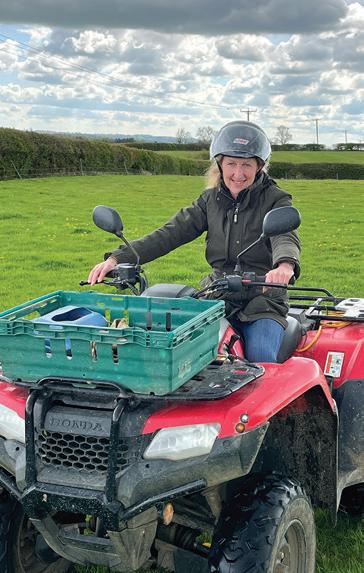
Commenting, Jill Hewitt, NAAC Chief Executive, said, ‘We are delighted that Doble Motorcycles has taken the initiative to make everyone
safer. In the last five years, ATVs were involved in 14 deaths in agriculture- the most significant cause of deaths involving moving vehicles in our industry. There is a need to take positive action to help prevent such incidents, and Dobles is being proactive to try and save lives.’
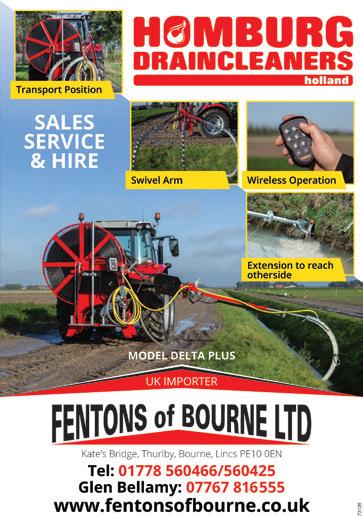
We need a shift in attitude to ensure that every time anyone gets on a sit-astride ATV, they automatically put a helmet on. Doble’s action will help remove any excuses.
Philip Stewart, Doble Motorcycles said, ‘We are honoured to unite with the NAAC’s #WearItandShareIt initiative, advocating for riders to wear helmets while riding ATVs. Honda ATVs represent a small part of the backbone of the agricultural sector, playing a pivotal role in day-to-day operations. However, the true heartbeat of the industry is the
individuals who are riding the machines and we want them to be safe while carrying out their vital work. We encourage every rider to make sure they are fully trained in how to operate these fantastic machines, and furthermore we are delighted to offer a high-quality helmet with every purchase of a new Honda ATV. Both the ATV and helmet can be delivered nationwide and we hope that anyone interested in this offer or Honda ATVs in general, will get in touch through our website, social media channels or come directly to us in Coulsdon, Surrey.’
Of course, simply wearing a helmet will not keep everyone fully protected and it is vitally important to ensure that anyone riding an ATV is competent and trained to handle the machine. Training is crucial because it covers essential active riding techniques necessary for the safe operation of the ATV.
machinery www.farmingscotlandmagazine.com 108
us at Croptec 2022 23rd & 24th November STAND 2326
See













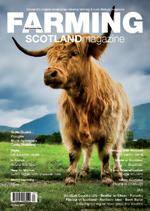
Proud to support Scottish farming, and agriculture throughout the five nations Your ‘collectable’ magazine Keep each issue build your ‘annual set’ and... RELEASE THE LION! Build your own ‘reference’ library of FARMING SCOTLAND MAGAZINE with our new ‘collectable library’ editions To subscribe please call us directly on 01738 639747 or visit: www.farmingscotlandmagazine.com SUBSCRIBE NOW Get your very own copy delivered to your door. Also makes an ideal gift. Only £28.50 a year FARMING SCOTLAND MAGAZINE
More support for crofters Improving energy efficiency of croft homes
Scotland’s crofters will get help with high energy costs through new grant funding to improve the energy efficiency of their homes.
Through an extension to the Scottish Government’s Croft House Grant, crofters can now apply for grants of up to £38,000 towards the costs of home improvements which will help them save energy - such as loft or wall insulation, new zero direct emissions heating systems or upgraded windows and doors.
The grant scheme supports crofters to improve their homes,
or build new homes - allowing them to maximise the full potential of their crofts and to retain and attract people to remote and rural communities.
Over the past year, the Scottish Government has awarded over £1 million in grant funding to help crofters across Scotland build and improve their homes.
Minister for Energy and the Environment Gillian Martin said:
“The climate emergency and energy crisis has highlighted the need for energy efficiency improvements to existing
housing stocks. There are approximately 21,400 crofts in Scotland, and many of these have existing houses which have not been built to the high energy efficiency standards required today.
“Crofting plays such an important part in the longterm sustainability of our rural and island areas. And crofters in remote and rural areas are disproportionately affected by high energy costs and the cost of living. Until now the UK Government has provided no
targeted to these households and businesses, who need it the most.
“At a time when costs are rising, I hope that the introduction of energy efficiency measures to the Croft House Grant will help support people to continue to live and work in these remote and often fragile communities.
“This government has a track record of investing to improve croft housing. Since January 2007, over £24.4 million in Croft House Grant payments have helped to build and improve over 1,100 croft homes.”
Farming’s stormy year and the forecast is not much better!
This is the message from Brian Richardson UK Head of Agriculture for Virgin Money.
“There are always plenty of challenges facing farmers, and while the sector constantly proves resilient, the last 18 months have thrown up a barrage of extraordinary problems for farmers and landowners to deal with.
The clarity we hoped for on farm policy post Brexit has been slow to emerge. In Scotland, policy remains largely unchanged but farmers are scratching their heads at the uncertainty of what is coming and finding it hard to plan ahead and make long term decisions.

At the same time, the farming sector has been faced with unprecedented inflation in costs, creating yet more uncertainty and worry. Farmers have been working hard to offset the effects where they can and have been predictably innovative in minimising the effects of these increases and avoiding any unnecessary expense. That said,
there is only so much farmers can do and this year will see the full effect of these costs hit home. With potentially lower output prices in several sectors, profitability will inevitably come under pressure. Finance costs also affect farmers significantly, and the continued increases in Bank Base Rate, reaching 5% in June, will be another cost many farmers were not expecting. Some of those with loans will have some protection in the form of interest rate hedging, but many rely on overdrafts to finance their variable working capital requirements and this money has certainly become more expensive.
Many suppliers are tightening credit terms and equipment lease costs are increasing alongside the higher cost of the equipment being purchased. It is the perfect storm on the costs side, thankfully offset to some degree for many sectors by higher output prices, but these are now under pressure.
Finance is an important part of any farm business, both in
www.farmingscotlandmagazine.com 110 finance
being able to pay the bills but also in supporting the longer term investment made even more important by the fundamental changes to support arrangements – and not forgetting the Carbon Net Zero challenge which farmers are beginning to understand and address.
Bank of England figures show the farming sector total borrowing has reduced by 4% over the last 18 months. Better profitability has helped to enable this but it also signals a slowing of investment, with timescales being extended for building projects and longer delivery timelines for new equipment. There has also been less farmland coming to market, and some of it has not required new borrowing to finance it.
So what can farmers do to plan their way through the onslaught of challenges, and make sure they have adequate finance to run their business and
make the necessary investments for the future?
• Planning is more important then ever, not just for a year ahead but looking beyond that, particularly where investment is concerned. Make sure those involved in the business have taken time to consider the implications of the changes we are seeing and talk it through with your trusted professional advisor. There are grants available for farm business reviews to support this process.

• Budgeting is important, but make sure that includes cash flows as well. Perhaps look at a three year period for your business and incorporate any changes to support arrangements. Be realistic with inputs in your figures. Where you have perhaps enjoyed some advantageous
payment terms with suppliers, make sure these will still be available in the future.
• If you are looking at longer term investments, make sure you build into your numbers and rationale the higher cost of finance, and ensure the
payback will still cover the higher costs.
• Talk through at an early stage what you are doing with your Bank Managers. They will support you in your decisionmaking and provide guidance on appropriate forms of finance.
finance www.farmingscotlandmagazine.com 111
FARMING SCOTLAND MAGAZINE Next issue out November 2023 Subscription page 109
The Scottish Smallholder Festival is on the move!
The 2023 Scottish Smallholder Festival will move to the Royal Highland Centre, signalling the importance of smallholding to the agricultural scene in Scotland.
The organisers of the festival, Smallholding Scotland, have signed a three-year deal with the Royal Highland Centre to run the event each year in October, with this year’s festival taking place on the 14th October 2023. The move has been made possible with the support of the Scottish Government.
She said: “The Scottish Government is committed to supporting smallholders and the role they can play in delivering our Vision for Agriculture and the sustainable production of
high quality food. The closure of Forfar Mart was a real blow to Scottish smallholders and rural communities on the east coastimpacting not only the farming community in that area, but also the wider rural economy”.
Now in its twelfth year, the Scottish Smallholder Festival is Scotland’s national smallholding show - a chance for small-scale producers and growers to come together at the end of the season to celebrate a successful year of production, and to gather ideas for next year. It also provides an opportunity for all to display their products and benchmark their success against other small producers.
The latest information, show schedules and entry forms can
all be found on the Scottish Smallholder Festival websitewww.festival.scot - which is now live.
Tickets for this years event, on Saturday 14th October, are also on sale now on the festival website.
More than £20,000 of prize money at English Winter Fair
More than £20,000 in prize money will be on offer at this year’s English Winter Fair, set to take place at the Staffordshire County Showground on 18 and 19 November.
The longstanding event, which celebrates its 175th anniversary next year, encompasses both the former Birmingham Fatstock Show and aspects of the historic Royal Smithfield Show – including the prestigious Duke of Norfolk perpetual trophy for best group of three pedigree cattle.
Bagshaws partner and auctioneer Mark Elliott, who has presided over the event’s concluding sale for nearly 30 years, describes the Winter Fair as the pinnacle of the pedigree, prime and fatstock show season.

“Many competitors who end up selling their animals in the

auction have been showing them all year across the country,” says Mr Elliott. “It’s an honour to see them compete at the Winter Fair against some tough opposition, then end up in your sale ring as their crescendo to the season.”
The quality of livestock at the fair, whether pig, sheep or cattle, has been consistently high, although with cattle in particular, the type of animal has changed over time, he adds. “We’re definitely looking at smaller frames these days. The 800kg steer of the past has fewer markets now, so we see this preference for smaller carcass weights reflected in the animals being shown in the ring, then making their way through for sale.”
Entries at the fair were understandably affected immediately after Covid struck,
but they have since bounced back, even exceeding 5,000 visitors last year. “People really enjoy the chance to buy and sell at this very special event, as well as coming to compete and spectate,” explains Mr Elliott.
Entries for the English Winter Fair will open from September, with forms available on the Staffordshire County Showground website, www.staffscountyshowground. co.uk.
www.farmingscotlandmagazine.com 112 events
Hutton brings international phosphorus event to Dundee
A biennial international event focused on one of the essential nutrients for crop production and land management is to be held in Dundee next year.

The International Phosphorus Workshop (IPW10), organised by researchers at The James Hutton Institute in Aberdeen with support from Dundee & Angus Convention Bureau, will help experts to share knowledge, discuss research findings, and exchange ideas on various aspects of phosphorus – a nutrient that supports all life on earth.
That includes sharing scientific knowledge of phosphorus processes, environmental impacts and
sustainable solutions for its the effective management of this finite resource.
It is the first time the event, which attracts scientists, researchers, industry professionals, and policymakers from around the world, has been held in Scotland.
The event will be held over five days, from 26 August 2024, at the University of Dundee’s Dalhousie venue. About 200 international delegates and an estimated £450,000 in direct economic impact are expected to be generated by IPW10.
IPW10 organiser, Professor Marc Sutter, a senior scientist at The James Hutton Institute,
says, “Phosphorus is an essential element for health and agriculture but has complex interacting social and environmental issues. Price fluctuations, volatile access to global reserves and environmental contamination constantly bring phosphorus into focus and challenge its science and management.
“Phosphorus escapes the food system and pollutes rivers as sewage, fertilisers remain desperately needed in some developing countries, yet overapplied in many countries, where phosphorus losses drive freshwater algal blooms.
“This workshop will allow scientists, policy and industry
from around the world to discuss environmental phosphorus processes in a catchment context, considering systems of land management, people, soils and waters together.”
FARMING SCOTLAND MAGAZINE
Next issue out
November 2023
Subscription page 109
www.farmingscotlandmagazine.com 113 events
PEOPLE ON THE MOVE

Chris Embleton
Yamaha has recruited Chris Embleton as the new Area Sales Manager for Northern England and Scotland. Mr Embleton has joined Yamaha from Europe’s largest golf retailer, American Golf, and will work with the brand’s dealer network to manage a portfolio of ATV, side-by-side, golf cars and other lightweight utility vehicles. Commenting on his new role
Mr Embleton said “Joining Yamaha is a great opportunity to work with an excellent dealer network and portfolio of products. I have been an end user of recreational and utility vehicles for many years, so to join a leading brand and work throughout the north is a perfect fit for me.”
Mark Lloyd
The UK’s leading manufacturer of vegetable and materials handling equipment, Haith Group, has added 40 years of manufacturing experience to its board with the appointment of Mark Lloyd as the company’s first-ever nonexecutive director.

Haith Group appointed Mr Lloyd last month to support the company’s senior management team, led by managing director Duane Hill.
“Mark fits the bill perfectly. He has enjoyed a long and successful career and has a strong track record of delivering business growth and increased efficiency wherever he has worked. He has a wealth of experience, having worked across production operations for several manufacturing businesses and has established and developed his own successful business.
Robert Venner
The National Beef Association is delighted to confirm the appointment of Robert Venner as the new Chair of the only organisation representing the interests of British beef farmers.

Current Chair of the NBA SW region and a recent Member of the AHDB Beef and Lamb Council, Robert comes to his new role with a track record of effective action on the industry’s behalf. He also brings an agenda to tackle some of the industries thorniest issues, including the development of postBrexit export markets and Red Tractor quality assurance.
A farmer’s son who remembers many happy days showing at the Royal, Robert Venner still keeps a “handful” of pedigree Aberdeen Angus on his Woodington Farm in Devon, but his career in the livestock industry has centred on the auction ring.
Paul O’Hora
Yara UK welcomes Paul O’Hora, who joins the company as Senior Project Portfoli Manager OMF. As part of his role, Paul will manage organomineral fertiliser (OMF) development in the UK as well as building relationships with key partners. A chemist by trade, Paul has over 10 years’ experience of working in R&D as well as project and product development for specialty chemical company Lubrizol.


As Senior Project Portfolio Manager-OMF, Paul will be responsible for developing partnerships with partners like waste management companies which are crucial to the success of the new OMF project. He’ll also be involved in the development of a pilot plant which will produce materials for trials in the UK, as well as managing and directing the production of the final commercial product.
THE BOOK SHELF
War Path
by Alistair Moffat
Alistair Moffat is a prolific Scottish author known for venturing out and experiencing, rather than simply studying and recounting, Scottish history. He has been given the nickname of ‘scholarly hiker’ for the unique way in which he combines historical documentation and exploring the beautiful, expansive landscapes Scotland has to offer on foot. In his new book, War Paths: Walking in the Shadows of the Clans, Moffat sets out to traverse the most significant battlefields and war territories of Scotland’s most iconic clans. Moffat brings his signature thoughtful yet pragmatic approach to Scottish history and the influence of place on a nation as he examines the disputes, reputations, and pivotal moments in clan history as they have never been seen before.
The 17th and 18th centuries were rife with conflict in Scotland, and Moffat’s book focuses on the battles which took place during these centuries. Most of the locations he visits are in the Highlands, in sparsely populated regions, where he can walk in the footsteps of clan soldiers fighting for land, freedom, and the right to their own ways of life. Many clan battles have been memorialised in Gaelic poetry and song, and you can feel the power in these memories as depicted by Moffat. He marvels at how clan militia fought and held their own against armies with more sophisticated weapons, using blades against guns and canon fire. Moffat is particularly moved by a lingering presence in these places, the ghosts of warriors
all around him, as he learns this history from the land itself.
War Paths covers several lesser-known battles while also offering a fresh perspective on the more familiar clashes in Scottish history. Moffat offers a brilliant account of Culloden, perhaps the most recognised battle in Scottish history, which had disastrous implications on Highland culture and marked the end of clan life as it was at the time. Moffat writes of this moment in history with reverence for the clan warriors and the courage they displayed at this last stand. Even if you are particularly well-read on Scottish military history, Moffat’s War Paths offers a new way of looking at these impactful moments in time, marked by their bravery, bloodshed, and rebellious spirit that lives on today. War Paths is enlightening and will transport you both back in time and to the significant places in clan history. Perhaps the book will even inspire you to plan your own trip to Scotland’s most eminent battlefields.
War Paths: Walking in the Shadows of the Clans by Alistair Moffat, published by Birlinn, August 2023 (£18.99, hardback) www.birlinn.co.uk

107 www.farmingscotlandmagazine.com























































































































































 By Zach Reilly, Senior Agricultural Consultant, SAC Consulting
By Zach Reilly, Senior Agricultural Consultant, SAC Consulting

 By Dr. Sagi Katz, VP Agronomy at Agmatix
By Dr. Sagi Katz, VP Agronomy at Agmatix




































 Photograph © Wendy Barrie
Photograph © Wendy Barrie































































